Predictive Analytics and Prescriptive Models
VerifiedAdded on 2021/05/06
|53
|11984
|118
AI Summary
This assignment delves into the world of predictive analytics and prescriptive models, exploring their applications in various industries. Geospatial data plays a crucial role in developing initial models, which can be used for revenue estimation, customer targeting, and optimizing business processes. A case study from Bangladesh's agriculture sector illustrates the potential benefits of these techniques in improving decision-making and resource allocation.
Contribute Materials
Your contribution can guide someone’s learning journey. Share your
documents today.
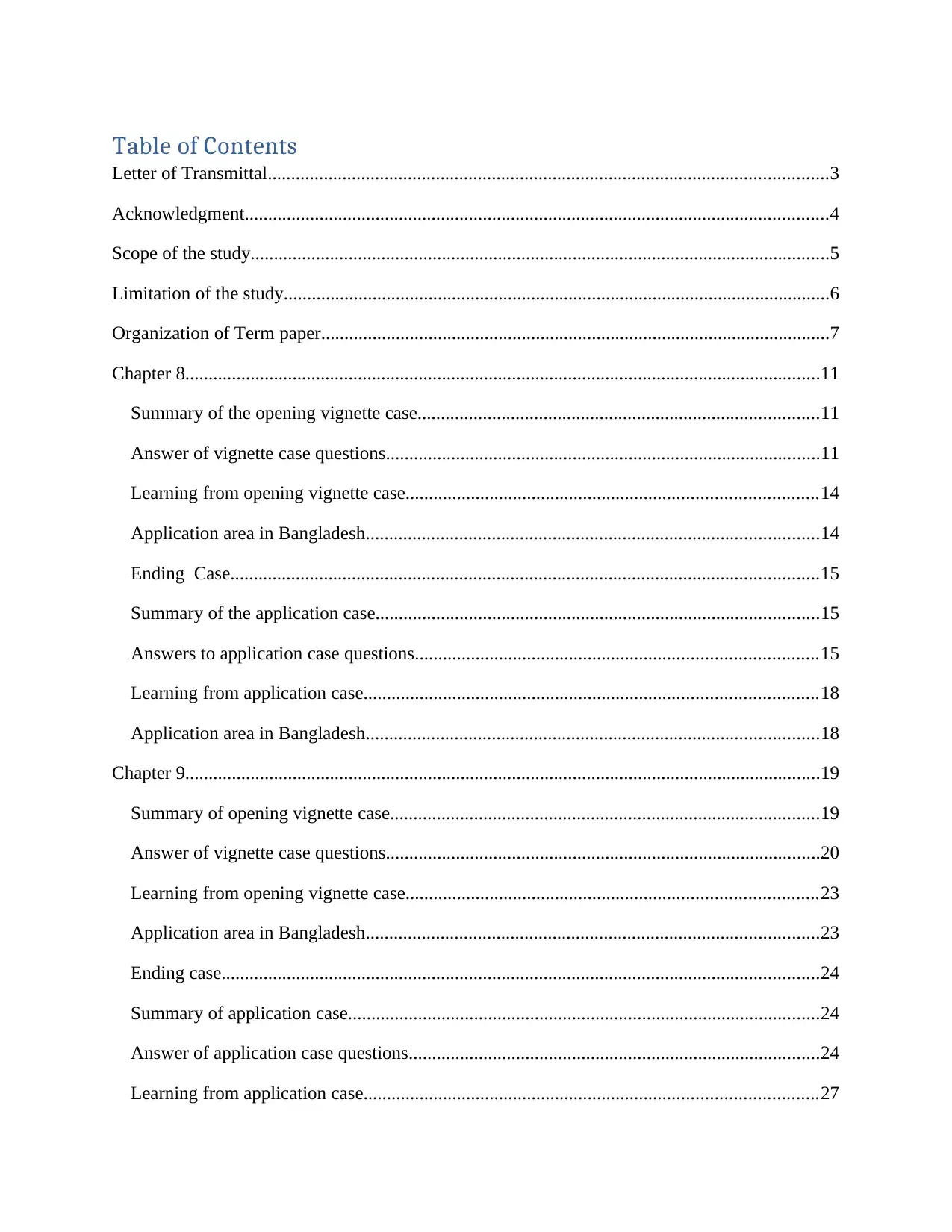
Table of Contents
Letter of Transmittal........................................................................................................................3
Acknowledgment.............................................................................................................................4
Scope of the study............................................................................................................................5
Limitation of the study.....................................................................................................................6
Organization of Term paper.............................................................................................................7
Chapter 8........................................................................................................................................11
Summary of the opening vignette case......................................................................................11
Answer of vignette case questions.............................................................................................11
Learning from opening vignette case........................................................................................14
Application area in Bangladesh.................................................................................................14
Ending Case..............................................................................................................................15
Summary of the application case...............................................................................................15
Answers to application case questions......................................................................................15
Learning from application case.................................................................................................18
Application area in Bangladesh.................................................................................................18
Chapter 9........................................................................................................................................19
Summary of opening vignette case............................................................................................19
Answer of vignette case questions.............................................................................................20
Learning from opening vignette case........................................................................................23
Application area in Bangladesh.................................................................................................23
Ending case................................................................................................................................24
Summary of application case.....................................................................................................24
Answer of application case questions........................................................................................24
Learning from application case.................................................................................................27
Letter of Transmittal........................................................................................................................3
Acknowledgment.............................................................................................................................4
Scope of the study............................................................................................................................5
Limitation of the study.....................................................................................................................6
Organization of Term paper.............................................................................................................7
Chapter 8........................................................................................................................................11
Summary of the opening vignette case......................................................................................11
Answer of vignette case questions.............................................................................................11
Learning from opening vignette case........................................................................................14
Application area in Bangladesh.................................................................................................14
Ending Case..............................................................................................................................15
Summary of the application case...............................................................................................15
Answers to application case questions......................................................................................15
Learning from application case.................................................................................................18
Application area in Bangladesh.................................................................................................18
Chapter 9........................................................................................................................................19
Summary of opening vignette case............................................................................................19
Answer of vignette case questions.............................................................................................20
Learning from opening vignette case........................................................................................23
Application area in Bangladesh.................................................................................................23
Ending case................................................................................................................................24
Summary of application case.....................................................................................................24
Answer of application case questions........................................................................................24
Learning from application case.................................................................................................27
Secure Best Marks with AI Grader
Need help grading? Try our AI Grader for instant feedback on your assignments.
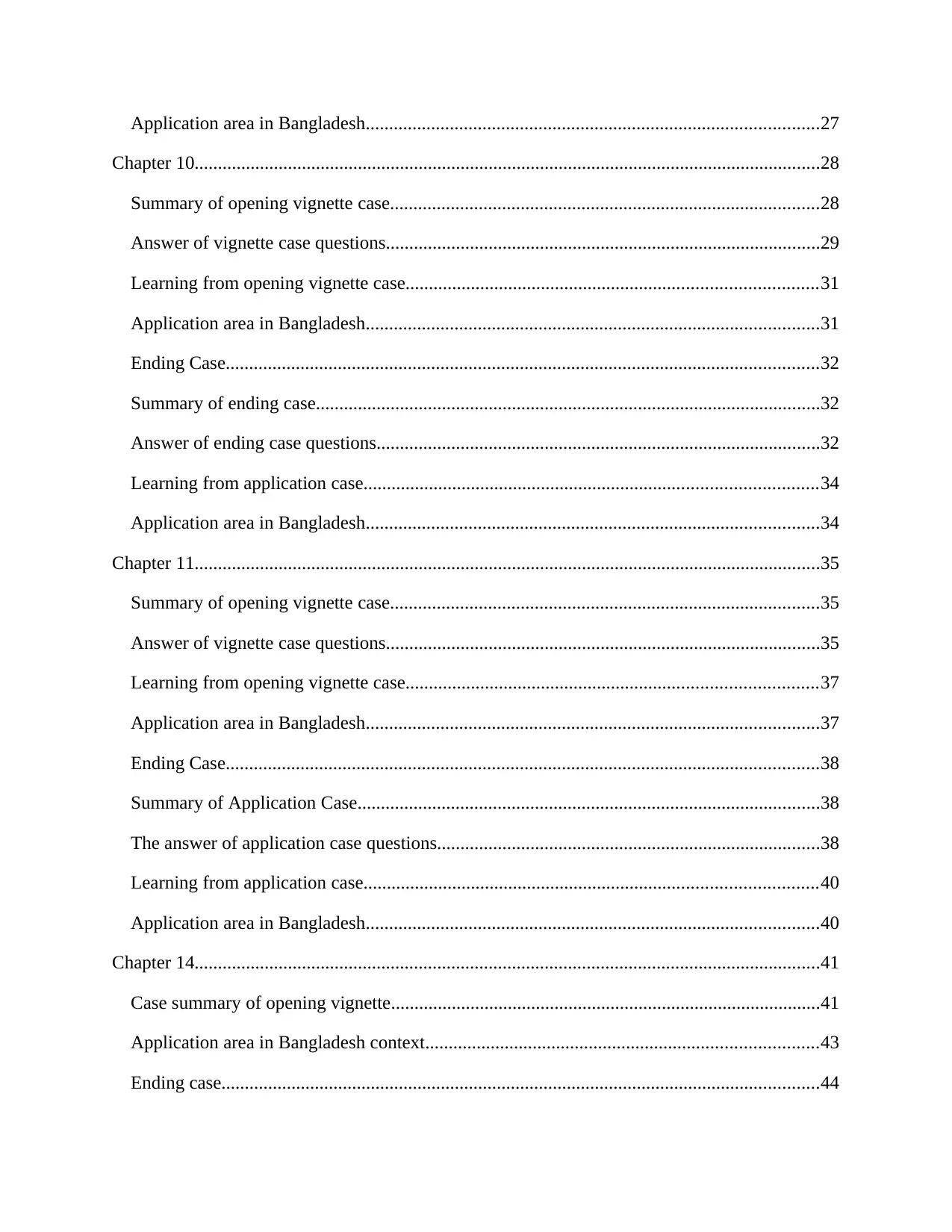
Application area in Bangladesh.................................................................................................27
Chapter 10......................................................................................................................................28
Summary of opening vignette case............................................................................................28
Answer of vignette case questions.............................................................................................29
Learning from opening vignette case........................................................................................31
Application area in Bangladesh.................................................................................................31
Ending Case...............................................................................................................................32
Summary of ending case............................................................................................................32
Answer of ending case questions...............................................................................................32
Learning from application case.................................................................................................34
Application area in Bangladesh.................................................................................................34
Chapter 11......................................................................................................................................35
Summary of opening vignette case............................................................................................35
Answer of vignette case questions.............................................................................................35
Learning from opening vignette case........................................................................................37
Application area in Bangladesh.................................................................................................37
Ending Case...............................................................................................................................38
Summary of Application Case...................................................................................................38
The answer of application case questions..................................................................................38
Learning from application case.................................................................................................40
Application area in Bangladesh.................................................................................................40
Chapter 14......................................................................................................................................41
Case summary of opening vignette............................................................................................41
Application area in Bangladesh context....................................................................................43
Ending case................................................................................................................................44
Chapter 10......................................................................................................................................28
Summary of opening vignette case............................................................................................28
Answer of vignette case questions.............................................................................................29
Learning from opening vignette case........................................................................................31
Application area in Bangladesh.................................................................................................31
Ending Case...............................................................................................................................32
Summary of ending case............................................................................................................32
Answer of ending case questions...............................................................................................32
Learning from application case.................................................................................................34
Application area in Bangladesh.................................................................................................34
Chapter 11......................................................................................................................................35
Summary of opening vignette case............................................................................................35
Answer of vignette case questions.............................................................................................35
Learning from opening vignette case........................................................................................37
Application area in Bangladesh.................................................................................................37
Ending Case...............................................................................................................................38
Summary of Application Case...................................................................................................38
The answer of application case questions..................................................................................38
Learning from application case.................................................................................................40
Application area in Bangladesh.................................................................................................40
Chapter 14......................................................................................................................................41
Case summary of opening vignette............................................................................................41
Application area in Bangladesh context....................................................................................43
Ending case................................................................................................................................44

Summary of application case.....................................................................................................44
Answer of application case questions........................................................................................44
Learning from application case.................................................................................................46
Application area in Bangladesh.................................................................................................46
References......................................................................................................................................48
Answer of application case questions........................................................................................44
Learning from application case.................................................................................................46
Application area in Bangladesh.................................................................................................46
References......................................................................................................................................48
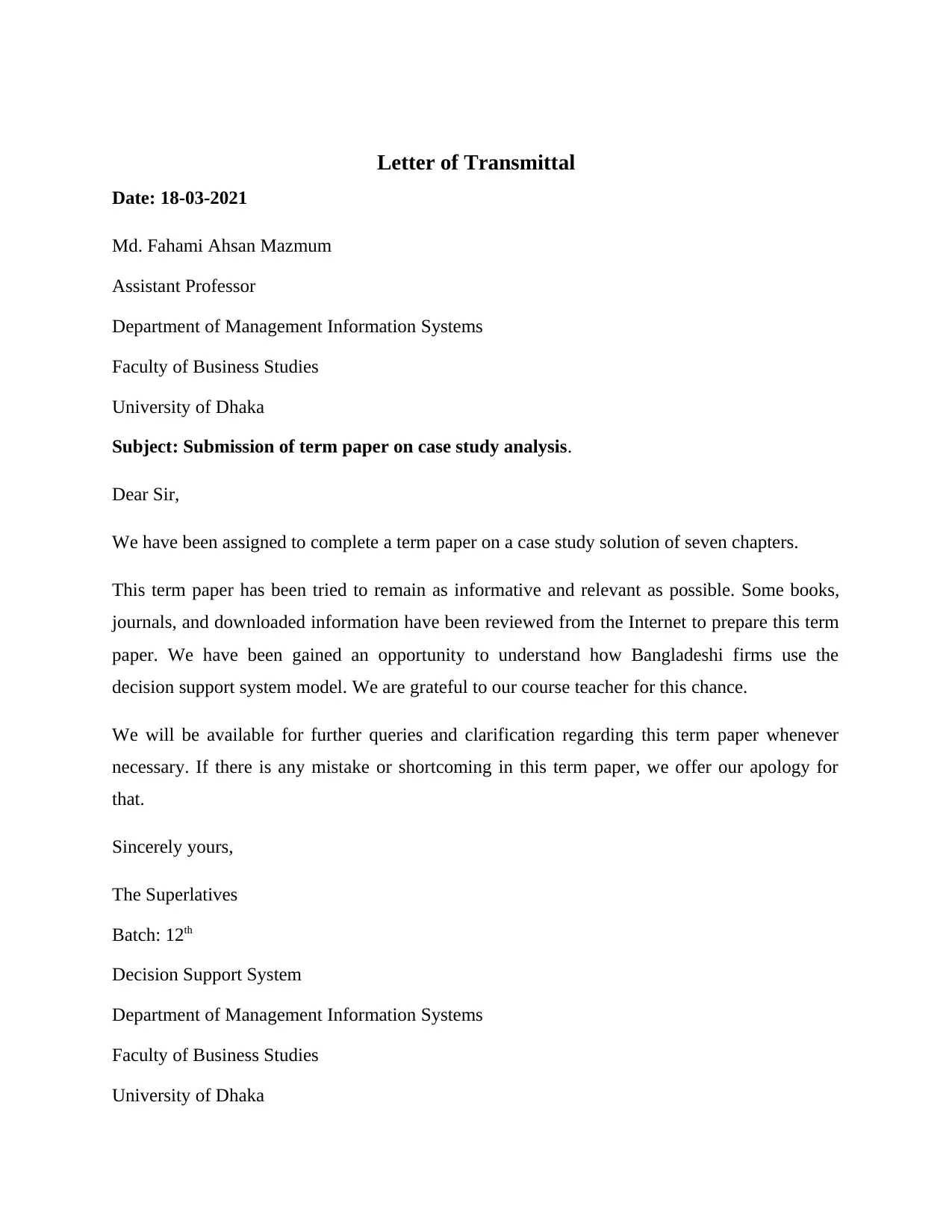
Letter of Transmittal
Date: 18-03-2021
Md. Fahami Ahsan Mazmum
Assistant Professor
Department of Management Information Systems
Faculty of Business Studies
University of Dhaka
Subject: Submission of term paper on case study analysis.
Dear Sir,
We have been assigned to complete a term paper on a case study solution of seven chapters.
This term paper has been tried to remain as informative and relevant as possible. Some books,
journals, and downloaded information have been reviewed from the Internet to prepare this term
paper. We have been gained an opportunity to understand how Bangladeshi firms use the
decision support system model. We are grateful to our course teacher for this chance.
We will be available for further queries and clarification regarding this term paper whenever
necessary. If there is any mistake or shortcoming in this term paper, we offer our apology for
that.
Sincerely yours,
The Superlatives
Batch: 12th
Decision Support System
Department of Management Information Systems
Faculty of Business Studies
University of Dhaka
Date: 18-03-2021
Md. Fahami Ahsan Mazmum
Assistant Professor
Department of Management Information Systems
Faculty of Business Studies
University of Dhaka
Subject: Submission of term paper on case study analysis.
Dear Sir,
We have been assigned to complete a term paper on a case study solution of seven chapters.
This term paper has been tried to remain as informative and relevant as possible. Some books,
journals, and downloaded information have been reviewed from the Internet to prepare this term
paper. We have been gained an opportunity to understand how Bangladeshi firms use the
decision support system model. We are grateful to our course teacher for this chance.
We will be available for further queries and clarification regarding this term paper whenever
necessary. If there is any mistake or shortcoming in this term paper, we offer our apology for
that.
Sincerely yours,
The Superlatives
Batch: 12th
Decision Support System
Department of Management Information Systems
Faculty of Business Studies
University of Dhaka
Secure Best Marks with AI Grader
Need help grading? Try our AI Grader for instant feedback on your assignments.
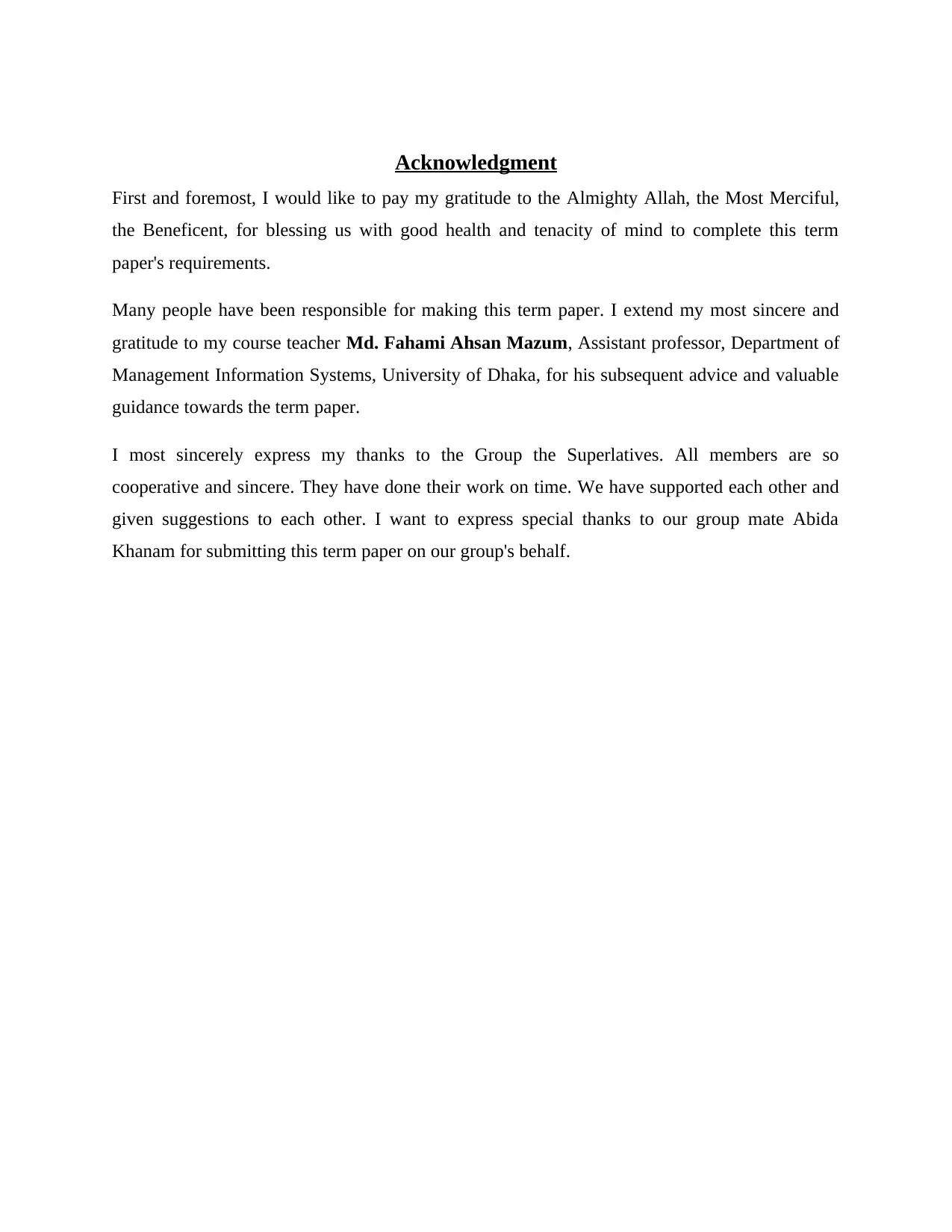
Acknowledgment
First and foremost, I would like to pay my gratitude to the Almighty Allah, the Most Merciful,
the Beneficent, for blessing us with good health and tenacity of mind to complete this term
paper's requirements.
Many people have been responsible for making this term paper. I extend my most sincere and
gratitude to my course teacher Md. Fahami Ahsan Mazum, Assistant professor, Department of
Management Information Systems, University of Dhaka, for his subsequent advice and valuable
guidance towards the term paper.
I most sincerely express my thanks to the Group the Superlatives. All members are so
cooperative and sincere. They have done their work on time. We have supported each other and
given suggestions to each other. I want to express special thanks to our group mate Abida
Khanam for submitting this term paper on our group's behalf.
First and foremost, I would like to pay my gratitude to the Almighty Allah, the Most Merciful,
the Beneficent, for blessing us with good health and tenacity of mind to complete this term
paper's requirements.
Many people have been responsible for making this term paper. I extend my most sincere and
gratitude to my course teacher Md. Fahami Ahsan Mazum, Assistant professor, Department of
Management Information Systems, University of Dhaka, for his subsequent advice and valuable
guidance towards the term paper.
I most sincerely express my thanks to the Group the Superlatives. All members are so
cooperative and sincere. They have done their work on time. We have supported each other and
given suggestions to each other. I want to express special thanks to our group mate Abida
Khanam for submitting this term paper on our group's behalf.
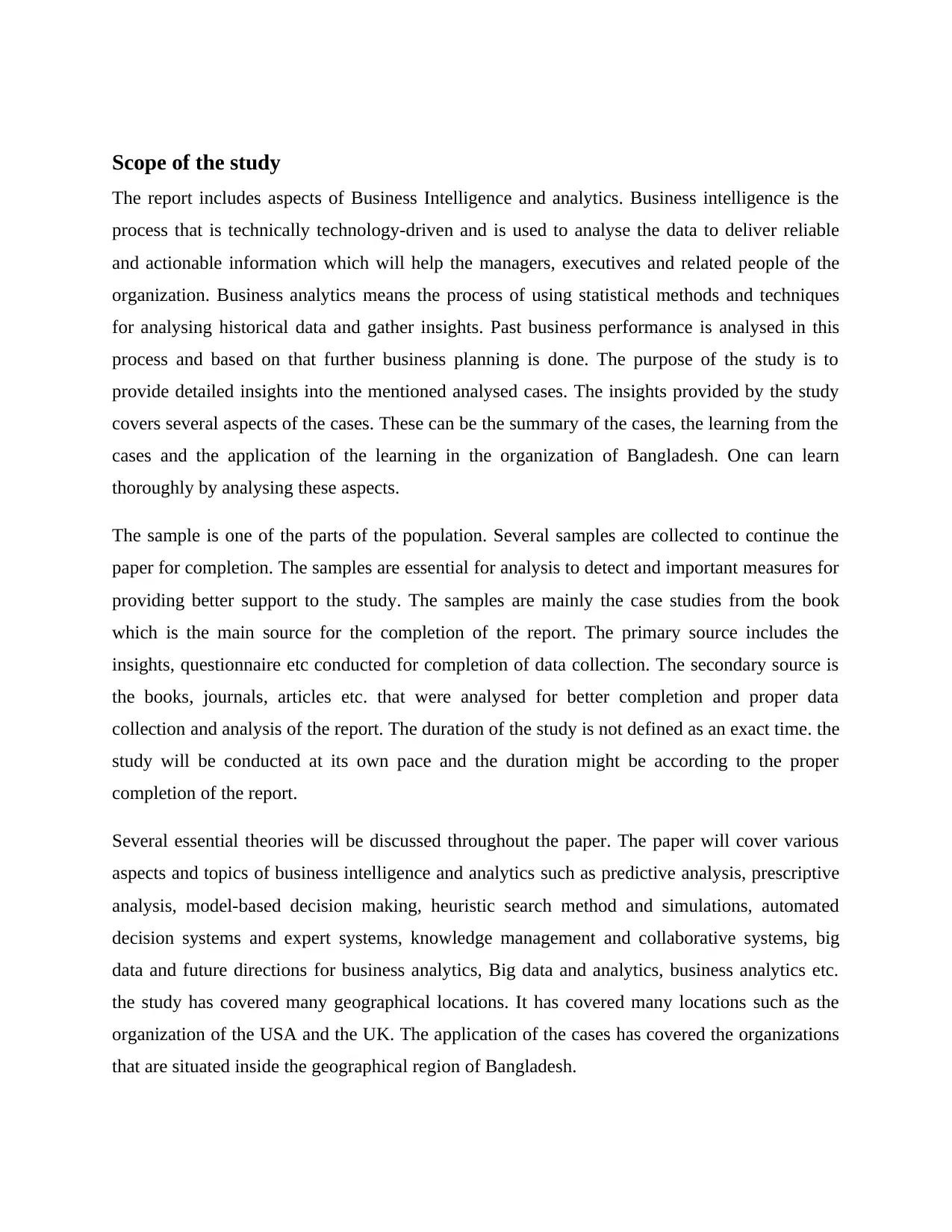
Scope of the study
The report includes aspects of Business Intelligence and analytics. Business intelligence is the
process that is technically technology-driven and is used to analyse the data to deliver reliable
and actionable information which will help the managers, executives and related people of the
organization. Business analytics means the process of using statistical methods and techniques
for analysing historical data and gather insights. Past business performance is analysed in this
process and based on that further business planning is done. The purpose of the study is to
provide detailed insights into the mentioned analysed cases. The insights provided by the study
covers several aspects of the cases. These can be the summary of the cases, the learning from the
cases and the application of the learning in the organization of Bangladesh. One can learn
thoroughly by analysing these aspects.
The sample is one of the parts of the population. Several samples are collected to continue the
paper for completion. The samples are essential for analysis to detect and important measures for
providing better support to the study. The samples are mainly the case studies from the book
which is the main source for the completion of the report. The primary source includes the
insights, questionnaire etc conducted for completion of data collection. The secondary source is
the books, journals, articles etc. that were analysed for better completion and proper data
collection and analysis of the report. The duration of the study is not defined as an exact time. the
study will be conducted at its own pace and the duration might be according to the proper
completion of the report.
Several essential theories will be discussed throughout the paper. The paper will cover various
aspects and topics of business intelligence and analytics such as predictive analysis, prescriptive
analysis, model-based decision making, heuristic search method and simulations, automated
decision systems and expert systems, knowledge management and collaborative systems, big
data and future directions for business analytics, Big data and analytics, business analytics etc.
the study has covered many geographical locations. It has covered many locations such as the
organization of the USA and the UK. The application of the cases has covered the organizations
that are situated inside the geographical region of Bangladesh.
The report includes aspects of Business Intelligence and analytics. Business intelligence is the
process that is technically technology-driven and is used to analyse the data to deliver reliable
and actionable information which will help the managers, executives and related people of the
organization. Business analytics means the process of using statistical methods and techniques
for analysing historical data and gather insights. Past business performance is analysed in this
process and based on that further business planning is done. The purpose of the study is to
provide detailed insights into the mentioned analysed cases. The insights provided by the study
covers several aspects of the cases. These can be the summary of the cases, the learning from the
cases and the application of the learning in the organization of Bangladesh. One can learn
thoroughly by analysing these aspects.
The sample is one of the parts of the population. Several samples are collected to continue the
paper for completion. The samples are essential for analysis to detect and important measures for
providing better support to the study. The samples are mainly the case studies from the book
which is the main source for the completion of the report. The primary source includes the
insights, questionnaire etc conducted for completion of data collection. The secondary source is
the books, journals, articles etc. that were analysed for better completion and proper data
collection and analysis of the report. The duration of the study is not defined as an exact time. the
study will be conducted at its own pace and the duration might be according to the proper
completion of the report.
Several essential theories will be discussed throughout the paper. The paper will cover various
aspects and topics of business intelligence and analytics such as predictive analysis, prescriptive
analysis, model-based decision making, heuristic search method and simulations, automated
decision systems and expert systems, knowledge management and collaborative systems, big
data and future directions for business analytics, Big data and analytics, business analytics etc.
the study has covered many geographical locations. It has covered many locations such as the
organization of the USA and the UK. The application of the cases has covered the organizations
that are situated inside the geographical region of Bangladesh.

Paraphrase This Document
Need a fresh take? Get an instant paraphrase of this document with our AI Paraphraser
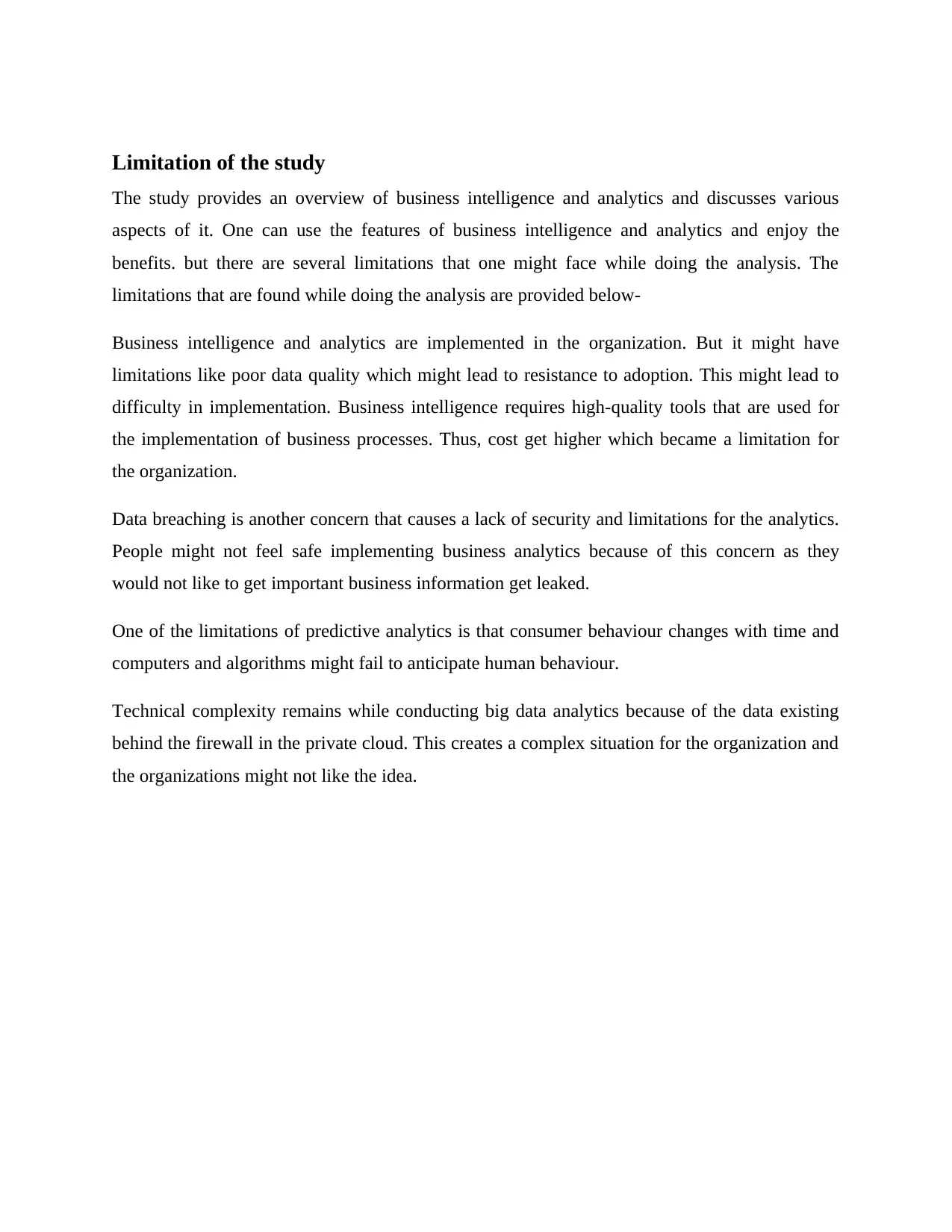
Limitation of the study
The study provides an overview of business intelligence and analytics and discusses various
aspects of it. One can use the features of business intelligence and analytics and enjoy the
benefits. but there are several limitations that one might face while doing the analysis. The
limitations that are found while doing the analysis are provided below-
Business intelligence and analytics are implemented in the organization. But it might have
limitations like poor data quality which might lead to resistance to adoption. This might lead to
difficulty in implementation. Business intelligence requires high-quality tools that are used for
the implementation of business processes. Thus, cost get higher which became a limitation for
the organization.
Data breaching is another concern that causes a lack of security and limitations for the analytics.
People might not feel safe implementing business analytics because of this concern as they
would not like to get important business information get leaked.
One of the limitations of predictive analytics is that consumer behaviour changes with time and
computers and algorithms might fail to anticipate human behaviour.
Technical complexity remains while conducting big data analytics because of the data existing
behind the firewall in the private cloud. This creates a complex situation for the organization and
the organizations might not like the idea.
The study provides an overview of business intelligence and analytics and discusses various
aspects of it. One can use the features of business intelligence and analytics and enjoy the
benefits. but there are several limitations that one might face while doing the analysis. The
limitations that are found while doing the analysis are provided below-
Business intelligence and analytics are implemented in the organization. But it might have
limitations like poor data quality which might lead to resistance to adoption. This might lead to
difficulty in implementation. Business intelligence requires high-quality tools that are used for
the implementation of business processes. Thus, cost get higher which became a limitation for
the organization.
Data breaching is another concern that causes a lack of security and limitations for the analytics.
People might not feel safe implementing business analytics because of this concern as they
would not like to get important business information get leaked.
One of the limitations of predictive analytics is that consumer behaviour changes with time and
computers and algorithms might fail to anticipate human behaviour.
Technical complexity remains while conducting big data analytics because of the data existing
behind the firewall in the private cloud. This creates a complex situation for the organization and
the organizations might not like the idea.
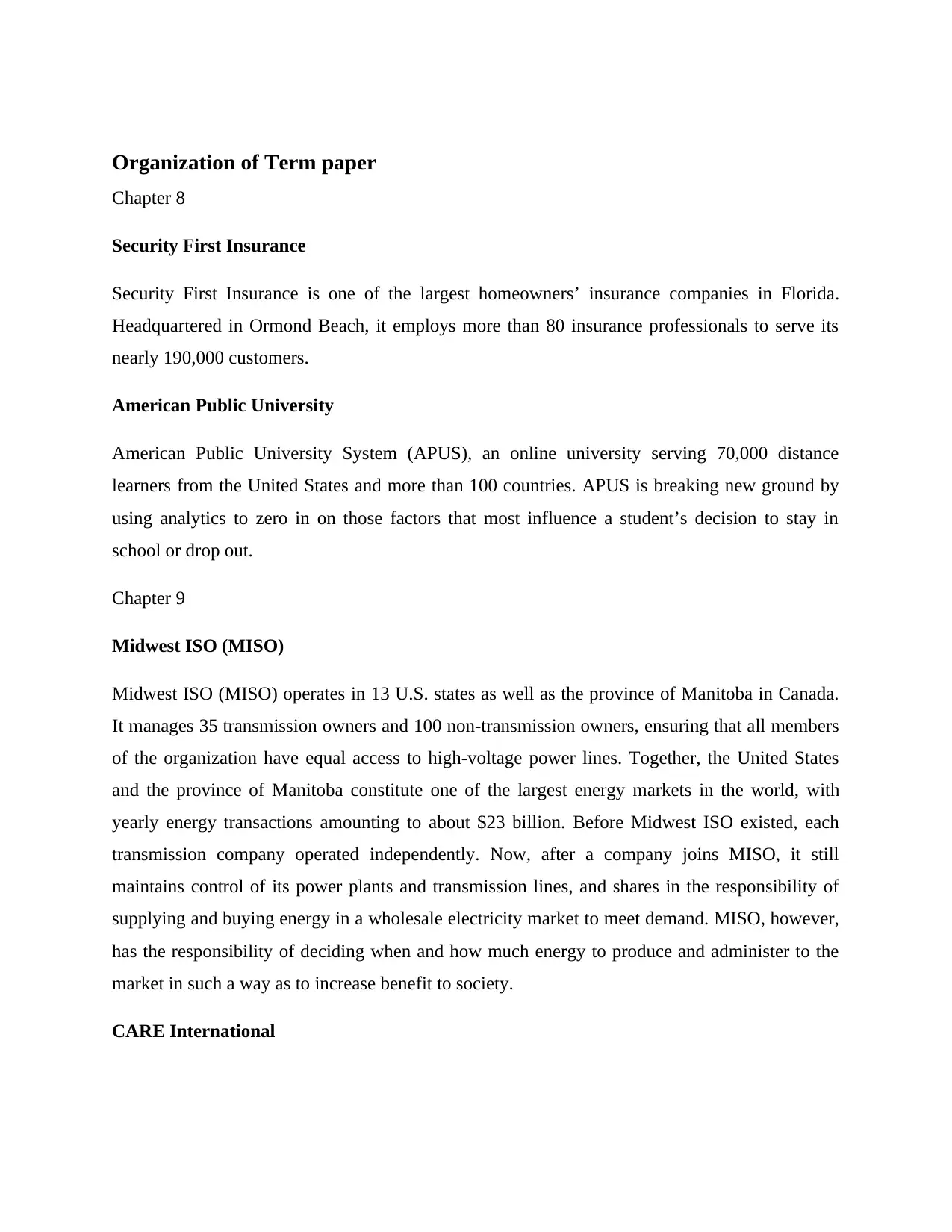
Organization of Term paper
Chapter 8
Security First Insurance
Security First Insurance is one of the largest homeowners’ insurance companies in Florida.
Headquartered in Ormond Beach, it employs more than 80 insurance professionals to serve its
nearly 190,000 customers.
American Public University
American Public University System (APUS), an online university serving 70,000 distance
learners from the United States and more than 100 countries. APUS is breaking new ground by
using analytics to zero in on those factors that most influence a student’s decision to stay in
school or drop out.
Chapter 9
Midwest ISO (MISO)
Midwest ISO (MISO) operates in 13 U.S. states as well as the province of Manitoba in Canada.
It manages 35 transmission owners and 100 non-transmission owners, ensuring that all members
of the organization have equal access to high-voltage power lines. Together, the United States
and the province of Manitoba constitute one of the largest energy markets in the world, with
yearly energy transactions amounting to about $23 billion. Before Midwest ISO existed, each
transmission company operated independently. Now, after a company joins MISO, it still
maintains control of its power plants and transmission lines, and shares in the responsibility of
supplying and buying energy in a wholesale electricity market to meet demand. MISO, however,
has the responsibility of deciding when and how much energy to produce and administer to the
market in such a way as to increase benefit to society.
CARE International
Chapter 8
Security First Insurance
Security First Insurance is one of the largest homeowners’ insurance companies in Florida.
Headquartered in Ormond Beach, it employs more than 80 insurance professionals to serve its
nearly 190,000 customers.
American Public University
American Public University System (APUS), an online university serving 70,000 distance
learners from the United States and more than 100 countries. APUS is breaking new ground by
using analytics to zero in on those factors that most influence a student’s decision to stay in
school or drop out.
Chapter 9
Midwest ISO (MISO)
Midwest ISO (MISO) operates in 13 U.S. states as well as the province of Manitoba in Canada.
It manages 35 transmission owners and 100 non-transmission owners, ensuring that all members
of the organization have equal access to high-voltage power lines. Together, the United States
and the province of Manitoba constitute one of the largest energy markets in the world, with
yearly energy transactions amounting to about $23 billion. Before Midwest ISO existed, each
transmission company operated independently. Now, after a company joins MISO, it still
maintains control of its power plants and transmission lines, and shares in the responsibility of
supplying and buying energy in a wholesale electricity market to meet demand. MISO, however,
has the responsibility of deciding when and how much energy to produce and administer to the
market in such a way as to increase benefit to society.
CARE International
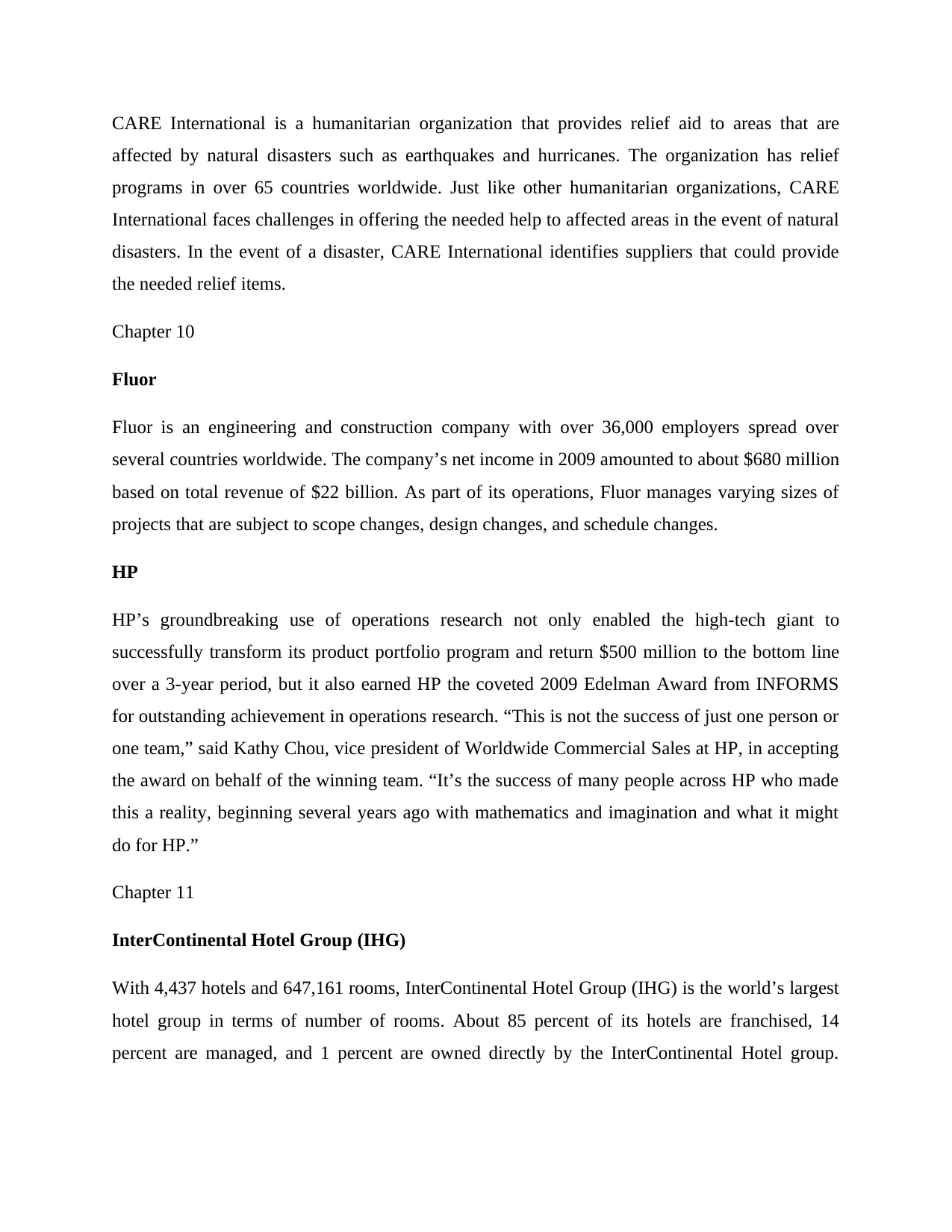
CARE International is a humanitarian organization that provides relief aid to areas that are
affected by natural disasters such as earthquakes and hurricanes. The organization has relief
programs in over 65 countries worldwide. Just like other humanitarian organizations, CARE
International faces challenges in offering the needed help to affected areas in the event of natural
disasters. In the event of a disaster, CARE International identifies suppliers that could provide
the needed relief items.
Chapter 10
Fluor
Fluor is an engineering and construction company with over 36,000 employers spread over
several countries worldwide. The company’s net income in 2009 amounted to about $680 million
based on total revenue of $22 billion. As part of its operations, Fluor manages varying sizes of
projects that are subject to scope changes, design changes, and schedule changes.
HP
HP’s groundbreaking use of operations research not only enabled the high-tech giant to
successfully transform its product portfolio program and return $500 million to the bottom line
over a 3-year period, but it also earned HP the coveted 2009 Edelman Award from INFORMS
for outstanding achievement in operations research. “This is not the success of just one person or
one team,” said Kathy Chou, vice president of Worldwide Commercial Sales at HP, in accepting
the award on behalf of the winning team. “It’s the success of many people across HP who made
this a reality, beginning several years ago with mathematics and imagination and what it might
do for HP.”
Chapter 11
InterContinental Hotel Group (IHG)
With 4,437 hotels and 647,161 rooms, InterContinental Hotel Group (IHG) is the world’s largest
hotel group in terms of number of rooms. About 85 percent of its hotels are franchised, 14
percent are managed, and 1 percent are owned directly by the InterContinental Hotel group.
affected by natural disasters such as earthquakes and hurricanes. The organization has relief
programs in over 65 countries worldwide. Just like other humanitarian organizations, CARE
International faces challenges in offering the needed help to affected areas in the event of natural
disasters. In the event of a disaster, CARE International identifies suppliers that could provide
the needed relief items.
Chapter 10
Fluor
Fluor is an engineering and construction company with over 36,000 employers spread over
several countries worldwide. The company’s net income in 2009 amounted to about $680 million
based on total revenue of $22 billion. As part of its operations, Fluor manages varying sizes of
projects that are subject to scope changes, design changes, and schedule changes.
HP
HP’s groundbreaking use of operations research not only enabled the high-tech giant to
successfully transform its product portfolio program and return $500 million to the bottom line
over a 3-year period, but it also earned HP the coveted 2009 Edelman Award from INFORMS
for outstanding achievement in operations research. “This is not the success of just one person or
one team,” said Kathy Chou, vice president of Worldwide Commercial Sales at HP, in accepting
the award on behalf of the winning team. “It’s the success of many people across HP who made
this a reality, beginning several years ago with mathematics and imagination and what it might
do for HP.”
Chapter 11
InterContinental Hotel Group (IHG)
With 4,437 hotels and 647,161 rooms, InterContinental Hotel Group (IHG) is the world’s largest
hotel group in terms of number of rooms. About 85 percent of its hotels are franchised, 14
percent are managed, and 1 percent are owned directly by the InterContinental Hotel group.
Secure Best Marks with AI Grader
Need help grading? Try our AI Grader for instant feedback on your assignments.

Some of the hotel brands that belong to this group are Holiday Inn, Holiday Express, Staybridge
Suites, and Crowne Plaza. Revenue generated from their rooms amounts to around $20 billion.
Department of Taxation and Finance’s Collections and Civil Enforcement Division (CCED)
Tax collection in the State of New York is under the mandate of the New York State Department
of Taxation and Finance’s Collections and Civil Enforcement Division (CCED). Between 1995
and 2005, CCED changed and improved on its operations in order to make tax collection more
efficient. Even though the division’s staff strength decreased from over 1,000 employees in 1995
to about 700 employees, its tax collection revenue increased from $500 million to over $1 billion
within the same period as a result of the improved systems and procedures they used.
Chapter 12
The expertise transfer system (ETS)
The expertise transfer system (ETS) is a knowledge transfer system developed by the Spears
School of Business at Oklahoma State University as a prototype for the Defense Ammunition
Center (DAC) in McAlester, Oklahoma, for use in Army ammunition career fields. The ETS is
designed to capture the knowledge of experienced ammunition personnel leaving the Army (i.e.,
retirements, separations, etc.) and those who have been recently deployed to the field. This
knowledge is captured on video, converted into units of actionable knowledge called “nuggets,”
and presented to the user in a number of learning-friendly views.
Digital forensics
Digital forensics has become an indispensable tool for law enforcement. This science is not only
applied to cases of crime committed with or against digital assets, but is used in many physical
crimes to gather evidence of intent or proof of prior relationships. The volume of digital devices
that might be explored by a forensic analysis, however, is staggering, including anything from a
home computer to a videogame console, to an engine module from a getaway vehicle. New
hardware, software, and applications are being released into public use daily, and analysts must
create new methods to deal with each of them.
Chapter 13
Suites, and Crowne Plaza. Revenue generated from their rooms amounts to around $20 billion.
Department of Taxation and Finance’s Collections and Civil Enforcement Division (CCED)
Tax collection in the State of New York is under the mandate of the New York State Department
of Taxation and Finance’s Collections and Civil Enforcement Division (CCED). Between 1995
and 2005, CCED changed and improved on its operations in order to make tax collection more
efficient. Even though the division’s staff strength decreased from over 1,000 employees in 1995
to about 700 employees, its tax collection revenue increased from $500 million to over $1 billion
within the same period as a result of the improved systems and procedures they used.
Chapter 12
The expertise transfer system (ETS)
The expertise transfer system (ETS) is a knowledge transfer system developed by the Spears
School of Business at Oklahoma State University as a prototype for the Defense Ammunition
Center (DAC) in McAlester, Oklahoma, for use in Army ammunition career fields. The ETS is
designed to capture the knowledge of experienced ammunition personnel leaving the Army (i.e.,
retirements, separations, etc.) and those who have been recently deployed to the field. This
knowledge is captured on video, converted into units of actionable knowledge called “nuggets,”
and presented to the user in a number of learning-friendly views.
Digital forensics
Digital forensics has become an indispensable tool for law enforcement. This science is not only
applied to cases of crime committed with or against digital assets, but is used in many physical
crimes to gather evidence of intent or proof of prior relationships. The volume of digital devices
that might be explored by a forensic analysis, however, is staggering, including anything from a
home computer to a videogame console, to an engine module from a getaway vehicle. New
hardware, software, and applications are being released into public use daily, and analysts must
create new methods to deal with each of them.
Chapter 13
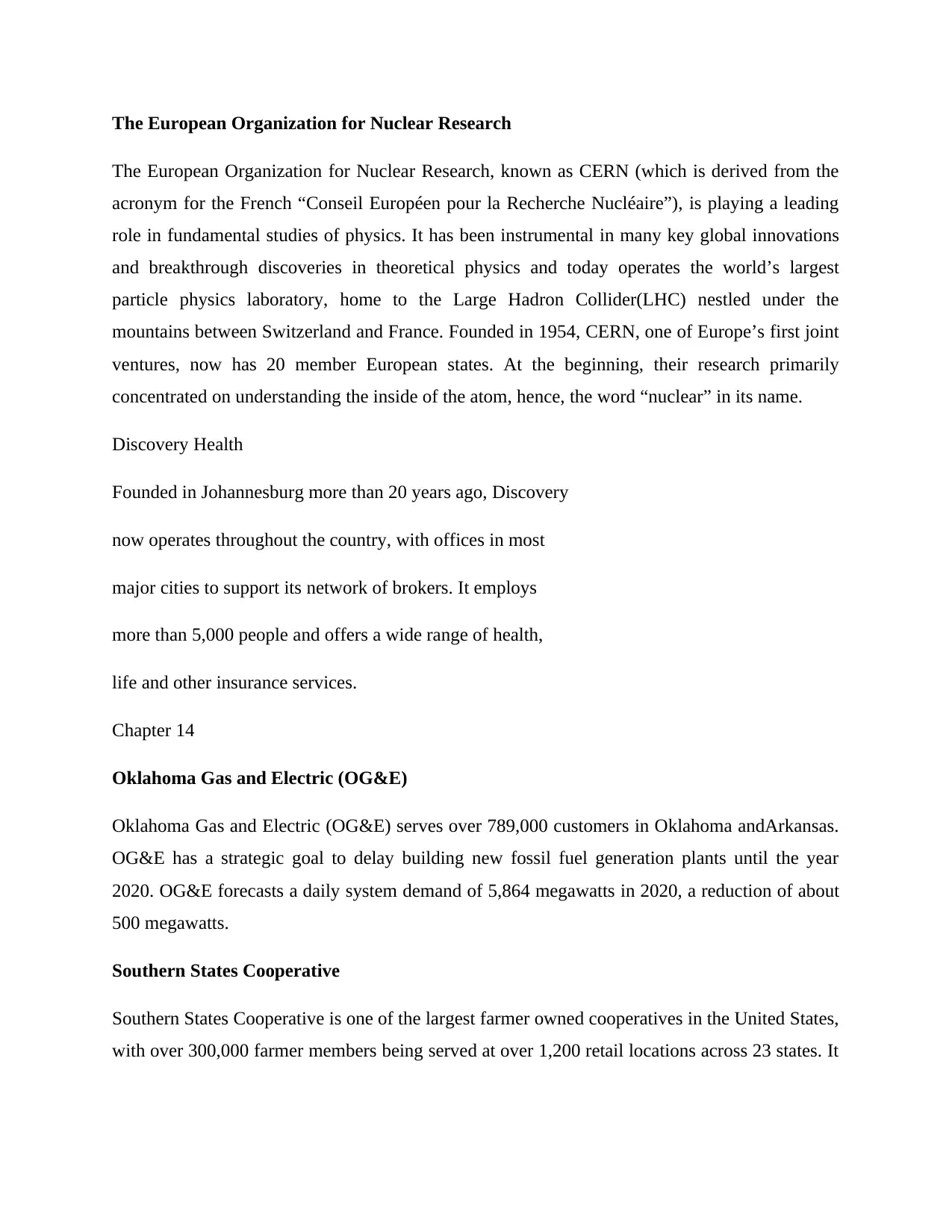
The European Organization for Nuclear Research
The European Organization for Nuclear Research, known as CERN (which is derived from the
acronym for the French “Conseil Européen pour la Recherche Nucléaire”), is playing a leading
role in fundamental studies of physics. It has been instrumental in many key global innovations
and breakthrough discoveries in theoretical physics and today operates the world’s largest
particle physics laboratory, home to the Large Hadron Collider(LHC) nestled under the
mountains between Switzerland and France. Founded in 1954, CERN, one of Europe’s first joint
ventures, now has 20 member European states. At the beginning, their research primarily
concentrated on understanding the inside of the atom, hence, the word “nuclear” in its name.
Discovery Health
Founded in Johannesburg more than 20 years ago, Discovery
now operates throughout the country, with offices in most
major cities to support its network of brokers. It employs
more than 5,000 people and offers a wide range of health,
life and other insurance services.
Chapter 14
Oklahoma Gas and Electric (OG&E)
Oklahoma Gas and Electric (OG&E) serves over 789,000 customers in Oklahoma andArkansas.
OG&E has a strategic goal to delay building new fossil fuel generation plants until the year
2020. OG&E forecasts a daily system demand of 5,864 megawatts in 2020, a reduction of about
500 megawatts.
Southern States Cooperative
Southern States Cooperative is one of the largest farmer owned cooperatives in the United States,
with over 300,000 farmer members being served at over 1,200 retail locations across 23 states. It
The European Organization for Nuclear Research, known as CERN (which is derived from the
acronym for the French “Conseil Européen pour la Recherche Nucléaire”), is playing a leading
role in fundamental studies of physics. It has been instrumental in many key global innovations
and breakthrough discoveries in theoretical physics and today operates the world’s largest
particle physics laboratory, home to the Large Hadron Collider(LHC) nestled under the
mountains between Switzerland and France. Founded in 1954, CERN, one of Europe’s first joint
ventures, now has 20 member European states. At the beginning, their research primarily
concentrated on understanding the inside of the atom, hence, the word “nuclear” in its name.
Discovery Health
Founded in Johannesburg more than 20 years ago, Discovery
now operates throughout the country, with offices in most
major cities to support its network of brokers. It employs
more than 5,000 people and offers a wide range of health,
life and other insurance services.
Chapter 14
Oklahoma Gas and Electric (OG&E)
Oklahoma Gas and Electric (OG&E) serves over 789,000 customers in Oklahoma andArkansas.
OG&E has a strategic goal to delay building new fossil fuel generation plants until the year
2020. OG&E forecasts a daily system demand of 5,864 megawatts in 2020, a reduction of about
500 megawatts.
Southern States Cooperative
Southern States Cooperative is one of the largest farmer owned cooperatives in the United States,
with over 300,000 farmer members being served at over 1,200 retail locations across 23 states. It
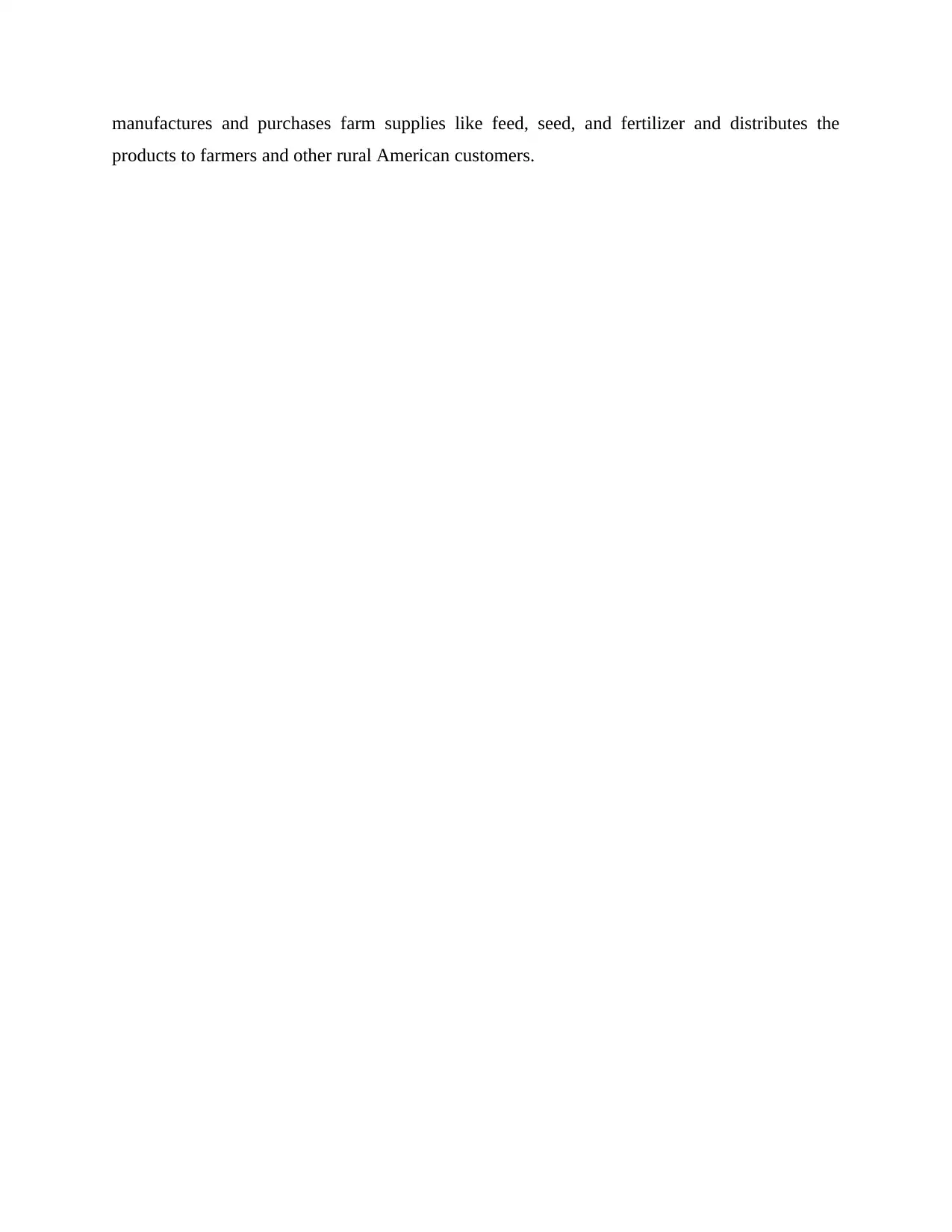
manufactures and purchases farm supplies like feed, seed, and fertilizer and distributes the
products to farmers and other rural American customers.
products to farmers and other rural American customers.
Paraphrase This Document
Need a fresh take? Get an instant paraphrase of this document with our AI Paraphraser
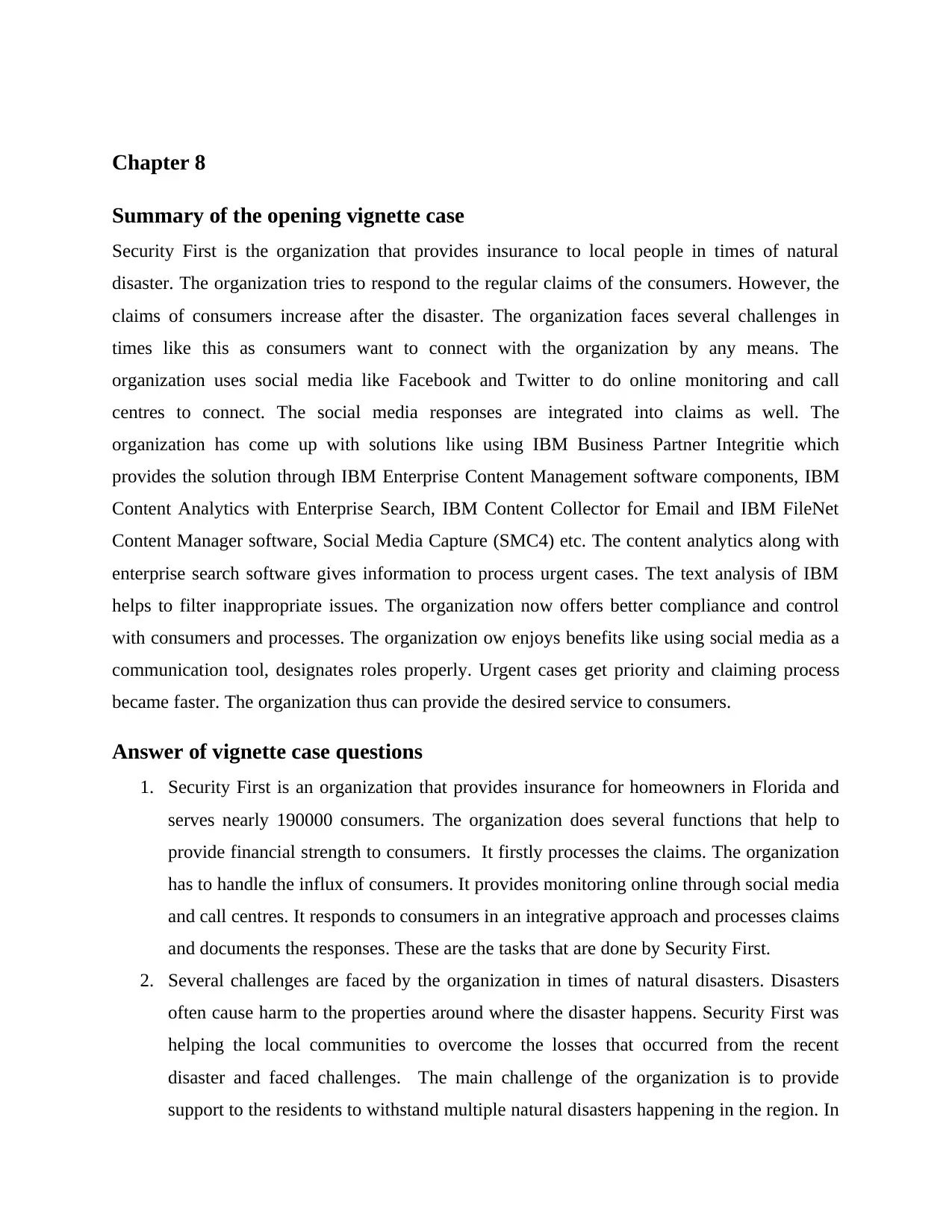
Chapter 8
Summary of the opening vignette case
Security First is the organization that provides insurance to local people in times of natural
disaster. The organization tries to respond to the regular claims of the consumers. However, the
claims of consumers increase after the disaster. The organization faces several challenges in
times like this as consumers want to connect with the organization by any means. The
organization uses social media like Facebook and Twitter to do online monitoring and call
centres to connect. The social media responses are integrated into claims as well. The
organization has come up with solutions like using IBM Business Partner Integritie which
provides the solution through IBM Enterprise Content Management software components, IBM
Content Analytics with Enterprise Search, IBM Content Collector for Email and IBM FileNet
Content Manager software, Social Media Capture (SMC4) etc. The content analytics along with
enterprise search software gives information to process urgent cases. The text analysis of IBM
helps to filter inappropriate issues. The organization now offers better compliance and control
with consumers and processes. The organization ow enjoys benefits like using social media as a
communication tool, designates roles properly. Urgent cases get priority and claiming process
became faster. The organization thus can provide the desired service to consumers.
Answer of vignette case questions
1. Security First is an organization that provides insurance for homeowners in Florida and
serves nearly 190000 consumers. The organization does several functions that help to
provide financial strength to consumers. It firstly processes the claims. The organization
has to handle the influx of consumers. It provides monitoring online through social media
and call centres. It responds to consumers in an integrative approach and processes claims
and documents the responses. These are the tasks that are done by Security First.
2. Several challenges are faced by the organization in times of natural disasters. Disasters
often cause harm to the properties around where the disaster happens. Security First was
helping the local communities to overcome the losses that occurred from the recent
disaster and faced challenges. The main challenge of the organization is to provide
support to the residents to withstand multiple natural disasters happening in the region. In
Summary of the opening vignette case
Security First is the organization that provides insurance to local people in times of natural
disaster. The organization tries to respond to the regular claims of the consumers. However, the
claims of consumers increase after the disaster. The organization faces several challenges in
times like this as consumers want to connect with the organization by any means. The
organization uses social media like Facebook and Twitter to do online monitoring and call
centres to connect. The social media responses are integrated into claims as well. The
organization has come up with solutions like using IBM Business Partner Integritie which
provides the solution through IBM Enterprise Content Management software components, IBM
Content Analytics with Enterprise Search, IBM Content Collector for Email and IBM FileNet
Content Manager software, Social Media Capture (SMC4) etc. The content analytics along with
enterprise search software gives information to process urgent cases. The text analysis of IBM
helps to filter inappropriate issues. The organization now offers better compliance and control
with consumers and processes. The organization ow enjoys benefits like using social media as a
communication tool, designates roles properly. Urgent cases get priority and claiming process
became faster. The organization thus can provide the desired service to consumers.
Answer of vignette case questions
1. Security First is an organization that provides insurance for homeowners in Florida and
serves nearly 190000 consumers. The organization does several functions that help to
provide financial strength to consumers. It firstly processes the claims. The organization
has to handle the influx of consumers. It provides monitoring online through social media
and call centres. It responds to consumers in an integrative approach and processes claims
and documents the responses. These are the tasks that are done by Security First.
2. Several challenges are faced by the organization in times of natural disasters. Disasters
often cause harm to the properties around where the disaster happens. Security First was
helping the local communities to overcome the losses that occurred from the recent
disaster and faced challenges. The main challenge of the organization is to provide
support to the residents to withstand multiple natural disasters happening in the region. In
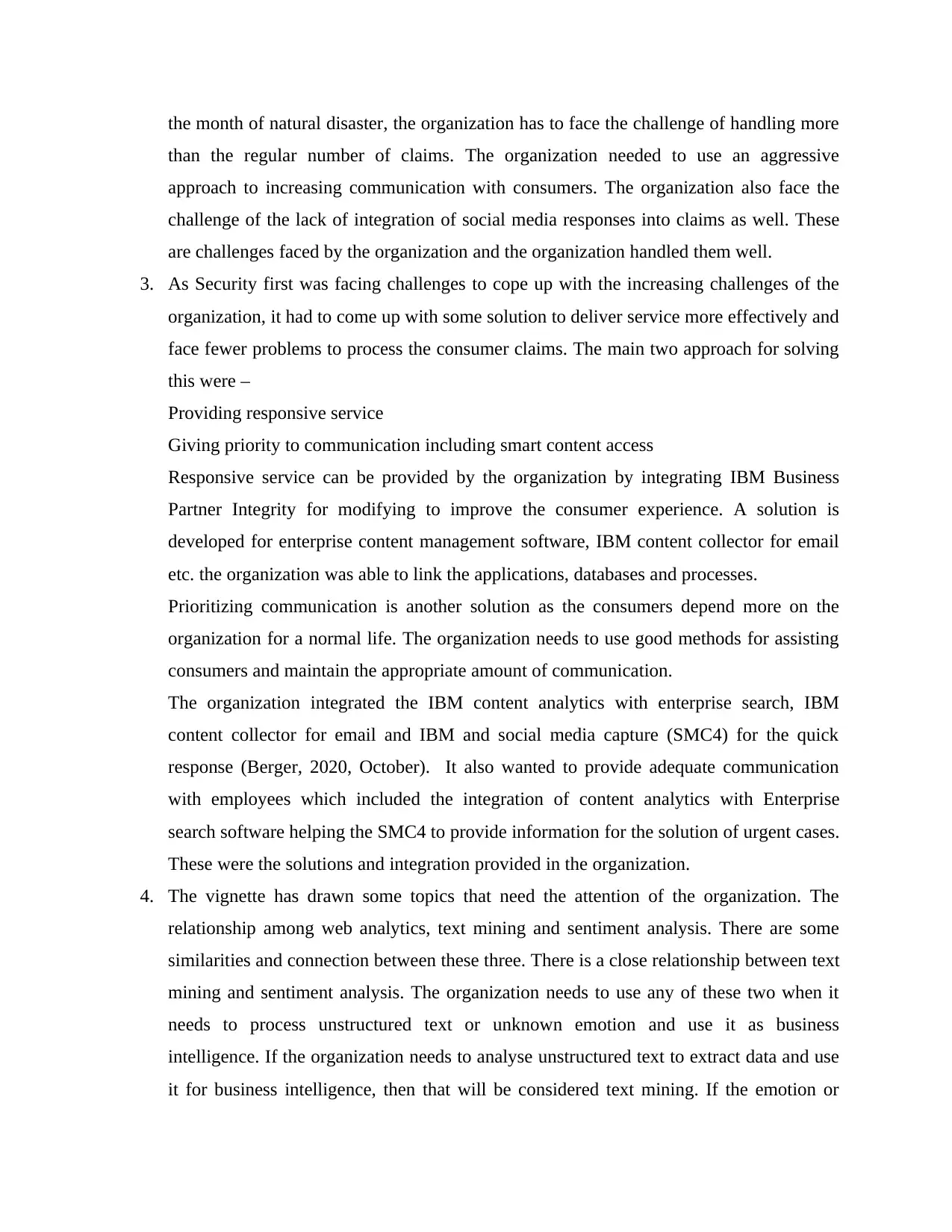
the month of natural disaster, the organization has to face the challenge of handling more
than the regular number of claims. The organization needed to use an aggressive
approach to increasing communication with consumers. The organization also face the
challenge of the lack of integration of social media responses into claims as well. These
are challenges faced by the organization and the organization handled them well.
3. As Security first was facing challenges to cope up with the increasing challenges of the
organization, it had to come up with some solution to deliver service more effectively and
face fewer problems to process the consumer claims. The main two approach for solving
this were –
Providing responsive service
Giving priority to communication including smart content access
Responsive service can be provided by the organization by integrating IBM Business
Partner Integrity for modifying to improve the consumer experience. A solution is
developed for enterprise content management software, IBM content collector for email
etc. the organization was able to link the applications, databases and processes.
Prioritizing communication is another solution as the consumers depend more on the
organization for a normal life. The organization needs to use good methods for assisting
consumers and maintain the appropriate amount of communication.
The organization integrated the IBM content analytics with enterprise search, IBM
content collector for email and IBM and social media capture (SMC4) for the quick
response (Berger, 2020, October). It also wanted to provide adequate communication
with employees which included the integration of content analytics with Enterprise
search software helping the SMC4 to provide information for the solution of urgent cases.
These were the solutions and integration provided in the organization.
4. The vignette has drawn some topics that need the attention of the organization. The
relationship among web analytics, text mining and sentiment analysis. There are some
similarities and connection between these three. There is a close relationship between text
mining and sentiment analysis. The organization needs to use any of these two when it
needs to process unstructured text or unknown emotion and use it as business
intelligence. If the organization needs to analyse unstructured text to extract data and use
it for business intelligence, then that will be considered text mining. If the emotion or
than the regular number of claims. The organization needed to use an aggressive
approach to increasing communication with consumers. The organization also face the
challenge of the lack of integration of social media responses into claims as well. These
are challenges faced by the organization and the organization handled them well.
3. As Security first was facing challenges to cope up with the increasing challenges of the
organization, it had to come up with some solution to deliver service more effectively and
face fewer problems to process the consumer claims. The main two approach for solving
this were –
Providing responsive service
Giving priority to communication including smart content access
Responsive service can be provided by the organization by integrating IBM Business
Partner Integrity for modifying to improve the consumer experience. A solution is
developed for enterprise content management software, IBM content collector for email
etc. the organization was able to link the applications, databases and processes.
Prioritizing communication is another solution as the consumers depend more on the
organization for a normal life. The organization needs to use good methods for assisting
consumers and maintain the appropriate amount of communication.
The organization integrated the IBM content analytics with enterprise search, IBM
content collector for email and IBM and social media capture (SMC4) for the quick
response (Berger, 2020, October). It also wanted to provide adequate communication
with employees which included the integration of content analytics with Enterprise
search software helping the SMC4 to provide information for the solution of urgent cases.
These were the solutions and integration provided in the organization.
4. The vignette has drawn some topics that need the attention of the organization. The
relationship among web analytics, text mining and sentiment analysis. There are some
similarities and connection between these three. There is a close relationship between text
mining and sentiment analysis. The organization needs to use any of these two when it
needs to process unstructured text or unknown emotion and use it as business
intelligence. If the organization needs to analyse unstructured text to extract data and use
it for business intelligence, then that will be considered text mining. If the emotion or
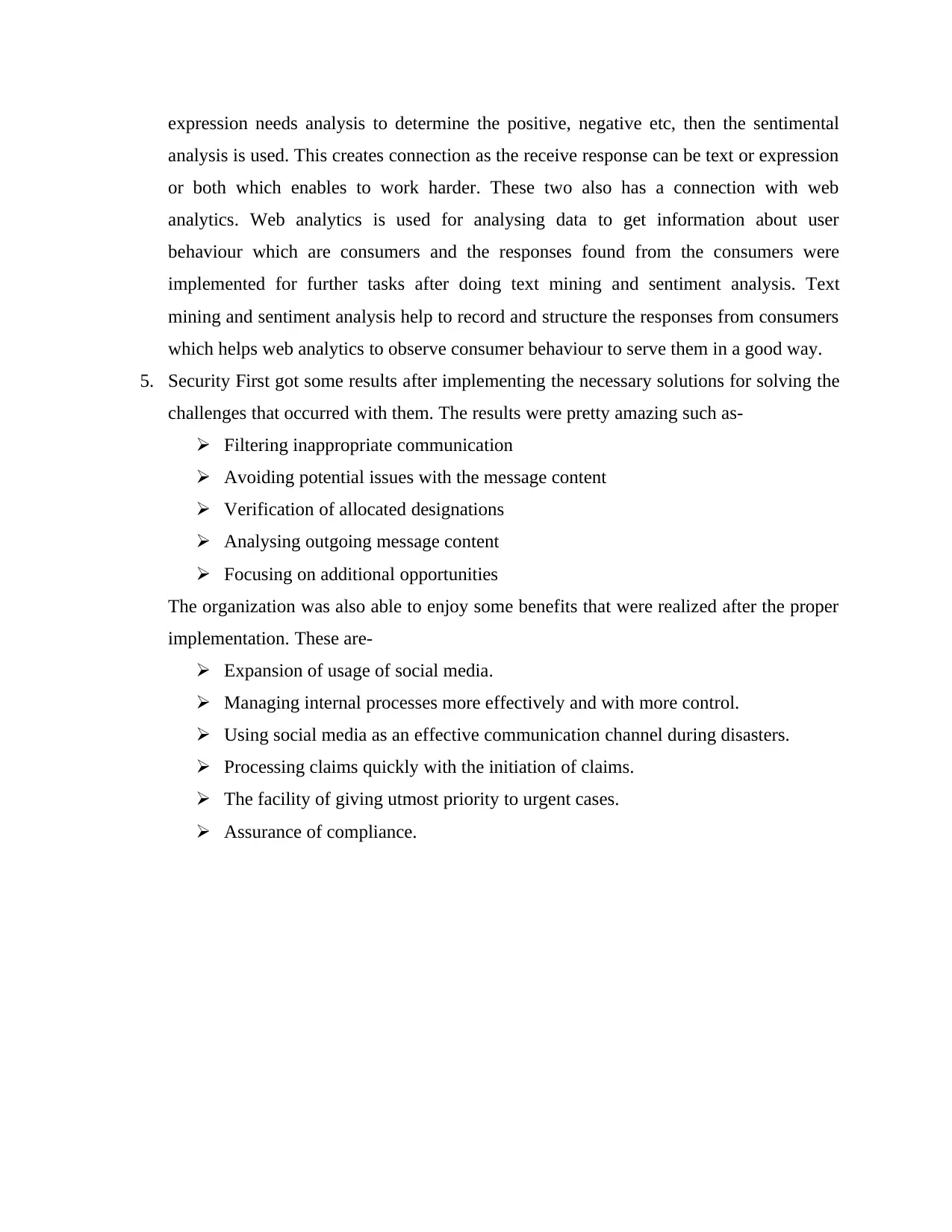
expression needs analysis to determine the positive, negative etc, then the sentimental
analysis is used. This creates connection as the receive response can be text or expression
or both which enables to work harder. These two also has a connection with web
analytics. Web analytics is used for analysing data to get information about user
behaviour which are consumers and the responses found from the consumers were
implemented for further tasks after doing text mining and sentiment analysis. Text
mining and sentiment analysis help to record and structure the responses from consumers
which helps web analytics to observe consumer behaviour to serve them in a good way.
5. Security First got some results after implementing the necessary solutions for solving the
challenges that occurred with them. The results were pretty amazing such as-
Filtering inappropriate communication
Avoiding potential issues with the message content
Verification of allocated designations
Analysing outgoing message content
Focusing on additional opportunities
The organization was also able to enjoy some benefits that were realized after the proper
implementation. These are-
Expansion of usage of social media.
Managing internal processes more effectively and with more control.
Using social media as an effective communication channel during disasters.
Processing claims quickly with the initiation of claims.
The facility of giving utmost priority to urgent cases.
Assurance of compliance.
analysis is used. This creates connection as the receive response can be text or expression
or both which enables to work harder. These two also has a connection with web
analytics. Web analytics is used for analysing data to get information about user
behaviour which are consumers and the responses found from the consumers were
implemented for further tasks after doing text mining and sentiment analysis. Text
mining and sentiment analysis help to record and structure the responses from consumers
which helps web analytics to observe consumer behaviour to serve them in a good way.
5. Security First got some results after implementing the necessary solutions for solving the
challenges that occurred with them. The results were pretty amazing such as-
Filtering inappropriate communication
Avoiding potential issues with the message content
Verification of allocated designations
Analysing outgoing message content
Focusing on additional opportunities
The organization was also able to enjoy some benefits that were realized after the proper
implementation. These are-
Expansion of usage of social media.
Managing internal processes more effectively and with more control.
Using social media as an effective communication channel during disasters.
Processing claims quickly with the initiation of claims.
The facility of giving utmost priority to urgent cases.
Assurance of compliance.
Secure Best Marks with AI Grader
Need help grading? Try our AI Grader for instant feedback on your assignments.

Learning from opening vignette case
Web analytics is crucial for businesses that want to provide more for consumers. Several things
can be learnt from the case which is noted below-
The consumer needs and innovative ways of satisfying them are learned.
The advanced analytics tools used for collecting consumer data is another thing to learn.
The usage of how social media can be used as communication media can be learned.
Application area in Bangladesh
Bangladesh bank uses web and content analytics to integrate information centrally. The credit
information bureau collects information from banks, annual audit report and other available
public sources to collect information about the way to serve consumers satisfactorily.
Web analytics is crucial for businesses that want to provide more for consumers. Several things
can be learnt from the case which is noted below-
The consumer needs and innovative ways of satisfying them are learned.
The advanced analytics tools used for collecting consumer data is another thing to learn.
The usage of how social media can be used as communication media can be learned.
Application area in Bangladesh
Bangladesh bank uses web and content analytics to integrate information centrally. The credit
information bureau collects information from banks, annual audit report and other available
public sources to collect information about the way to serve consumers satisfactorily.
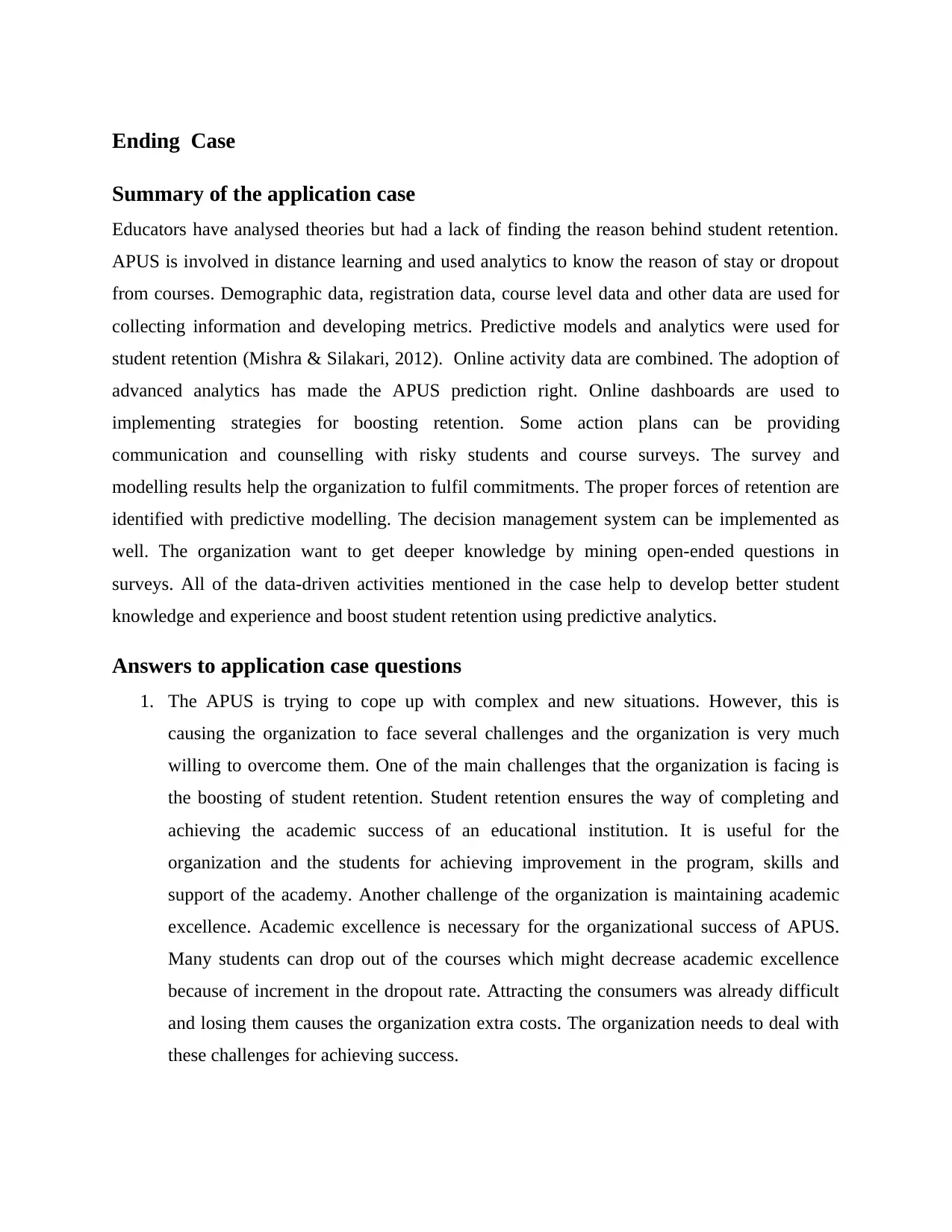
Ending Case
Summary of the application case
Educators have analysed theories but had a lack of finding the reason behind student retention.
APUS is involved in distance learning and used analytics to know the reason of stay or dropout
from courses. Demographic data, registration data, course level data and other data are used for
collecting information and developing metrics. Predictive models and analytics were used for
student retention (Mishra & Silakari, 2012). Online activity data are combined. The adoption of
advanced analytics has made the APUS prediction right. Online dashboards are used to
implementing strategies for boosting retention. Some action plans can be providing
communication and counselling with risky students and course surveys. The survey and
modelling results help the organization to fulfil commitments. The proper forces of retention are
identified with predictive modelling. The decision management system can be implemented as
well. The organization want to get deeper knowledge by mining open-ended questions in
surveys. All of the data-driven activities mentioned in the case help to develop better student
knowledge and experience and boost student retention using predictive analytics.
Answers to application case questions
1. The APUS is trying to cope up with complex and new situations. However, this is
causing the organization to face several challenges and the organization is very much
willing to overcome them. One of the main challenges that the organization is facing is
the boosting of student retention. Student retention ensures the way of completing and
achieving the academic success of an educational institution. It is useful for the
organization and the students for achieving improvement in the program, skills and
support of the academy. Another challenge of the organization is maintaining academic
excellence. Academic excellence is necessary for the organizational success of APUS.
Many students can drop out of the courses which might decrease academic excellence
because of increment in the dropout rate. Attracting the consumers was already difficult
and losing them causes the organization extra costs. The organization needs to deal with
these challenges for achieving success.
Summary of the application case
Educators have analysed theories but had a lack of finding the reason behind student retention.
APUS is involved in distance learning and used analytics to know the reason of stay or dropout
from courses. Demographic data, registration data, course level data and other data are used for
collecting information and developing metrics. Predictive models and analytics were used for
student retention (Mishra & Silakari, 2012). Online activity data are combined. The adoption of
advanced analytics has made the APUS prediction right. Online dashboards are used to
implementing strategies for boosting retention. Some action plans can be providing
communication and counselling with risky students and course surveys. The survey and
modelling results help the organization to fulfil commitments. The proper forces of retention are
identified with predictive modelling. The decision management system can be implemented as
well. The organization want to get deeper knowledge by mining open-ended questions in
surveys. All of the data-driven activities mentioned in the case help to develop better student
knowledge and experience and boost student retention using predictive analytics.
Answers to application case questions
1. The APUS is trying to cope up with complex and new situations. However, this is
causing the organization to face several challenges and the organization is very much
willing to overcome them. One of the main challenges that the organization is facing is
the boosting of student retention. Student retention ensures the way of completing and
achieving the academic success of an educational institution. It is useful for the
organization and the students for achieving improvement in the program, skills and
support of the academy. Another challenge of the organization is maintaining academic
excellence. Academic excellence is necessary for the organizational success of APUS.
Many students can drop out of the courses which might decrease academic excellence
because of increment in the dropout rate. Attracting the consumers was already difficult
and losing them causes the organization extra costs. The organization needs to deal with
these challenges for achieving success.
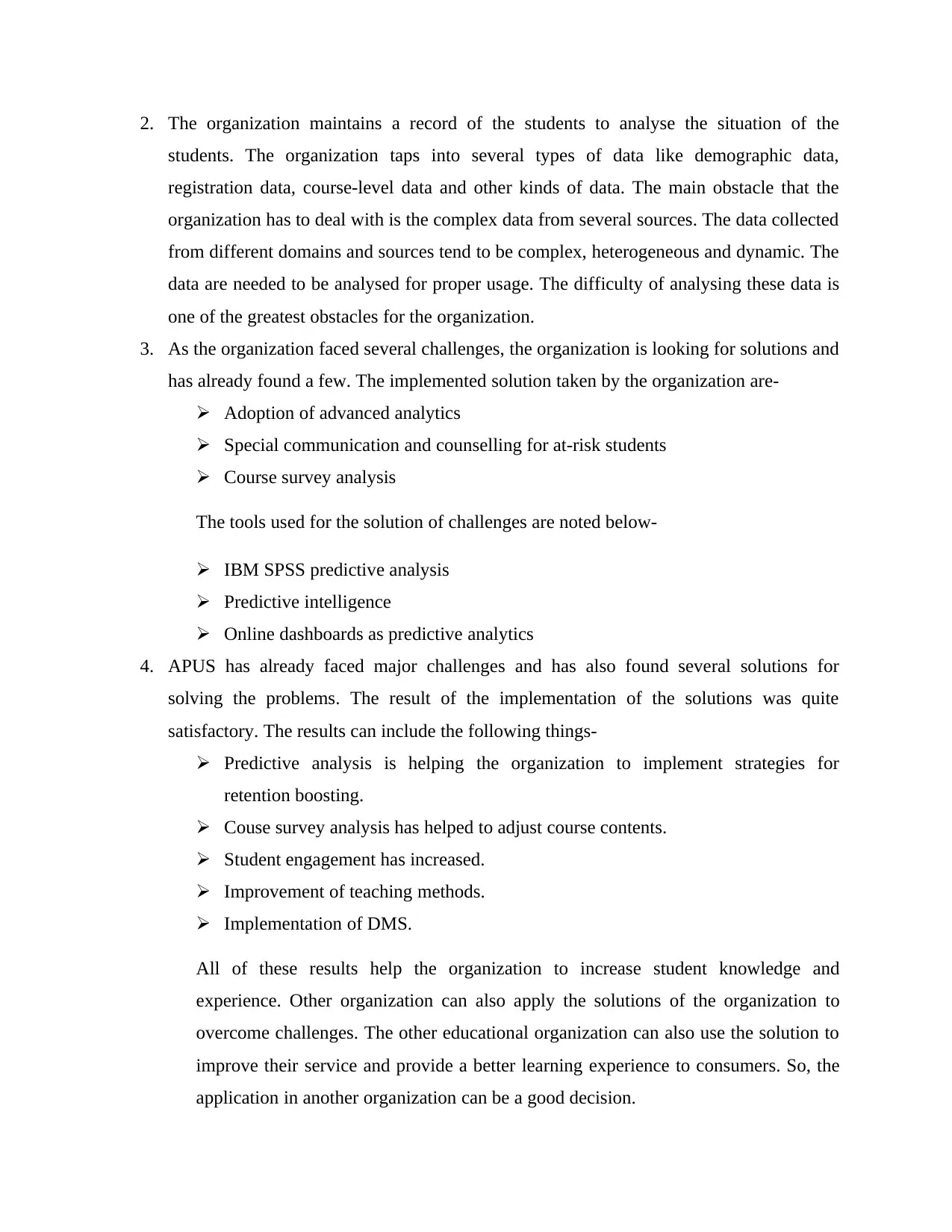
2. The organization maintains a record of the students to analyse the situation of the
students. The organization taps into several types of data like demographic data,
registration data, course-level data and other kinds of data. The main obstacle that the
organization has to deal with is the complex data from several sources. The data collected
from different domains and sources tend to be complex, heterogeneous and dynamic. The
data are needed to be analysed for proper usage. The difficulty of analysing these data is
one of the greatest obstacles for the organization.
3. As the organization faced several challenges, the organization is looking for solutions and
has already found a few. The implemented solution taken by the organization are-
Adoption of advanced analytics
Special communication and counselling for at-risk students
Course survey analysis
The tools used for the solution of challenges are noted below-
IBM SPSS predictive analysis
Predictive intelligence
Online dashboards as predictive analytics
4. APUS has already faced major challenges and has also found several solutions for
solving the problems. The result of the implementation of the solutions was quite
satisfactory. The results can include the following things-
Predictive analysis is helping the organization to implement strategies for
retention boosting.
Couse survey analysis has helped to adjust course contents.
Student engagement has increased.
Improvement of teaching methods.
Implementation of DMS.
All of these results help the organization to increase student knowledge and
experience. Other organization can also apply the solutions of the organization to
overcome challenges. The other educational organization can also use the solution to
improve their service and provide a better learning experience to consumers. So, the
application in another organization can be a good decision.
students. The organization taps into several types of data like demographic data,
registration data, course-level data and other kinds of data. The main obstacle that the
organization has to deal with is the complex data from several sources. The data collected
from different domains and sources tend to be complex, heterogeneous and dynamic. The
data are needed to be analysed for proper usage. The difficulty of analysing these data is
one of the greatest obstacles for the organization.
3. As the organization faced several challenges, the organization is looking for solutions and
has already found a few. The implemented solution taken by the organization are-
Adoption of advanced analytics
Special communication and counselling for at-risk students
Course survey analysis
The tools used for the solution of challenges are noted below-
IBM SPSS predictive analysis
Predictive intelligence
Online dashboards as predictive analytics
4. APUS has already faced major challenges and has also found several solutions for
solving the problems. The result of the implementation of the solutions was quite
satisfactory. The results can include the following things-
Predictive analysis is helping the organization to implement strategies for
retention boosting.
Couse survey analysis has helped to adjust course contents.
Student engagement has increased.
Improvement of teaching methods.
Implementation of DMS.
All of these results help the organization to increase student knowledge and
experience. Other organization can also apply the solutions of the organization to
overcome challenges. The other educational organization can also use the solution to
improve their service and provide a better learning experience to consumers. So, the
application in another organization can be a good decision.
Paraphrase This Document
Need a fresh take? Get an instant paraphrase of this document with our AI Paraphraser
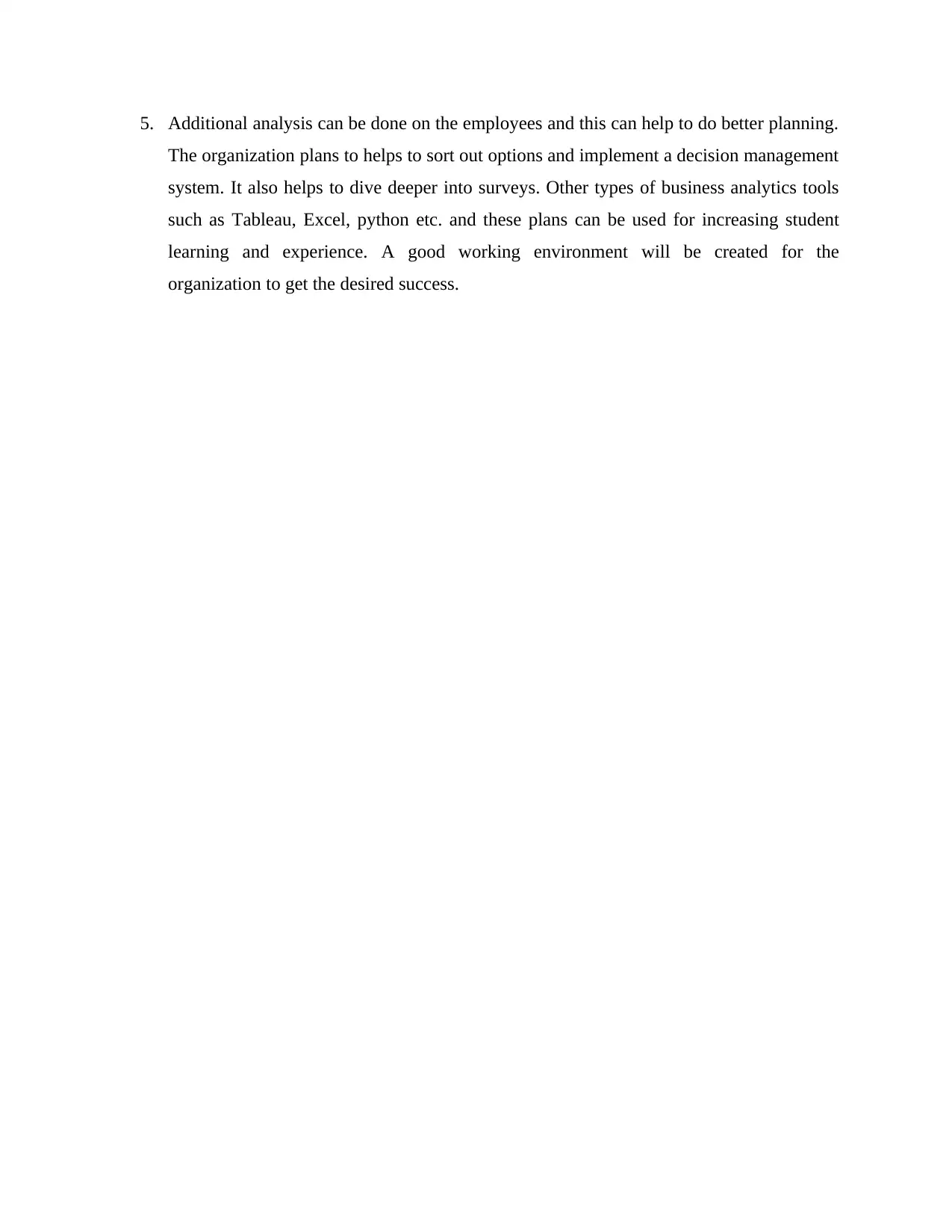
5. Additional analysis can be done on the employees and this can help to do better planning.
The organization plans to helps to sort out options and implement a decision management
system. It also helps to dive deeper into surveys. Other types of business analytics tools
such as Tableau, Excel, python etc. and these plans can be used for increasing student
learning and experience. A good working environment will be created for the
organization to get the desired success.
The organization plans to helps to sort out options and implement a decision management
system. It also helps to dive deeper into surveys. Other types of business analytics tools
such as Tableau, Excel, python etc. and these plans can be used for increasing student
learning and experience. A good working environment will be created for the
organization to get the desired success.
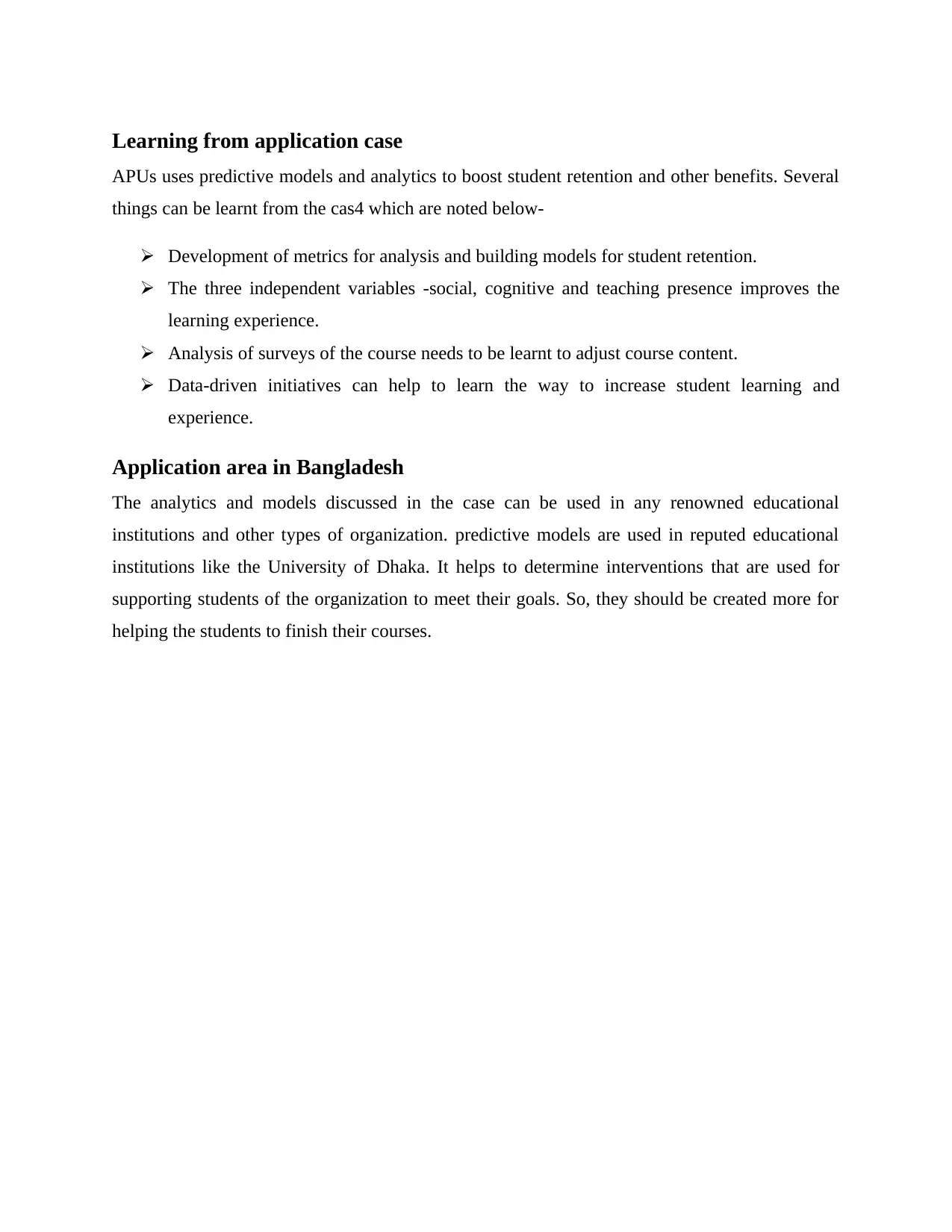
Learning from application case
APUs uses predictive models and analytics to boost student retention and other benefits. Several
things can be learnt from the cas4 which are noted below-
Development of metrics for analysis and building models for student retention.
The three independent variables -social, cognitive and teaching presence improves the
learning experience.
Analysis of surveys of the course needs to be learnt to adjust course content.
Data-driven initiatives can help to learn the way to increase student learning and
experience.
Application area in Bangladesh
The analytics and models discussed in the case can be used in any renowned educational
institutions and other types of organization. predictive models are used in reputed educational
institutions like the University of Dhaka. It helps to determine interventions that are used for
supporting students of the organization to meet their goals. So, they should be created more for
helping the students to finish their courses.
APUs uses predictive models and analytics to boost student retention and other benefits. Several
things can be learnt from the cas4 which are noted below-
Development of metrics for analysis and building models for student retention.
The three independent variables -social, cognitive and teaching presence improves the
learning experience.
Analysis of surveys of the course needs to be learnt to adjust course content.
Data-driven initiatives can help to learn the way to increase student learning and
experience.
Application area in Bangladesh
The analytics and models discussed in the case can be used in any renowned educational
institutions and other types of organization. predictive models are used in reputed educational
institutions like the University of Dhaka. It helps to determine interventions that are used for
supporting students of the organization to meet their goals. So, they should be created more for
helping the students to finish their courses.
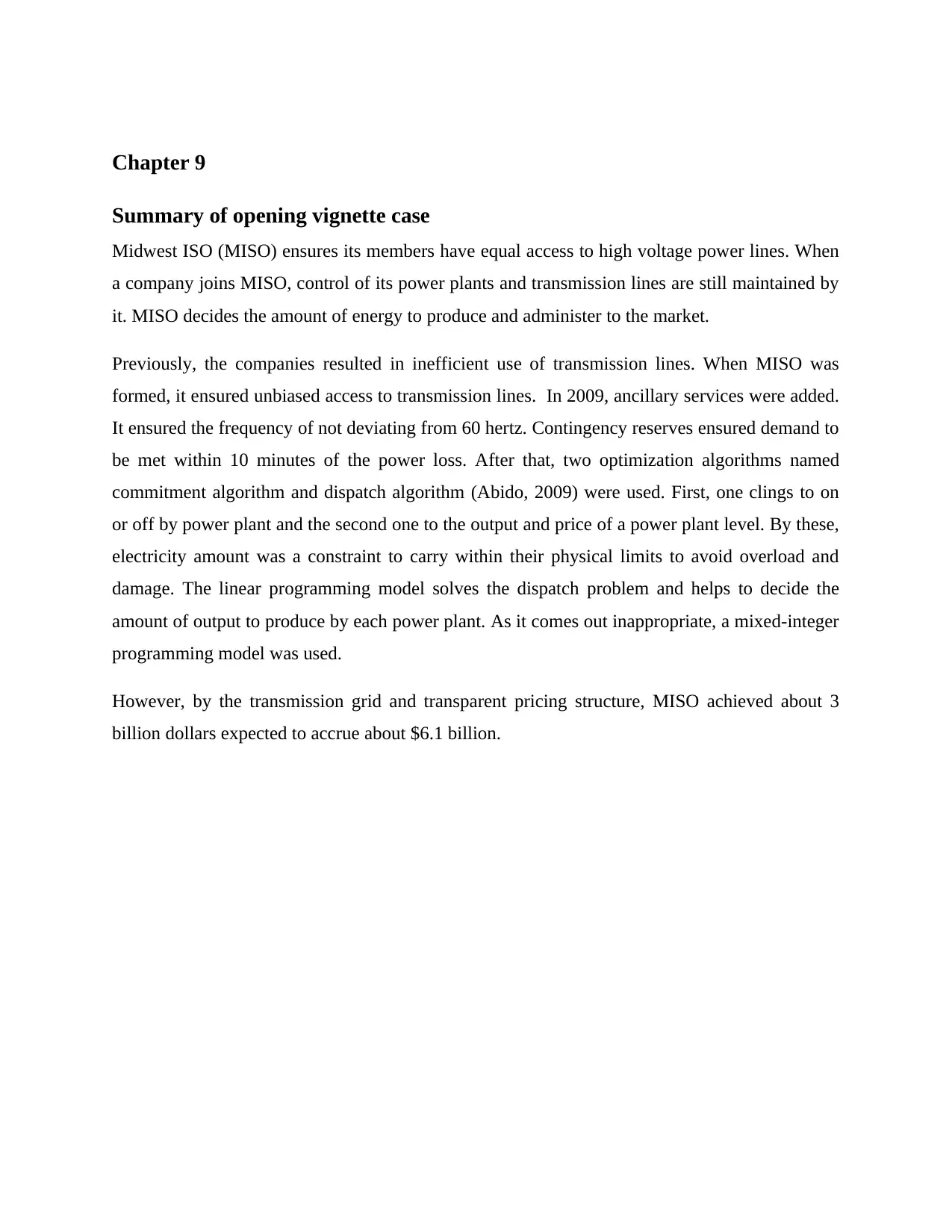
Chapter 9
Summary of opening vignette case
Midwest ISO (MISO) ensures its members have equal access to high voltage power lines. When
a company joins MISO, control of its power plants and transmission lines are still maintained by
it. MISO decides the amount of energy to produce and administer to the market.
Previously, the companies resulted in inefficient use of transmission lines. When MISO was
formed, it ensured unbiased access to transmission lines. In 2009, ancillary services were added.
It ensured the frequency of not deviating from 60 hertz. Contingency reserves ensured demand to
be met within 10 minutes of the power loss. After that, two optimization algorithms named
commitment algorithm and dispatch algorithm (Abido, 2009) were used. First, one clings to on
or off by power plant and the second one to the output and price of a power plant level. By these,
electricity amount was a constraint to carry within their physical limits to avoid overload and
damage. The linear programming model solves the dispatch problem and helps to decide the
amount of output to produce by each power plant. As it comes out inappropriate, a mixed-integer
programming model was used.
However, by the transmission grid and transparent pricing structure, MISO achieved about 3
billion dollars expected to accrue about $6.1 billion.
Summary of opening vignette case
Midwest ISO (MISO) ensures its members have equal access to high voltage power lines. When
a company joins MISO, control of its power plants and transmission lines are still maintained by
it. MISO decides the amount of energy to produce and administer to the market.
Previously, the companies resulted in inefficient use of transmission lines. When MISO was
formed, it ensured unbiased access to transmission lines. In 2009, ancillary services were added.
It ensured the frequency of not deviating from 60 hertz. Contingency reserves ensured demand to
be met within 10 minutes of the power loss. After that, two optimization algorithms named
commitment algorithm and dispatch algorithm (Abido, 2009) were used. First, one clings to on
or off by power plant and the second one to the output and price of a power plant level. By these,
electricity amount was a constraint to carry within their physical limits to avoid overload and
damage. The linear programming model solves the dispatch problem and helps to decide the
amount of output to produce by each power plant. As it comes out inappropriate, a mixed-integer
programming model was used.
However, by the transmission grid and transparent pricing structure, MISO achieved about 3
billion dollars expected to accrue about $6.1 billion.
Secure Best Marks with AI Grader
Need help grading? Try our AI Grader for instant feedback on your assignments.
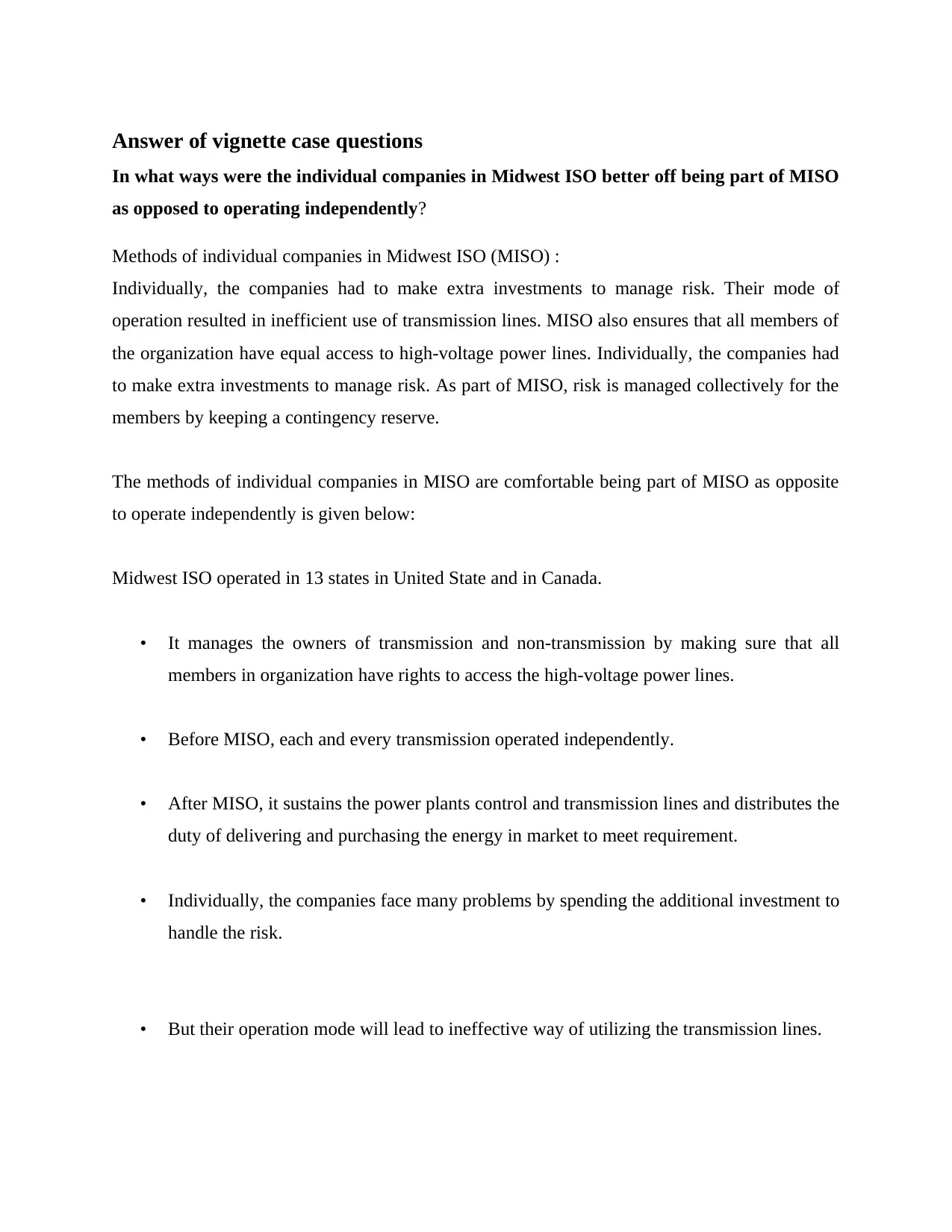
Answer of vignette case questions
In what ways were the individual companies in Midwest ISO better off being part of MISO
as opposed to operating independently?
Methods of individual companies in Midwest ISO (MISO) :
Individually, the companies had to make extra investments to manage risk. Their mode of
operation resulted in inefficient use of transmission lines. MISO also ensures that all members of
the organization have equal access to high-voltage power lines. Individually, the companies had
to make extra investments to manage risk. As part of MISO, risk is managed collectively for the
members by keeping a contingency reserve.
The methods of individual companies in MISO are comfortable being part of MISO as opposite
to operate independently is given below:
Midwest ISO operated in 13 states in United State and in Canada.
• It manages the owners of transmission and non-transmission by making sure that all
members in organization have rights to access the high-voltage power lines.
• Before MISO, each and every transmission operated independently.
• After MISO, it sustains the power plants control and transmission lines and distributes the
duty of delivering and purchasing the energy in market to meet requirement.
• Individually, the companies face many problems by spending the additional investment to
handle the risk.
• But their operation mode will lead to ineffective way of utilizing the transmission lines.
In what ways were the individual companies in Midwest ISO better off being part of MISO
as opposed to operating independently?
Methods of individual companies in Midwest ISO (MISO) :
Individually, the companies had to make extra investments to manage risk. Their mode of
operation resulted in inefficient use of transmission lines. MISO also ensures that all members of
the organization have equal access to high-voltage power lines. Individually, the companies had
to make extra investments to manage risk. As part of MISO, risk is managed collectively for the
members by keeping a contingency reserve.
The methods of individual companies in MISO are comfortable being part of MISO as opposite
to operate independently is given below:
Midwest ISO operated in 13 states in United State and in Canada.
• It manages the owners of transmission and non-transmission by making sure that all
members in organization have rights to access the high-voltage power lines.
• Before MISO, each and every transmission operated independently.
• After MISO, it sustains the power plants control and transmission lines and distributes the
duty of delivering and purchasing the energy in market to meet requirement.
• Individually, the companies face many problems by spending the additional investment to
handle the risk.
• But their operation mode will lead to ineffective way of utilizing the transmission lines.

• By keeping the contingency reserves help to manage the risk cooperatively for members
of companies.
That is, it helps to make sure the result of unpredicted power loss, meet the request within 10
minutes of power loss.
1. The dispatch problem was solved with a linear programming method. Explain the
need of such method in light of the problem discussed in the case.
Linear programming method to solve the dispatch problem:
Midwest ISO operated in 13 states in United State and in Canada.
• It manages the owners of transmission and non-transmission by make sure that all members in
organization have rights to access the high-voltage power lines.
• Before MISO, each and every transmission operated independently.
• After MISO, it sustains the power plants control and transmission lines and distributes the duty
of delivering and purchasing the energy in market to meet requirement.
In terms of MISOs DSS, the dispatch problem was to decide how much output should be
produced by each power plant, and determine the price of energy based on the location of the
power plant. The linear programming method fits well with this type of problem. Constraints
include limits on frequency deviation (60 hertz) and power-loss time (10 minutes). The objective
function involves expending the least possible total power to meet the electrical needs, and the
decision variables are the power plants output.
of companies.
That is, it helps to make sure the result of unpredicted power loss, meet the request within 10
minutes of power loss.
1. The dispatch problem was solved with a linear programming method. Explain the
need of such method in light of the problem discussed in the case.
Linear programming method to solve the dispatch problem:
Midwest ISO operated in 13 states in United State and in Canada.
• It manages the owners of transmission and non-transmission by make sure that all members in
organization have rights to access the high-voltage power lines.
• Before MISO, each and every transmission operated independently.
• After MISO, it sustains the power plants control and transmission lines and distributes the duty
of delivering and purchasing the energy in market to meet requirement.
In terms of MISOs DSS, the dispatch problem was to decide how much output should be
produced by each power plant, and determine the price of energy based on the location of the
power plant. The linear programming method fits well with this type of problem. Constraints
include limits on frequency deviation (60 hertz) and power-loss time (10 minutes). The objective
function involves expending the least possible total power to meet the electrical needs, and the
decision variables are the power plants output.
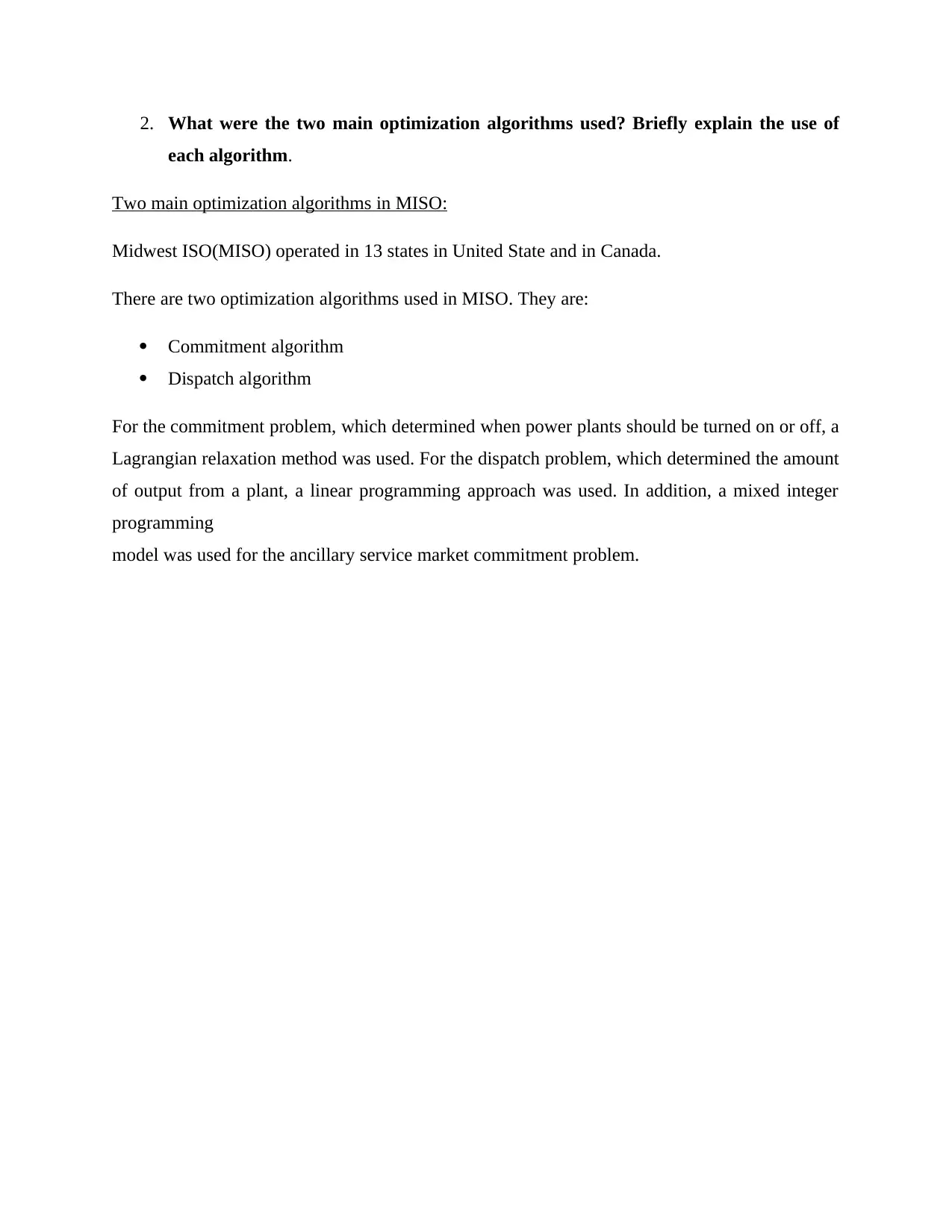
2. What were the two main optimization algorithms used? Briefly explain the use of
each algorithm.
Two main optimization algorithms in MISO:
Midwest ISO(MISO) operated in 13 states in United State and in Canada.
There are two optimization algorithms used in MISO. They are:
Commitment algorithm
Dispatch algorithm
For the commitment problem, which determined when power plants should be turned on or off, a
Lagrangian relaxation method was used. For the dispatch problem, which determined the amount
of output from a plant, a linear programming approach was used. In addition, a mixed integer
programming
model was used for the ancillary service market commitment problem.
each algorithm.
Two main optimization algorithms in MISO:
Midwest ISO(MISO) operated in 13 states in United State and in Canada.
There are two optimization algorithms used in MISO. They are:
Commitment algorithm
Dispatch algorithm
For the commitment problem, which determined when power plants should be turned on or off, a
Lagrangian relaxation method was used. For the dispatch problem, which determined the amount
of output from a plant, a linear programming approach was used. In addition, a mixed integer
programming
model was used for the ancillary service market commitment problem.
Paraphrase This Document
Need a fresh take? Get an instant paraphrase of this document with our AI Paraphraser
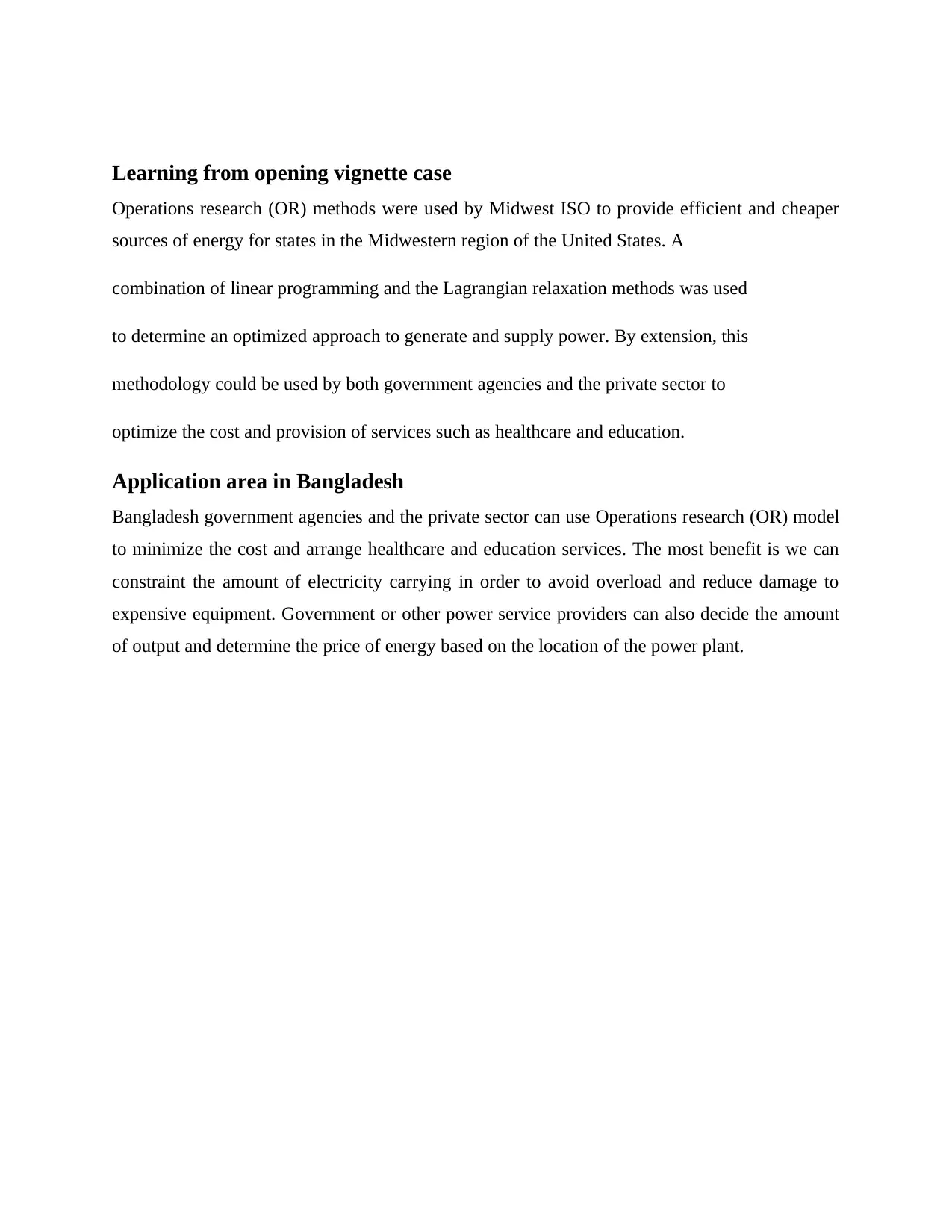
Learning from opening vignette case
Operations research (OR) methods were used by Midwest ISO to provide efficient and cheaper
sources of energy for states in the Midwestern region of the United States. A
combination of linear programming and the Lagrangian relaxation methods was used
to determine an optimized approach to generate and supply power. By extension, this
methodology could be used by both government agencies and the private sector to
optimize the cost and provision of services such as healthcare and education.
Application area in Bangladesh
Bangladesh government agencies and the private sector can use Operations research (OR) model
to minimize the cost and arrange healthcare and education services. The most benefit is we can
constraint the amount of electricity carrying in order to avoid overload and reduce damage to
expensive equipment. Government or other power service providers can also decide the amount
of output and determine the price of energy based on the location of the power plant.
Operations research (OR) methods were used by Midwest ISO to provide efficient and cheaper
sources of energy for states in the Midwestern region of the United States. A
combination of linear programming and the Lagrangian relaxation methods was used
to determine an optimized approach to generate and supply power. By extension, this
methodology could be used by both government agencies and the private sector to
optimize the cost and provision of services such as healthcare and education.
Application area in Bangladesh
Bangladesh government agencies and the private sector can use Operations research (OR) model
to minimize the cost and arrange healthcare and education services. The most benefit is we can
constraint the amount of electricity carrying in order to avoid overload and reduce damage to
expensive equipment. Government or other power service providers can also decide the amount
of output and determine the price of energy based on the location of the power plant.

Ending case
Summary of application case
CARE International provides relief aids to the natural disasters area. They take help from third
party regarding transportation and purchase relief items from local suppliers that help local
companies reinvigorate the local company after disaster. It faces challenges in gathering supplies
and relief items from both local and international suppliers in an agile and distributing the
suppliers in timely manner. Further it develops pre-positioning model ( Rawls and Turnquist,
2010) that provide relief services more rapidly, especially in times of crisis. In addition, the pre-
positioning model promises to save money, labor, and time by increasing the efficiency of their
operations. Most importantly, CARE will save more lives and help people get back onto their
feet more effectively over time to sudden natural disasters like earth-quakes.
Answer of application case questions
1. What were the main challenges encountered by CARE International before they
created their warehouse pre-positioning model?
Challenges faced by CARE International before they warehouse creation:
CARE International is an organization for humanitarian which offers the help to people in areas
affected by natural disasters like earthquakes.
The challenges faced by CARE International are event of natural disasters.
• In the disaster event, the organization determines the suppliers which offer the desired relief
items.
• The third-party vendors fly into areas affected by disaster and CARE International shared by
ground before they created the pre-positioning model.
o This mode of transportation was unreliable and slow.
• But, the CARE International organization needs to collect the supplies and relief items from
both local and international suppliers.
Summary of application case
CARE International provides relief aids to the natural disasters area. They take help from third
party regarding transportation and purchase relief items from local suppliers that help local
companies reinvigorate the local company after disaster. It faces challenges in gathering supplies
and relief items from both local and international suppliers in an agile and distributing the
suppliers in timely manner. Further it develops pre-positioning model ( Rawls and Turnquist,
2010) that provide relief services more rapidly, especially in times of crisis. In addition, the pre-
positioning model promises to save money, labor, and time by increasing the efficiency of their
operations. Most importantly, CARE will save more lives and help people get back onto their
feet more effectively over time to sudden natural disasters like earth-quakes.
Answer of application case questions
1. What were the main challenges encountered by CARE International before they
created their warehouse pre-positioning model?
Challenges faced by CARE International before they warehouse creation:
CARE International is an organization for humanitarian which offers the help to people in areas
affected by natural disasters like earthquakes.
The challenges faced by CARE International are event of natural disasters.
• In the disaster event, the organization determines the suppliers which offer the desired relief
items.
• The third-party vendors fly into areas affected by disaster and CARE International shared by
ground before they created the pre-positioning model.
o This mode of transportation was unreliable and slow.
• But, the CARE International organization needs to collect the supplies and relief items from
both local and international suppliers.
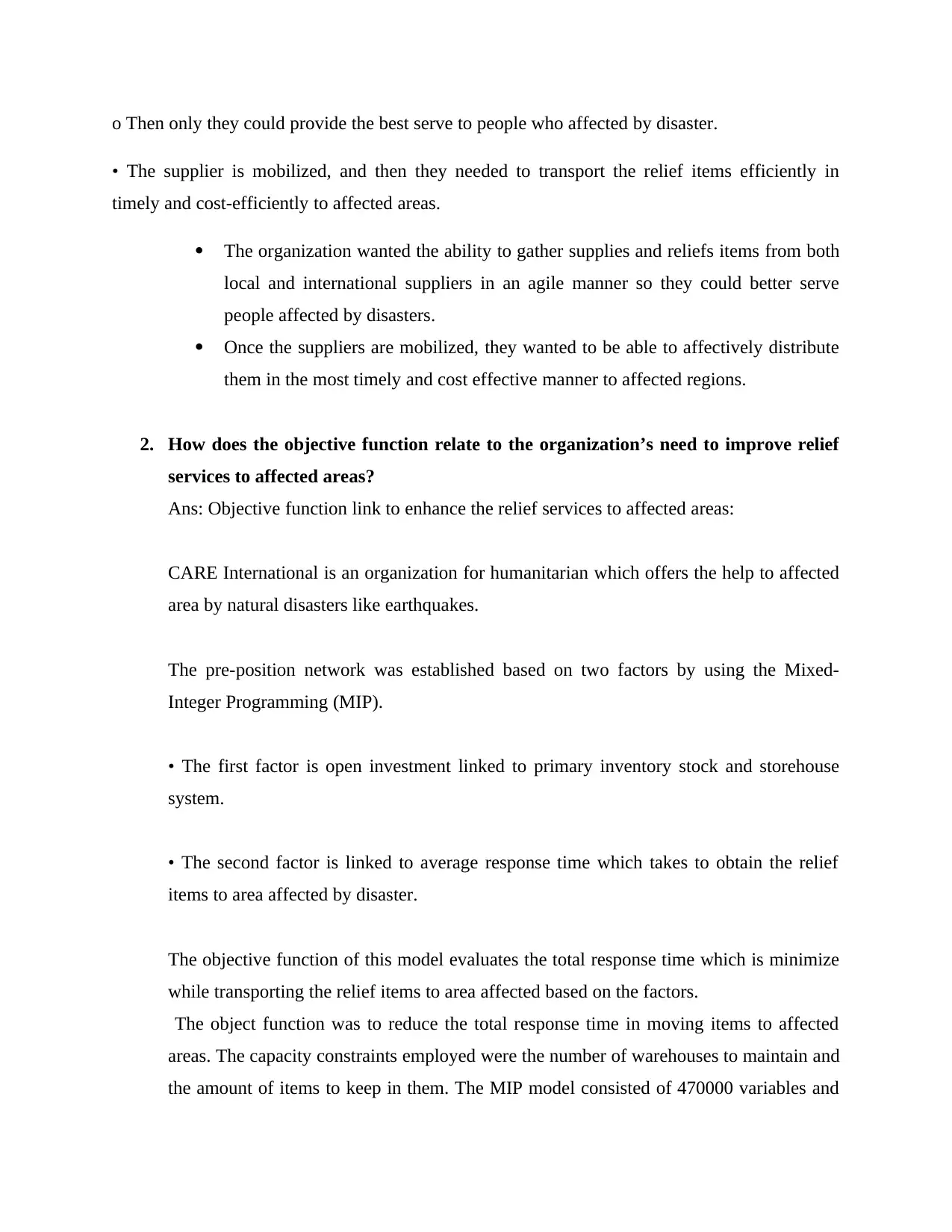
o Then only they could provide the best serve to people who affected by disaster.
• The supplier is mobilized, and then they needed to transport the relief items efficiently in
timely and cost-efficiently to affected areas.
The organization wanted the ability to gather supplies and reliefs items from both
local and international suppliers in an agile manner so they could better serve
people affected by disasters.
Once the suppliers are mobilized, they wanted to be able to affectively distribute
them in the most timely and cost effective manner to affected regions.
2. How does the objective function relate to the organization’s need to improve relief
services to affected areas?
Ans: Objective function link to enhance the relief services to affected areas:
CARE International is an organization for humanitarian which offers the help to affected
area by natural disasters like earthquakes.
The pre-position network was established based on two factors by using the Mixed-
Integer Programming (MIP).
• The first factor is open investment linked to primary inventory stock and storehouse
system.
• The second factor is linked to average response time which takes to obtain the relief
items to area affected by disaster.
The objective function of this model evaluates the total response time which is minimize
while transporting the relief items to area affected based on the factors.
The object function was to reduce the total response time in moving items to affected
areas. The capacity constraints employed were the number of warehouses to maintain and
the amount of items to keep in them. The MIP model consisted of 470000 variables and
• The supplier is mobilized, and then they needed to transport the relief items efficiently in
timely and cost-efficiently to affected areas.
The organization wanted the ability to gather supplies and reliefs items from both
local and international suppliers in an agile manner so they could better serve
people affected by disasters.
Once the suppliers are mobilized, they wanted to be able to affectively distribute
them in the most timely and cost effective manner to affected regions.
2. How does the objective function relate to the organization’s need to improve relief
services to affected areas?
Ans: Objective function link to enhance the relief services to affected areas:
CARE International is an organization for humanitarian which offers the help to affected
area by natural disasters like earthquakes.
The pre-position network was established based on two factors by using the Mixed-
Integer Programming (MIP).
• The first factor is open investment linked to primary inventory stock and storehouse
system.
• The second factor is linked to average response time which takes to obtain the relief
items to area affected by disaster.
The objective function of this model evaluates the total response time which is minimize
while transporting the relief items to area affected based on the factors.
The object function was to reduce the total response time in moving items to affected
areas. The capacity constraints employed were the number of warehouses to maintain and
the amount of items to keep in them. The MIP model consisted of 470000 variables and
Secure Best Marks with AI Grader
Need help grading? Try our AI Grader for instant feedback on your assignments.
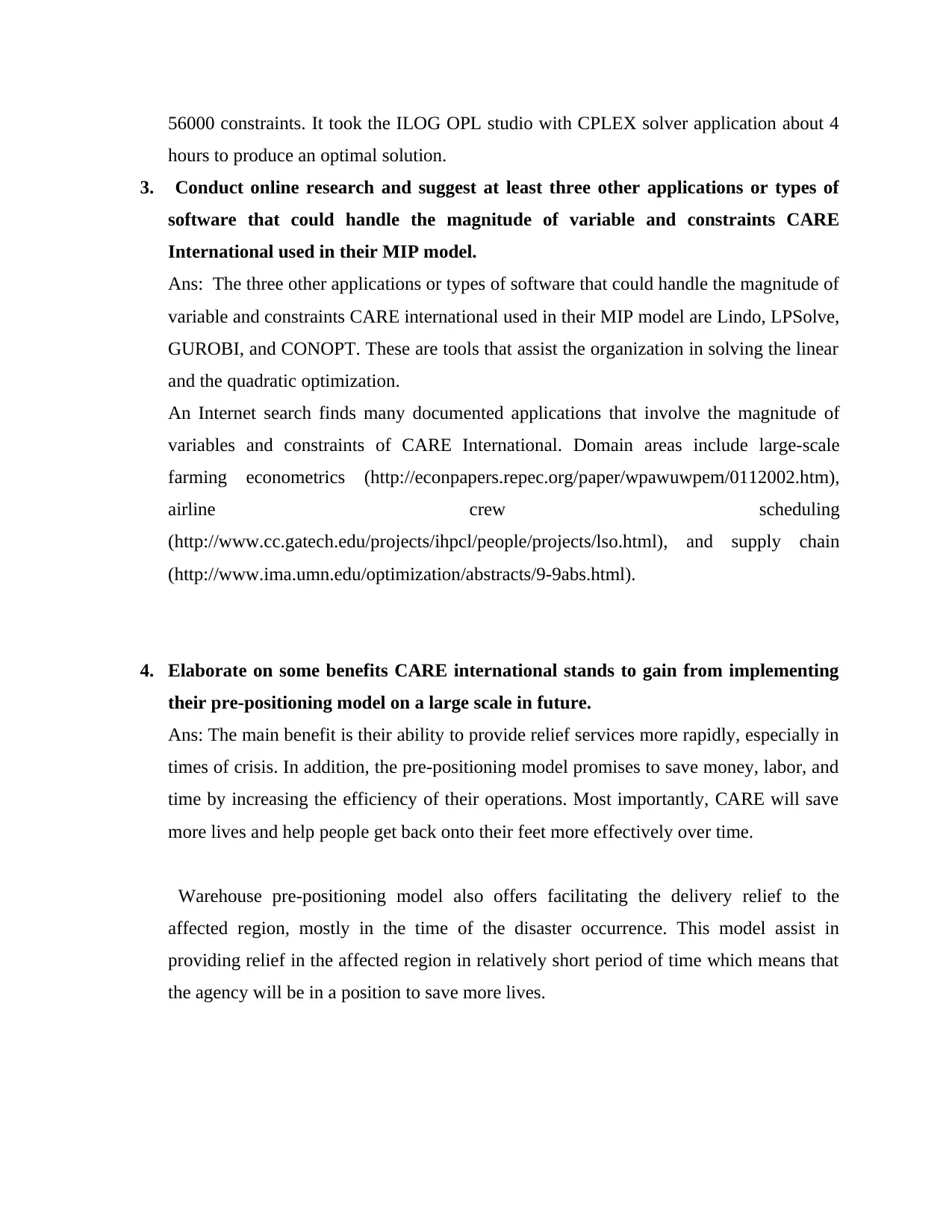
56000 constraints. It took the ILOG OPL studio with CPLEX solver application about 4
hours to produce an optimal solution.
3. Conduct online research and suggest at least three other applications or types of
software that could handle the magnitude of variable and constraints CARE
International used in their MIP model.
Ans: The three other applications or types of software that could handle the magnitude of
variable and constraints CARE international used in their MIP model are Lindo, LPSolve,
GUROBI, and CONOPT. These are tools that assist the organization in solving the linear
and the quadratic optimization.
An Internet search finds many documented applications that involve the magnitude of
variables and constraints of CARE International. Domain areas include large-scale
farming econometrics (http://econpapers.repec.org/paper/wpawuwpem/0112002.htm),
airline crew scheduling
(http://www.cc.gatech.edu/projects/ihpcl/people/projects/lso.html), and supply chain
(http://www.ima.umn.edu/optimization/abstracts/9-9abs.html).
4. Elaborate on some benefits CARE international stands to gain from implementing
their pre-positioning model on a large scale in future.
Ans: The main benefit is their ability to provide relief services more rapidly, especially in
times of crisis. In addition, the pre-positioning model promises to save money, labor, and
time by increasing the efficiency of their operations. Most importantly, CARE will save
more lives and help people get back onto their feet more effectively over time.
Warehouse pre-positioning model also offers facilitating the delivery relief to the
affected region, mostly in the time of the disaster occurrence. This model assist in
providing relief in the affected region in relatively short period of time which means that
the agency will be in a position to save more lives.
hours to produce an optimal solution.
3. Conduct online research and suggest at least three other applications or types of
software that could handle the magnitude of variable and constraints CARE
International used in their MIP model.
Ans: The three other applications or types of software that could handle the magnitude of
variable and constraints CARE international used in their MIP model are Lindo, LPSolve,
GUROBI, and CONOPT. These are tools that assist the organization in solving the linear
and the quadratic optimization.
An Internet search finds many documented applications that involve the magnitude of
variables and constraints of CARE International. Domain areas include large-scale
farming econometrics (http://econpapers.repec.org/paper/wpawuwpem/0112002.htm),
airline crew scheduling
(http://www.cc.gatech.edu/projects/ihpcl/people/projects/lso.html), and supply chain
(http://www.ima.umn.edu/optimization/abstracts/9-9abs.html).
4. Elaborate on some benefits CARE international stands to gain from implementing
their pre-positioning model on a large scale in future.
Ans: The main benefit is their ability to provide relief services more rapidly, especially in
times of crisis. In addition, the pre-positioning model promises to save money, labor, and
time by increasing the efficiency of their operations. Most importantly, CARE will save
more lives and help people get back onto their feet more effectively over time.
Warehouse pre-positioning model also offers facilitating the delivery relief to the
affected region, mostly in the time of the disaster occurrence. This model assist in
providing relief in the affected region in relatively short period of time which means that
the agency will be in a position to save more lives.
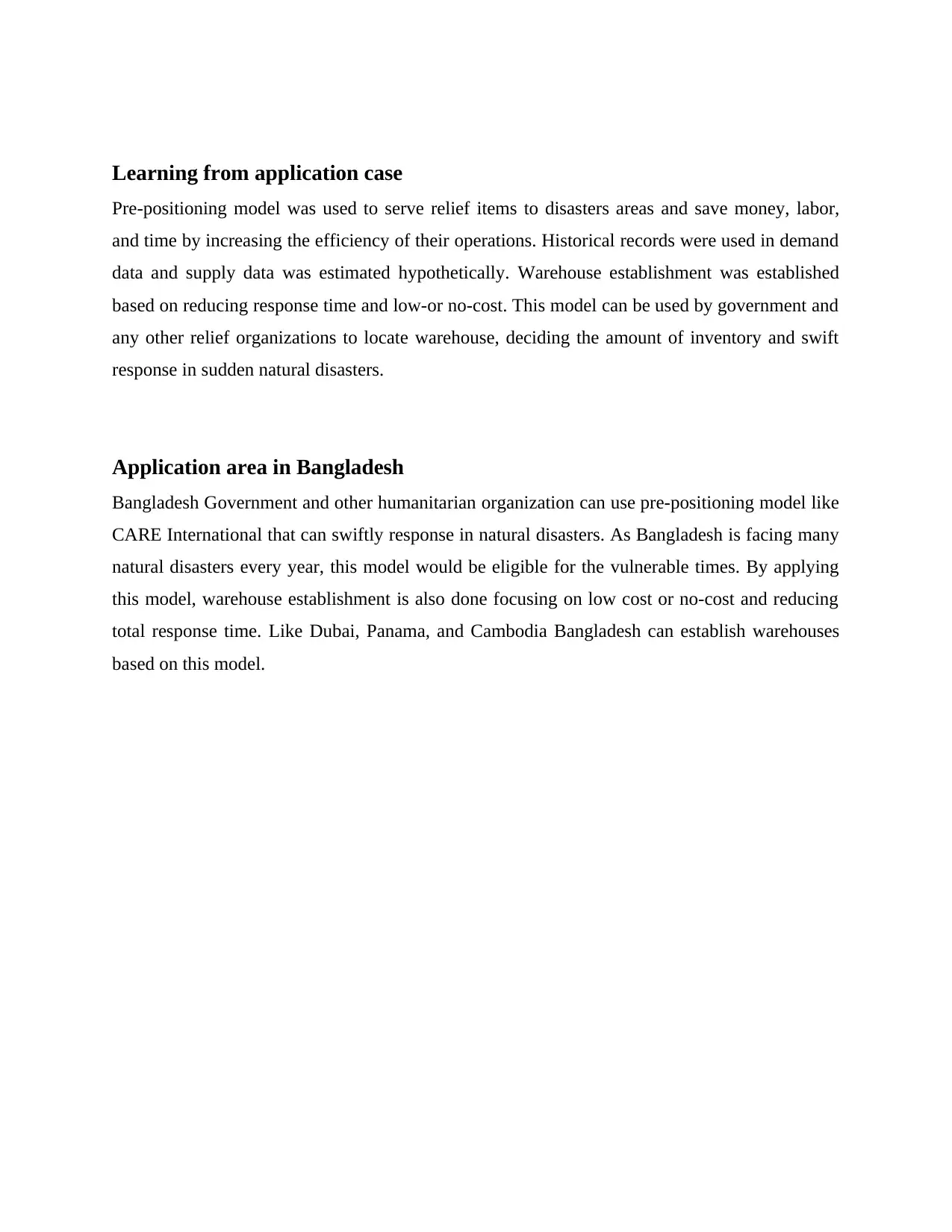
Learning from application case
Pre-positioning model was used to serve relief items to disasters areas and save money, labor,
and time by increasing the efficiency of their operations. Historical records were used in demand
data and supply data was estimated hypothetically. Warehouse establishment was established
based on reducing response time and low-or no-cost. This model can be used by government and
any other relief organizations to locate warehouse, deciding the amount of inventory and swift
response in sudden natural disasters.
Application area in Bangladesh
Bangladesh Government and other humanitarian organization can use pre-positioning model like
CARE International that can swiftly response in natural disasters. As Bangladesh is facing many
natural disasters every year, this model would be eligible for the vulnerable times. By applying
this model, warehouse establishment is also done focusing on low cost or no-cost and reducing
total response time. Like Dubai, Panama, and Cambodia Bangladesh can establish warehouses
based on this model.
Pre-positioning model was used to serve relief items to disasters areas and save money, labor,
and time by increasing the efficiency of their operations. Historical records were used in demand
data and supply data was estimated hypothetically. Warehouse establishment was established
based on reducing response time and low-or no-cost. This model can be used by government and
any other relief organizations to locate warehouse, deciding the amount of inventory and swift
response in sudden natural disasters.
Application area in Bangladesh
Bangladesh Government and other humanitarian organization can use pre-positioning model like
CARE International that can swiftly response in natural disasters. As Bangladesh is facing many
natural disasters every year, this model would be eligible for the vulnerable times. By applying
this model, warehouse establishment is also done focusing on low cost or no-cost and reducing
total response time. Like Dubai, Panama, and Cambodia Bangladesh can establish warehouses
based on this model.
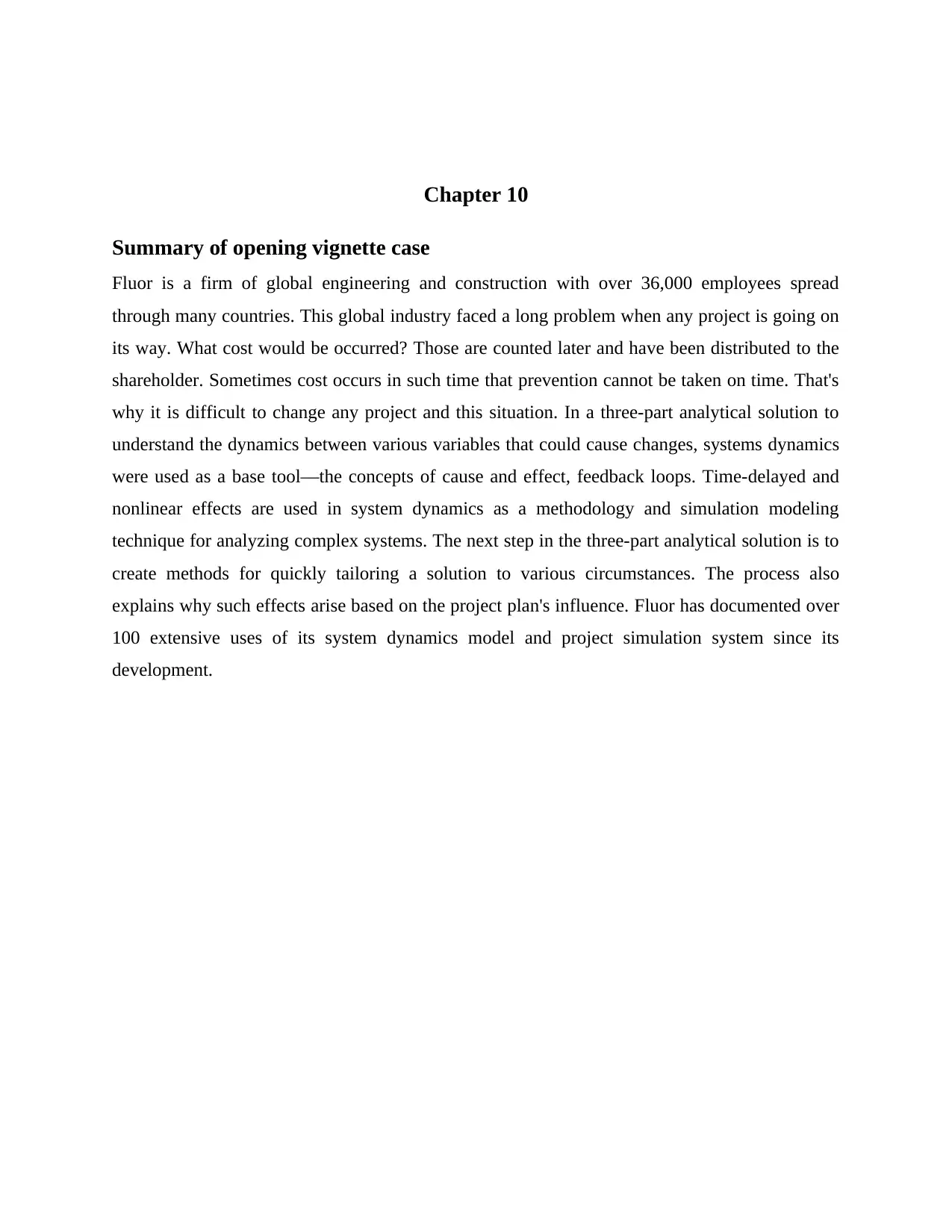
Chapter 10
Summary of opening vignette case
Fluor is a firm of global engineering and construction with over 36,000 employees spread
through many countries. This global industry faced a long problem when any project is going on
its way. What cost would be occurred? Those are counted later and have been distributed to the
shareholder. Sometimes cost occurs in such time that prevention cannot be taken on time. That's
why it is difficult to change any project and this situation. In a three-part analytical solution to
understand the dynamics between various variables that could cause changes, systems dynamics
were used as a base tool—the concepts of cause and effect, feedback loops. Time-delayed and
nonlinear effects are used in system dynamics as a methodology and simulation modeling
technique for analyzing complex systems. The next step in the three-part analytical solution is to
create methods for quickly tailoring a solution to various circumstances. The process also
explains why such effects arise based on the project plan's influence. Fluor has documented over
100 extensive uses of its system dynamics model and project simulation system since its
development.
Summary of opening vignette case
Fluor is a firm of global engineering and construction with over 36,000 employees spread
through many countries. This global industry faced a long problem when any project is going on
its way. What cost would be occurred? Those are counted later and have been distributed to the
shareholder. Sometimes cost occurs in such time that prevention cannot be taken on time. That's
why it is difficult to change any project and this situation. In a three-part analytical solution to
understand the dynamics between various variables that could cause changes, systems dynamics
were used as a base tool—the concepts of cause and effect, feedback loops. Time-delayed and
nonlinear effects are used in system dynamics as a methodology and simulation modeling
technique for analyzing complex systems. The next step in the three-part analytical solution is to
create methods for quickly tailoring a solution to various circumstances. The process also
explains why such effects arise based on the project plan's influence. Fluor has documented over
100 extensive uses of its system dynamics model and project simulation system since its
development.
Paraphrase This Document
Need a fresh take? Get an instant paraphrase of this document with our AI Paraphraser
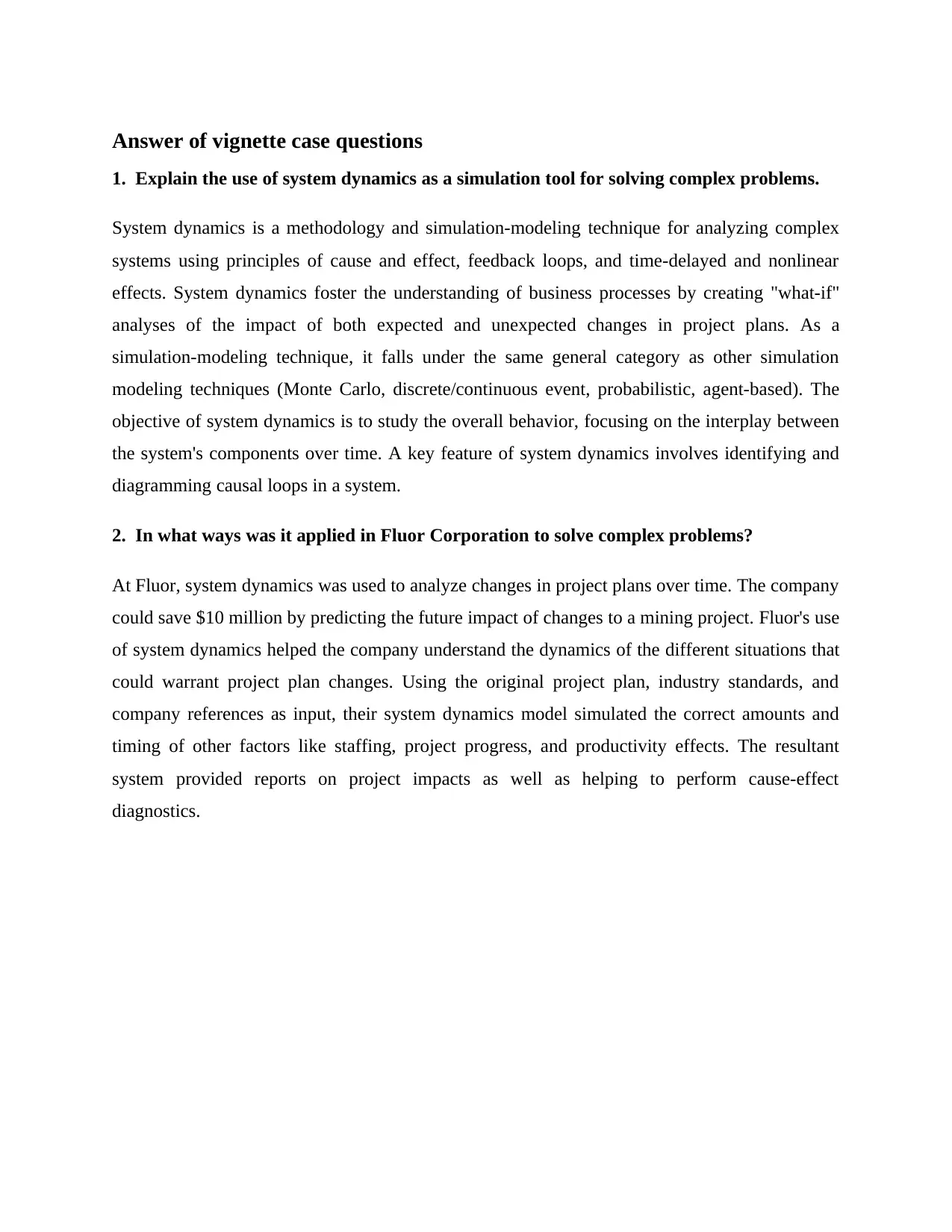
Answer of vignette case questions
1. Explain the use of system dynamics as a simulation tool for solving complex problems.
System dynamics is a methodology and simulation-modeling technique for analyzing complex
systems using principles of cause and effect, feedback loops, and time-delayed and nonlinear
effects. System dynamics foster the understanding of business processes by creating "what-if"
analyses of the impact of both expected and unexpected changes in project plans. As a
simulation-modeling technique, it falls under the same general category as other simulation
modeling techniques (Monte Carlo, discrete/continuous event, probabilistic, agent-based). The
objective of system dynamics is to study the overall behavior, focusing on the interplay between
the system's components over time. A key feature of system dynamics involves identifying and
diagramming causal loops in a system.
2. In what ways was it applied in Fluor Corporation to solve complex problems?
At Fluor, system dynamics was used to analyze changes in project plans over time. The company
could save $10 million by predicting the future impact of changes to a mining project. Fluor's use
of system dynamics helped the company understand the dynamics of the different situations that
could warrant project plan changes. Using the original project plan, industry standards, and
company references as input, their system dynamics model simulated the correct amounts and
timing of other factors like staffing, project progress, and productivity effects. The resultant
system provided reports on project impacts as well as helping to perform cause-effect
diagnostics.
1. Explain the use of system dynamics as a simulation tool for solving complex problems.
System dynamics is a methodology and simulation-modeling technique for analyzing complex
systems using principles of cause and effect, feedback loops, and time-delayed and nonlinear
effects. System dynamics foster the understanding of business processes by creating "what-if"
analyses of the impact of both expected and unexpected changes in project plans. As a
simulation-modeling technique, it falls under the same general category as other simulation
modeling techniques (Monte Carlo, discrete/continuous event, probabilistic, agent-based). The
objective of system dynamics is to study the overall behavior, focusing on the interplay between
the system's components over time. A key feature of system dynamics involves identifying and
diagramming causal loops in a system.
2. In what ways was it applied in Fluor Corporation to solve complex problems?
At Fluor, system dynamics was used to analyze changes in project plans over time. The company
could save $10 million by predicting the future impact of changes to a mining project. Fluor's use
of system dynamics helped the company understand the dynamics of the different situations that
could warrant project plan changes. Using the original project plan, industry standards, and
company references as input, their system dynamics model simulated the correct amounts and
timing of other factors like staffing, project progress, and productivity effects. The resultant
system provided reports on project impacts as well as helping to perform cause-effect
diagnostics.
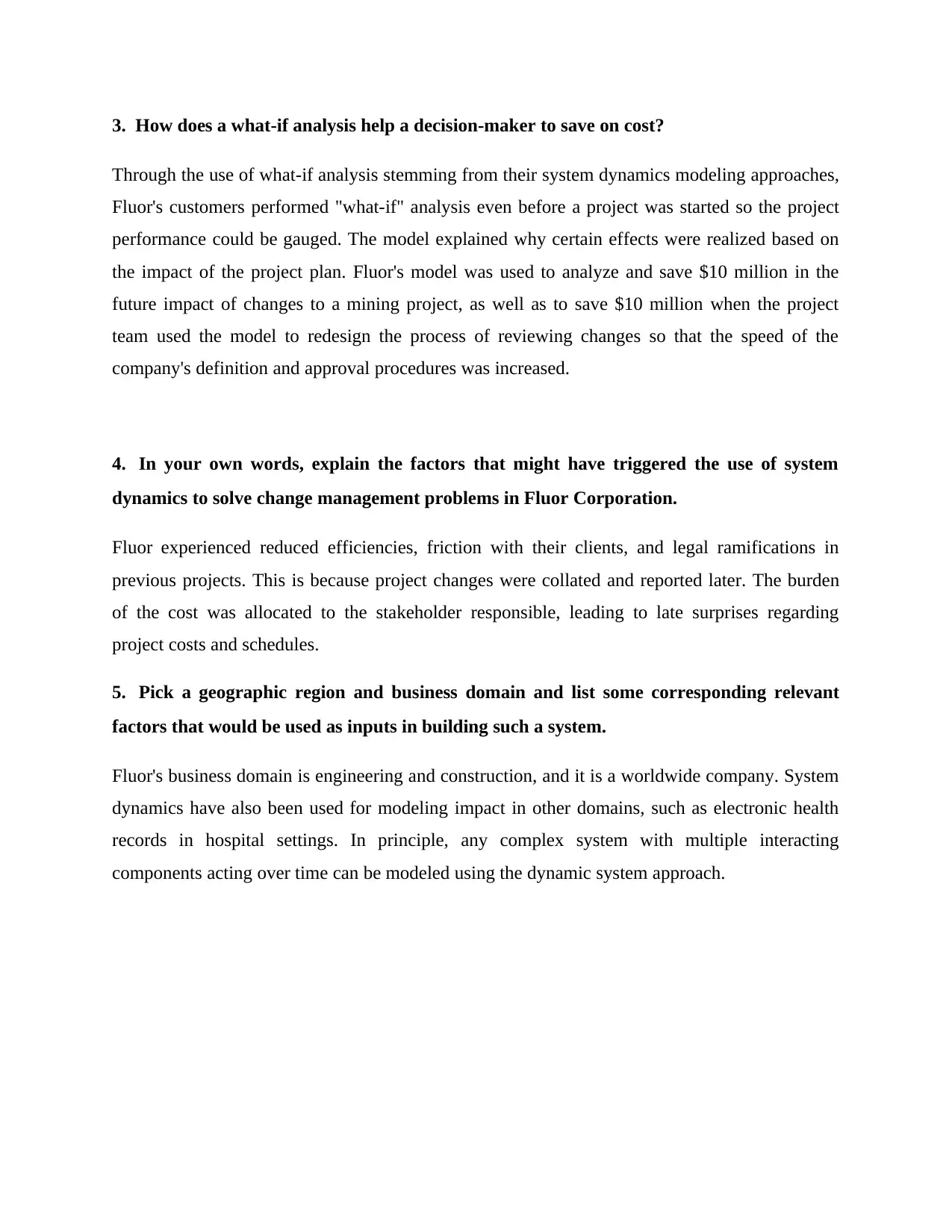
3. How does a what-if analysis help a decision-maker to save on cost?
Through the use of what-if analysis stemming from their system dynamics modeling approaches,
Fluor's customers performed "what-if" analysis even before a project was started so the project
performance could be gauged. The model explained why certain effects were realized based on
the impact of the project plan. Fluor's model was used to analyze and save $10 million in the
future impact of changes to a mining project, as well as to save $10 million when the project
team used the model to redesign the process of reviewing changes so that the speed of the
company's definition and approval procedures was increased.
4. In your own words, explain the factors that might have triggered the use of system
dynamics to solve change management problems in Fluor Corporation.
Fluor experienced reduced efficiencies, friction with their clients, and legal ramifications in
previous projects. This is because project changes were collated and reported later. The burden
of the cost was allocated to the stakeholder responsible, leading to late surprises regarding
project costs and schedules.
5. Pick a geographic region and business domain and list some corresponding relevant
factors that would be used as inputs in building such a system.
Fluor's business domain is engineering and construction, and it is a worldwide company. System
dynamics have also been used for modeling impact in other domains, such as electronic health
records in hospital settings. In principle, any complex system with multiple interacting
components acting over time can be modeled using the dynamic system approach.
Through the use of what-if analysis stemming from their system dynamics modeling approaches,
Fluor's customers performed "what-if" analysis even before a project was started so the project
performance could be gauged. The model explained why certain effects were realized based on
the impact of the project plan. Fluor's model was used to analyze and save $10 million in the
future impact of changes to a mining project, as well as to save $10 million when the project
team used the model to redesign the process of reviewing changes so that the speed of the
company's definition and approval procedures was increased.
4. In your own words, explain the factors that might have triggered the use of system
dynamics to solve change management problems in Fluor Corporation.
Fluor experienced reduced efficiencies, friction with their clients, and legal ramifications in
previous projects. This is because project changes were collated and reported later. The burden
of the cost was allocated to the stakeholder responsible, leading to late surprises regarding
project costs and schedules.
5. Pick a geographic region and business domain and list some corresponding relevant
factors that would be used as inputs in building such a system.
Fluor's business domain is engineering and construction, and it is a worldwide company. System
dynamics have also been used for modeling impact in other domains, such as electronic health
records in hospital settings. In principle, any complex system with multiple interacting
components acting over time can be modeled using the dynamic system approach.

Learning from opening vignette case
Changes to project plans and timelines are a major contributing factor to the upward increase in
cost from the initial amount budgeted for projects. In this case, Fluor relied on system dynamics
to understand what, why, when, and how changes occurred to project plans. The models that the
system dynamics model produced helped them correctly quantify the cost of projects even before
they started. The vignette demonstrates that system dynamics is still a credible and robust
methodology in understanding business processes and creating "what-if' analyses of the impact
of both expected and unexpected changes in project plans.
Application area in Bangladesh
There is growing recognition of the complexity that underlies environmental health problems and
their management. With it, there is a need for sound environmental health policy and decision-
making that embraces this complexity. System dynamics involves causal mapping and the
development of computer simulation to understand system behavior. Policy and scenario options
are then systematically tested to answer "what-if" questions. This allows policy-makers to
experiment with their decisions before implementation in the real world. This decision-
experimentation creates a learning environment in which policy-makers understand how the
system will respond to their choices and the potential unintended consequences of decisions.
Changes to project plans and timelines are a major contributing factor to the upward increase in
cost from the initial amount budgeted for projects. In this case, Fluor relied on system dynamics
to understand what, why, when, and how changes occurred to project plans. The models that the
system dynamics model produced helped them correctly quantify the cost of projects even before
they started. The vignette demonstrates that system dynamics is still a credible and robust
methodology in understanding business processes and creating "what-if' analyses of the impact
of both expected and unexpected changes in project plans.
Application area in Bangladesh
There is growing recognition of the complexity that underlies environmental health problems and
their management. With it, there is a need for sound environmental health policy and decision-
making that embraces this complexity. System dynamics involves causal mapping and the
development of computer simulation to understand system behavior. Policy and scenario options
are then systematically tested to answer "what-if" questions. This allows policy-makers to
experiment with their decisions before implementation in the real world. This decision-
experimentation creates a learning environment in which policy-makers understand how the
system will respond to their choices and the potential unintended consequences of decisions.
Secure Best Marks with AI Grader
Need help grading? Try our AI Grader for instant feedback on your assignments.
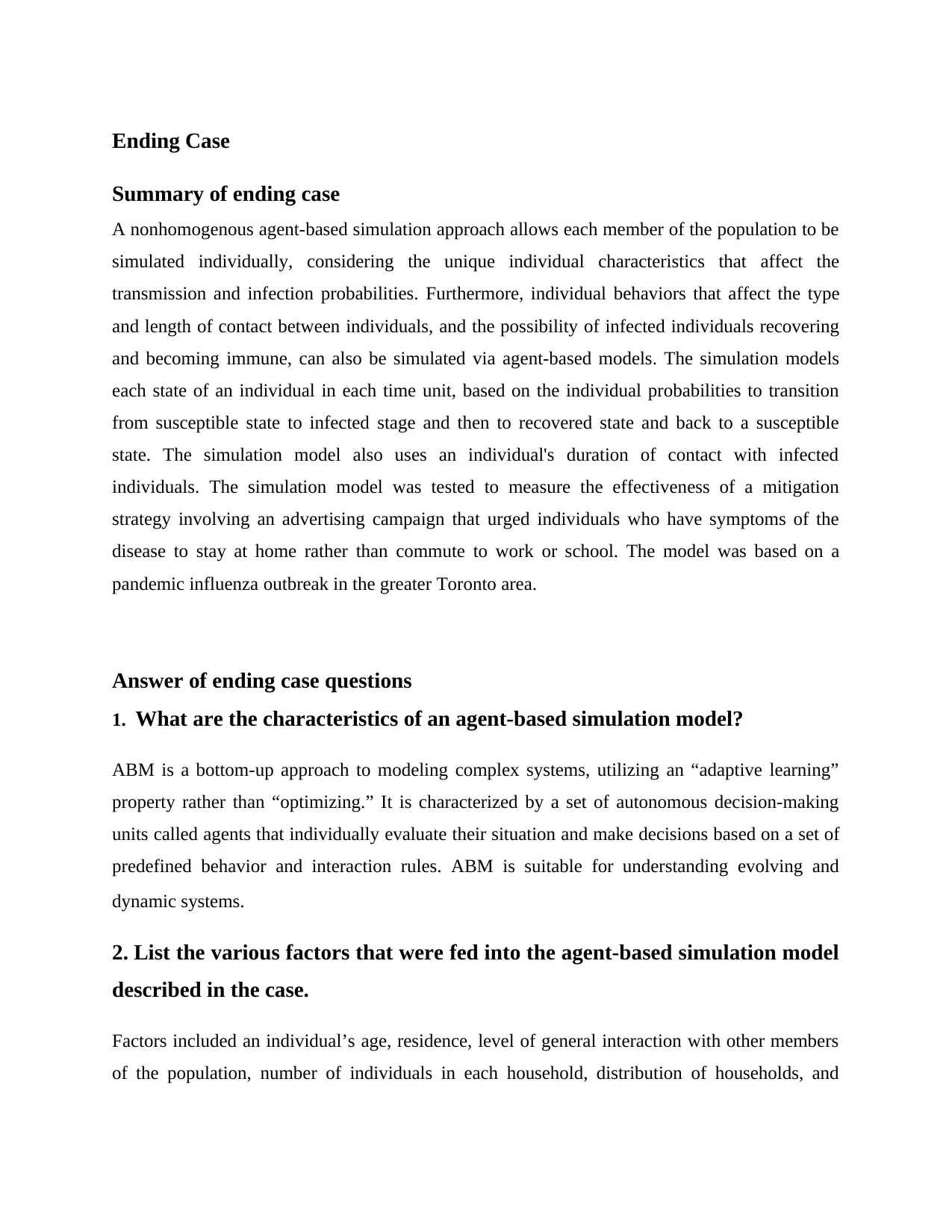
Ending Case
Summary of ending case
A nonhomogenous agent-based simulation approach allows each member of the population to be
simulated individually, considering the unique individual characteristics that affect the
transmission and infection probabilities. Furthermore, individual behaviors that affect the type
and length of contact between individuals, and the possibility of infected individuals recovering
and becoming immune, can also be simulated via agent-based models. The simulation models
each state of an individual in each time unit, based on the individual probabilities to transition
from susceptible state to infected stage and then to recovered state and back to a susceptible
state. The simulation model also uses an individual's duration of contact with infected
individuals. The simulation model was tested to measure the effectiveness of a mitigation
strategy involving an advertising campaign that urged individuals who have symptoms of the
disease to stay at home rather than commute to work or school. The model was based on a
pandemic influenza outbreak in the greater Toronto area.
Answer of ending case questions
1. What are the characteristics of an agent-based simulation model?
ABM is a bottom-up approach to modeling complex systems, utilizing an “adaptive learning”
property rather than “optimizing.” It is characterized by a set of autonomous decision-making
units called agents that individually evaluate their situation and make decisions based on a set of
predefined behavior and interaction rules. ABM is suitable for understanding evolving and
dynamic systems.
2. List the various factors that were fed into the agent-based simulation model
described in the case.
Factors included an individual’s age, residence, level of general interaction with other members
of the population, number of individuals in each household, distribution of households, and
Summary of ending case
A nonhomogenous agent-based simulation approach allows each member of the population to be
simulated individually, considering the unique individual characteristics that affect the
transmission and infection probabilities. Furthermore, individual behaviors that affect the type
and length of contact between individuals, and the possibility of infected individuals recovering
and becoming immune, can also be simulated via agent-based models. The simulation models
each state of an individual in each time unit, based on the individual probabilities to transition
from susceptible state to infected stage and then to recovered state and back to a susceptible
state. The simulation model also uses an individual's duration of contact with infected
individuals. The simulation model was tested to measure the effectiveness of a mitigation
strategy involving an advertising campaign that urged individuals who have symptoms of the
disease to stay at home rather than commute to work or school. The model was based on a
pandemic influenza outbreak in the greater Toronto area.
Answer of ending case questions
1. What are the characteristics of an agent-based simulation model?
ABM is a bottom-up approach to modeling complex systems, utilizing an “adaptive learning”
property rather than “optimizing.” It is characterized by a set of autonomous decision-making
units called agents that individually evaluate their situation and make decisions based on a set of
predefined behavior and interaction rules. ABM is suitable for understanding evolving and
dynamic systems.
2. List the various factors that were fed into the agent-based simulation model
described in the case.
Factors included an individual’s age, residence, level of general interaction with other members
of the population, number of individuals in each household, distribution of households, and

behavioral aspects involving daily commutes, attendance at schools, and asymptotic period of the
disease.
3. Elaborate on the benefits of using agent-based simulation models.
ABMs are better at dealing with heterogeneous behavior, and they allow each member of the
population to be simulated individually. These models enhance the support for policy decision-
making.
4. Besides disease prevention, in which other situations could agent-based
simulations be employed?
Agent-based simulations can be used for many applications. ABMs have been used to simulate
flocks of birds, social dynamics of science, traffic jams and crowd behavior, ant colonies,
financial contagion, movements of ancient societies, housing segregation and other urban issues,
and operations management problems. ABMs are viable for business problems in which many
interrelated factors, irregular data, and high uncertainty and emergent behaviors exist,
interactions between agents are complex, discrete, or nonlinear, and the population is
heterogeneous
disease.
3. Elaborate on the benefits of using agent-based simulation models.
ABMs are better at dealing with heterogeneous behavior, and they allow each member of the
population to be simulated individually. These models enhance the support for policy decision-
making.
4. Besides disease prevention, in which other situations could agent-based
simulations be employed?
Agent-based simulations can be used for many applications. ABMs have been used to simulate
flocks of birds, social dynamics of science, traffic jams and crowd behavior, ant colonies,
financial contagion, movements of ancient societies, housing segregation and other urban issues,
and operations management problems. ABMs are viable for business problems in which many
interrelated factors, irregular data, and high uncertainty and emergent behaviors exist,
interactions between agents are complex, discrete, or nonlinear, and the population is
heterogeneous
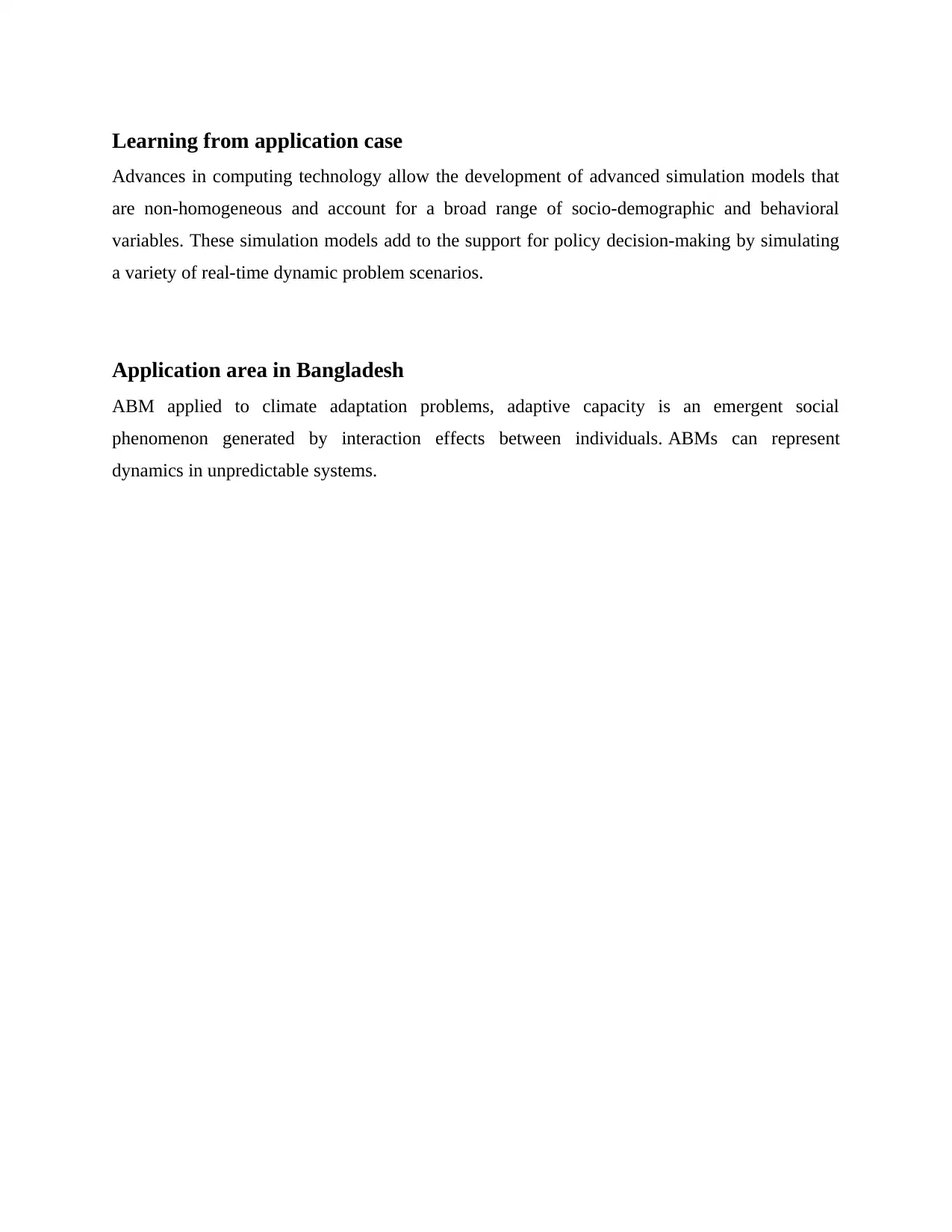
Learning from application case
Advances in computing technology allow the development of advanced simulation models that
are non-homogeneous and account for a broad range of socio-demographic and behavioral
variables. These simulation models add to the support for policy decision-making by simulating
a variety of real-time dynamic problem scenarios.
Application area in Bangladesh
ABM applied to climate adaptation problems, adaptive capacity is an emergent social
phenomenon generated by interaction effects between individuals. ABMs can represent
dynamics in unpredictable systems.
Advances in computing technology allow the development of advanced simulation models that
are non-homogeneous and account for a broad range of socio-demographic and behavioral
variables. These simulation models add to the support for policy decision-making by simulating
a variety of real-time dynamic problem scenarios.
Application area in Bangladesh
ABM applied to climate adaptation problems, adaptive capacity is an emergent social
phenomenon generated by interaction effects between individuals. ABMs can represent
dynamics in unpredictable systems.
Paraphrase This Document
Need a fresh take? Get an instant paraphrase of this document with our AI Paraphraser

Chapter 11
Summary of opening vignette case
This case study is about the decision rules for optimal Hotel room rates of Intercontinental Hotel
group (IHG) that is the world’s largest hotel group in terms of number of rooms.
The IHG implemented the optimization model for the decision rules for optimal rates. During
development of this system, IHG faced many challenges, for example, having problems to cover
the large number of hostels under the optimization system, the project resulted in a change of
their fundamental business flow, the project sometimes resulted in higher price per day etc.
Moreover, this system included a demand forecast model, market response model, competitor
rates model, and an optimization price model where for each hotel, a price response is calculated
by the market response model based on historical data, price and competitor rates were used to
estimate the demand for rooms.
Finally, IHG’s price optimization system has been widespread adoption of the retail price
optimization model by hotel managers globally is packaged in a Web application called
PERFORM.
Answer of vignette case questions
1. Describe the challenges faced by IHG during development of their retail
price Optimization system.
The challenges faced by IHG during development of their retail price
Optimization system are given below:
Having problems to cover the large number of hostels under the optimization system.
The project resulted in a change of their fundamental business flow.
The project sometimes resulted in higher price per day.
The project resulted in a variety of influences in their normal routines work to fix prices.
2. Besides the hotel business in the hospitality industry, explain at least three
other areas where an optimization model could be used.
Summary of opening vignette case
This case study is about the decision rules for optimal Hotel room rates of Intercontinental Hotel
group (IHG) that is the world’s largest hotel group in terms of number of rooms.
The IHG implemented the optimization model for the decision rules for optimal rates. During
development of this system, IHG faced many challenges, for example, having problems to cover
the large number of hostels under the optimization system, the project resulted in a change of
their fundamental business flow, the project sometimes resulted in higher price per day etc.
Moreover, this system included a demand forecast model, market response model, competitor
rates model, and an optimization price model where for each hotel, a price response is calculated
by the market response model based on historical data, price and competitor rates were used to
estimate the demand for rooms.
Finally, IHG’s price optimization system has been widespread adoption of the retail price
optimization model by hotel managers globally is packaged in a Web application called
PERFORM.
Answer of vignette case questions
1. Describe the challenges faced by IHG during development of their retail
price Optimization system.
The challenges faced by IHG during development of their retail price
Optimization system are given below:
Having problems to cover the large number of hostels under the optimization system.
The project resulted in a change of their fundamental business flow.
The project sometimes resulted in higher price per day.
The project resulted in a variety of influences in their normal routines work to fix prices.
2. Besides the hotel business in the hospitality industry, explain at least three
other areas where an optimization model could be used.
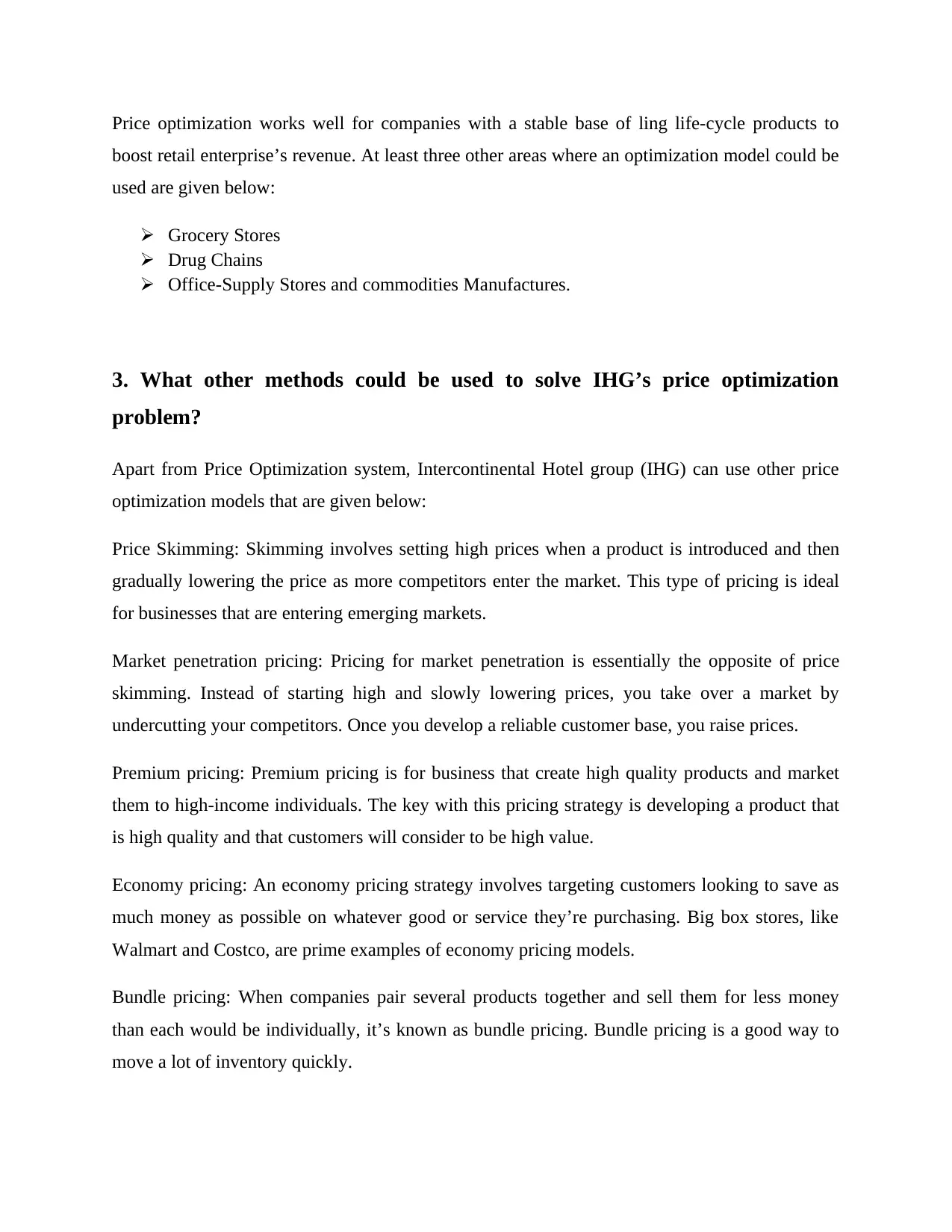
Price optimization works well for companies with a stable base of ling life-cycle products to
boost retail enterprise’s revenue. At least three other areas where an optimization model could be
used are given below:
Grocery Stores
Drug Chains
Office-Supply Stores and commodities Manufactures.
3. What other methods could be used to solve IHG’s price optimization
problem?
Apart from Price Optimization system, Intercontinental Hotel group (IHG) can use other price
optimization models that are given below:
Price Skimming: Skimming involves setting high prices when a product is introduced and then
gradually lowering the price as more competitors enter the market. This type of pricing is ideal
for businesses that are entering emerging markets.
Market penetration pricing: Pricing for market penetration is essentially the opposite of price
skimming. Instead of starting high and slowly lowering prices, you take over a market by
undercutting your competitors. Once you develop a reliable customer base, you raise prices.
Premium pricing: Premium pricing is for business that create high quality products and market
them to high-income individuals. The key with this pricing strategy is developing a product that
is high quality and that customers will consider to be high value.
Economy pricing: An economy pricing strategy involves targeting customers looking to save as
much money as possible on whatever good or service they’re purchasing. Big box stores, like
Walmart and Costco, are prime examples of economy pricing models.
Bundle pricing: When companies pair several products together and sell them for less money
than each would be individually, it’s known as bundle pricing. Bundle pricing is a good way to
move a lot of inventory quickly.
boost retail enterprise’s revenue. At least three other areas where an optimization model could be
used are given below:
Grocery Stores
Drug Chains
Office-Supply Stores and commodities Manufactures.
3. What other methods could be used to solve IHG’s price optimization
problem?
Apart from Price Optimization system, Intercontinental Hotel group (IHG) can use other price
optimization models that are given below:
Price Skimming: Skimming involves setting high prices when a product is introduced and then
gradually lowering the price as more competitors enter the market. This type of pricing is ideal
for businesses that are entering emerging markets.
Market penetration pricing: Pricing for market penetration is essentially the opposite of price
skimming. Instead of starting high and slowly lowering prices, you take over a market by
undercutting your competitors. Once you develop a reliable customer base, you raise prices.
Premium pricing: Premium pricing is for business that create high quality products and market
them to high-income individuals. The key with this pricing strategy is developing a product that
is high quality and that customers will consider to be high value.
Economy pricing: An economy pricing strategy involves targeting customers looking to save as
much money as possible on whatever good or service they’re purchasing. Big box stores, like
Walmart and Costco, are prime examples of economy pricing models.
Bundle pricing: When companies pair several products together and sell them for less money
than each would be individually, it’s known as bundle pricing. Bundle pricing is a good way to
move a lot of inventory quickly.
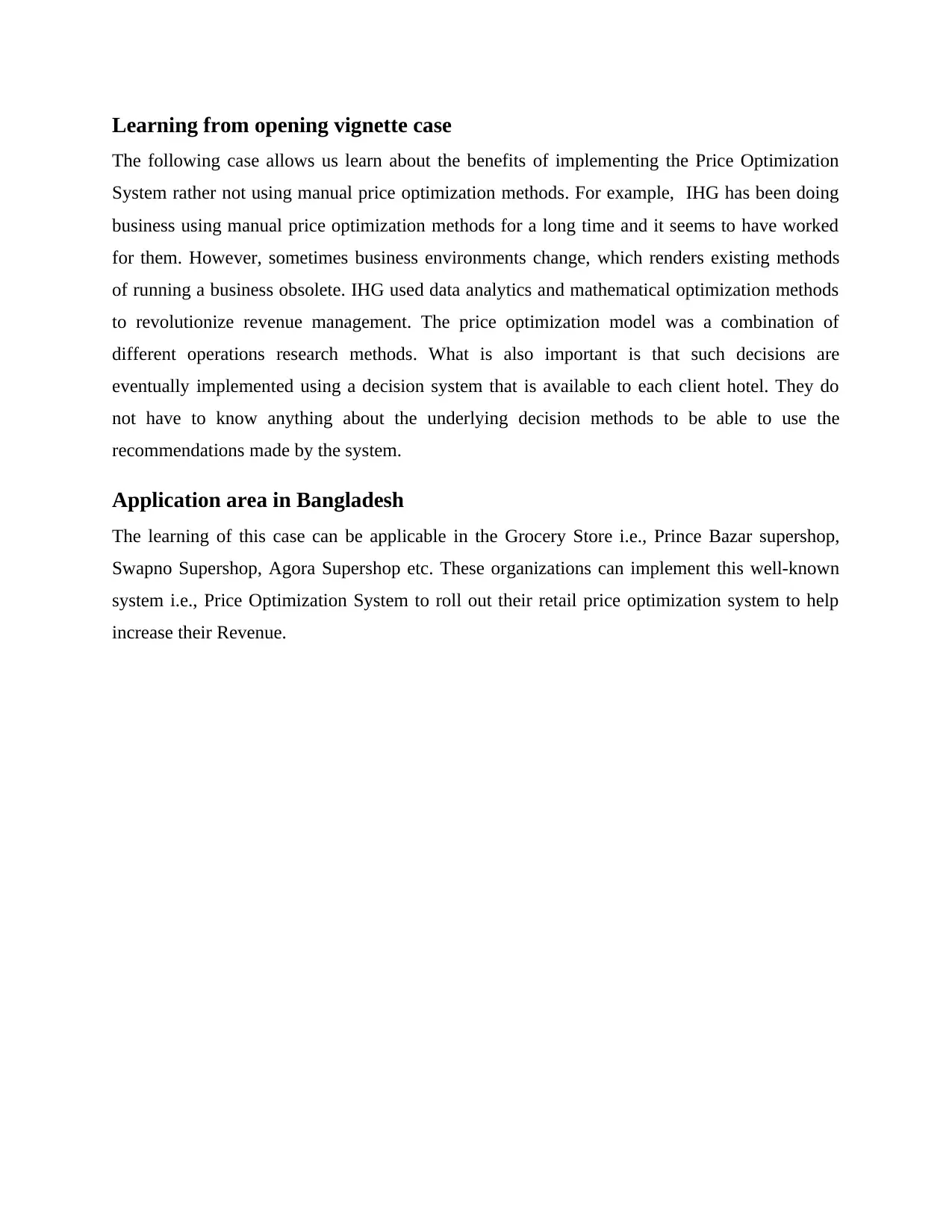
Learning from opening vignette case
The following case allows us learn about the benefits of implementing the Price Optimization
System rather not using manual price optimization methods. For example, IHG has been doing
business using manual price optimization methods for a long time and it seems to have worked
for them. However, sometimes business environments change, which renders existing methods
of running a business obsolete. IHG used data analytics and mathematical optimization methods
to revolutionize revenue management. The price optimization model was a combination of
different operations research methods. What is also important is that such decisions are
eventually implemented using a decision system that is available to each client hotel. They do
not have to know anything about the underlying decision methods to be able to use the
recommendations made by the system.
Application area in Bangladesh
The learning of this case can be applicable in the Grocery Store i.e., Prince Bazar supershop,
Swapno Supershop, Agora Supershop etc. These organizations can implement this well-known
system i.e., Price Optimization System to roll out their retail price optimization system to help
increase their Revenue.
The following case allows us learn about the benefits of implementing the Price Optimization
System rather not using manual price optimization methods. For example, IHG has been doing
business using manual price optimization methods for a long time and it seems to have worked
for them. However, sometimes business environments change, which renders existing methods
of running a business obsolete. IHG used data analytics and mathematical optimization methods
to revolutionize revenue management. The price optimization model was a combination of
different operations research methods. What is also important is that such decisions are
eventually implemented using a decision system that is available to each client hotel. They do
not have to know anything about the underlying decision methods to be able to use the
recommendations made by the system.
Application area in Bangladesh
The learning of this case can be applicable in the Grocery Store i.e., Prince Bazar supershop,
Swapno Supershop, Agora Supershop etc. These organizations can implement this well-known
system i.e., Price Optimization System to roll out their retail price optimization system to help
increase their Revenue.
Secure Best Marks with AI Grader
Need help grading? Try our AI Grader for instant feedback on your assignments.

Ending Case
Summary of Application Case
This case presents a scenario that depicts the dual use of predictive analytics and optimization in
solving real-world problems. Predictive analytics was used to determine the future tax behavior
of taxpayers based on their past behavior. Based on the delinquency status of the individual's or
corporate body's tax situation, different courses of action are followed based on established rules.
Hence, the tax agency was able to sidestep the "one-size-fits-all" policy and initiate tax collection
procedures based on what they should do to increase tax revenue, and not Just what they could
lawfully do The rule-based system was implemented using the information derived from
optimization models.
The answer of application case questions
1. What is the key difference between the former tax collection system and the
new system?
The key difference between the former tax collection system and the new system was the method
used in the collection. The former system used required many personnel and resources to be used
and the system was very difficult to implement. The existing rules were so formal that the
department always had the difficult in implementing the prescribed rules, which also require
Iong time accessing and implementing. This system was so complex that it had to be done in a
systematic way in identifying the negligent tax payers and then initiated an action on them and
the finally making sure that this law breakers payed the tax. This system was so tradition in
cation that it allowed the tax collectors to think only what should be done. Whereas, the new
system was developed in such a way that the officers were allowed to think what could be done
in collecting the taxes. The new system was designed based on analytics and utilizes
optimization processes in their working. This system included Markov Decision Process (MDP),
with a Constrained Reinforcement Learning (C-RL) method. The C- RL method allowed
different rules for different tax payers which were based upon the tax payer's previous tax paying
Summary of Application Case
This case presents a scenario that depicts the dual use of predictive analytics and optimization in
solving real-world problems. Predictive analytics was used to determine the future tax behavior
of taxpayers based on their past behavior. Based on the delinquency status of the individual's or
corporate body's tax situation, different courses of action are followed based on established rules.
Hence, the tax agency was able to sidestep the "one-size-fits-all" policy and initiate tax collection
procedures based on what they should do to increase tax revenue, and not Just what they could
lawfully do The rule-based system was implemented using the information derived from
optimization models.
The answer of application case questions
1. What is the key difference between the former tax collection system and the
new system?
The key difference between the former tax collection system and the new system was the method
used in the collection. The former system used required many personnel and resources to be used
and the system was very difficult to implement. The existing rules were so formal that the
department always had the difficult in implementing the prescribed rules, which also require
Iong time accessing and implementing. This system was so complex that it had to be done in a
systematic way in identifying the negligent tax payers and then initiated an action on them and
the finally making sure that this law breakers payed the tax. This system was so tradition in
cation that it allowed the tax collectors to think only what should be done. Whereas, the new
system was developed in such a way that the officers were allowed to think what could be done
in collecting the taxes. The new system was designed based on analytics and utilizes
optimization processes in their working. This system included Markov Decision Process (MDP),
with a Constrained Reinforcement Learning (C-RL) method. The C- RL method allowed
different rules for different tax payers which were based upon the tax payer's previous tax paying
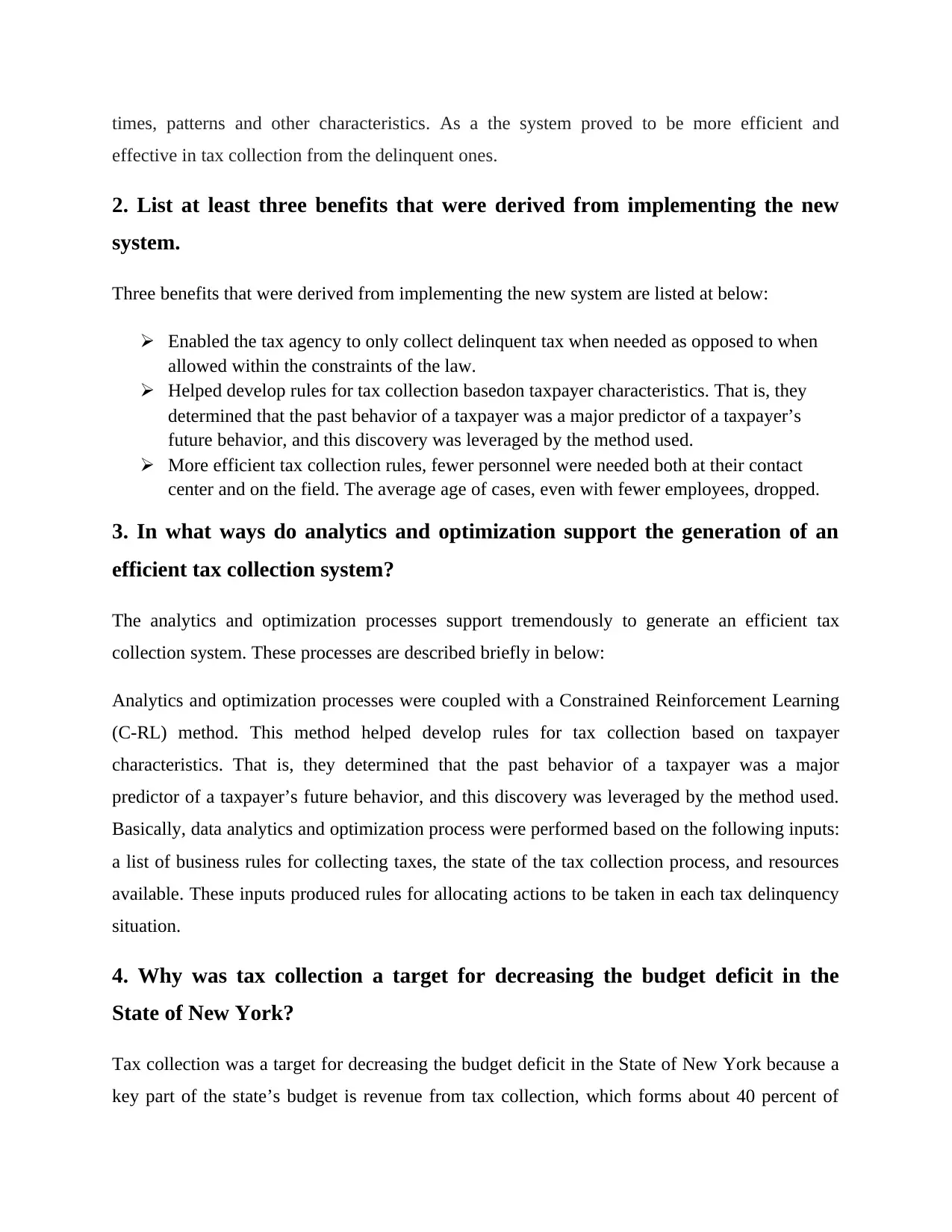
times, patterns and other characteristics. As a the system proved to be more efficient and
effective in tax collection from the delinquent ones.
2. List at least three benefits that were derived from implementing the new
system.
Three benefits that were derived from implementing the new system are listed at below:
Enabled the tax agency to only collect delinquent tax when needed as opposed to when
allowed within the constraints of the law.
Helped develop rules for tax collection basedon taxpayer characteristics. That is, they
determined that the past behavior of a taxpayer was a major predictor of a taxpayer’s
future behavior, and this discovery was leveraged by the method used.
More efficient tax collection rules, fewer personnel were needed both at their contact
center and on the field. The average age of cases, even with fewer employees, dropped.
3. In what ways do analytics and optimization support the generation of an
efficient tax collection system?
The analytics and optimization processes support tremendously to generate an efficient tax
collection system. These processes are described briefly in below:
Analytics and optimization processes were coupled with a Constrained Reinforcement Learning
(C-RL) method. This method helped develop rules for tax collection based on taxpayer
characteristics. That is, they determined that the past behavior of a taxpayer was a major
predictor of a taxpayer’s future behavior, and this discovery was leveraged by the method used.
Basically, data analytics and optimization process were performed based on the following inputs:
a list of business rules for collecting taxes, the state of the tax collection process, and resources
available. These inputs produced rules for allocating actions to be taken in each tax delinquency
situation.
4. Why was tax collection a target for decreasing the budget deficit in the
State of New York?
Tax collection was a target for decreasing the budget deficit in the State of New York because a
key part of the state’s budget is revenue from tax collection, which forms about 40 percent of
effective in tax collection from the delinquent ones.
2. List at least three benefits that were derived from implementing the new
system.
Three benefits that were derived from implementing the new system are listed at below:
Enabled the tax agency to only collect delinquent tax when needed as opposed to when
allowed within the constraints of the law.
Helped develop rules for tax collection basedon taxpayer characteristics. That is, they
determined that the past behavior of a taxpayer was a major predictor of a taxpayer’s
future behavior, and this discovery was leveraged by the method used.
More efficient tax collection rules, fewer personnel were needed both at their contact
center and on the field. The average age of cases, even with fewer employees, dropped.
3. In what ways do analytics and optimization support the generation of an
efficient tax collection system?
The analytics and optimization processes support tremendously to generate an efficient tax
collection system. These processes are described briefly in below:
Analytics and optimization processes were coupled with a Constrained Reinforcement Learning
(C-RL) method. This method helped develop rules for tax collection based on taxpayer
characteristics. That is, they determined that the past behavior of a taxpayer was a major
predictor of a taxpayer’s future behavior, and this discovery was leveraged by the method used.
Basically, data analytics and optimization process were performed based on the following inputs:
a list of business rules for collecting taxes, the state of the tax collection process, and resources
available. These inputs produced rules for allocating actions to be taken in each tax delinquency
situation.
4. Why was tax collection a target for decreasing the budget deficit in the
State of New York?
Tax collection was a target for decreasing the budget deficit in the State of New York because a
key part of the state’s budget is revenue from tax collection, which forms about 40 percent of
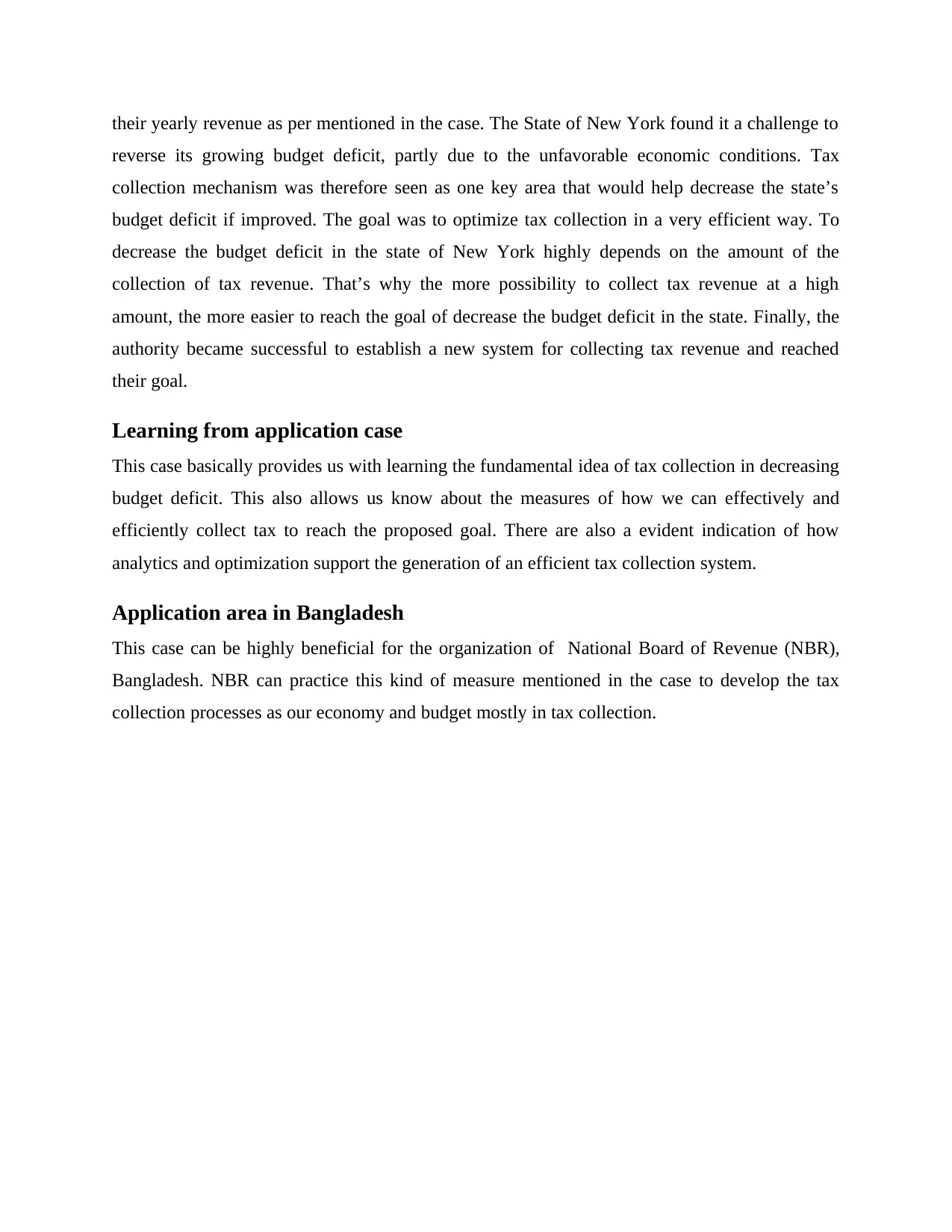
their yearly revenue as per mentioned in the case. The State of New York found it a challenge to
reverse its growing budget deficit, partly due to the unfavorable economic conditions. Tax
collection mechanism was therefore seen as one key area that would help decrease the state’s
budget deficit if improved. The goal was to optimize tax collection in a very efficient way. To
decrease the budget deficit in the state of New York highly depends on the amount of the
collection of tax revenue. That’s why the more possibility to collect tax revenue at a high
amount, the more easier to reach the goal of decrease the budget deficit in the state. Finally, the
authority became successful to establish a new system for collecting tax revenue and reached
their goal.
Learning from application case
This case basically provides us with learning the fundamental idea of tax collection in decreasing
budget deficit. This also allows us know about the measures of how we can effectively and
efficiently collect tax to reach the proposed goal. There are also a evident indication of how
analytics and optimization support the generation of an efficient tax collection system.
Application area in Bangladesh
This case can be highly beneficial for the organization of National Board of Revenue (NBR),
Bangladesh. NBR can practice this kind of measure mentioned in the case to develop the tax
collection processes as our economy and budget mostly in tax collection.
reverse its growing budget deficit, partly due to the unfavorable economic conditions. Tax
collection mechanism was therefore seen as one key area that would help decrease the state’s
budget deficit if improved. The goal was to optimize tax collection in a very efficient way. To
decrease the budget deficit in the state of New York highly depends on the amount of the
collection of tax revenue. That’s why the more possibility to collect tax revenue at a high
amount, the more easier to reach the goal of decrease the budget deficit in the state. Finally, the
authority became successful to establish a new system for collecting tax revenue and reached
their goal.
Learning from application case
This case basically provides us with learning the fundamental idea of tax collection in decreasing
budget deficit. This also allows us know about the measures of how we can effectively and
efficiently collect tax to reach the proposed goal. There are also a evident indication of how
analytics and optimization support the generation of an efficient tax collection system.
Application area in Bangladesh
This case can be highly beneficial for the organization of National Board of Revenue (NBR),
Bangladesh. NBR can practice this kind of measure mentioned in the case to develop the tax
collection processes as our economy and budget mostly in tax collection.
Paraphrase This Document
Need a fresh take? Get an instant paraphrase of this document with our AI Paraphraser
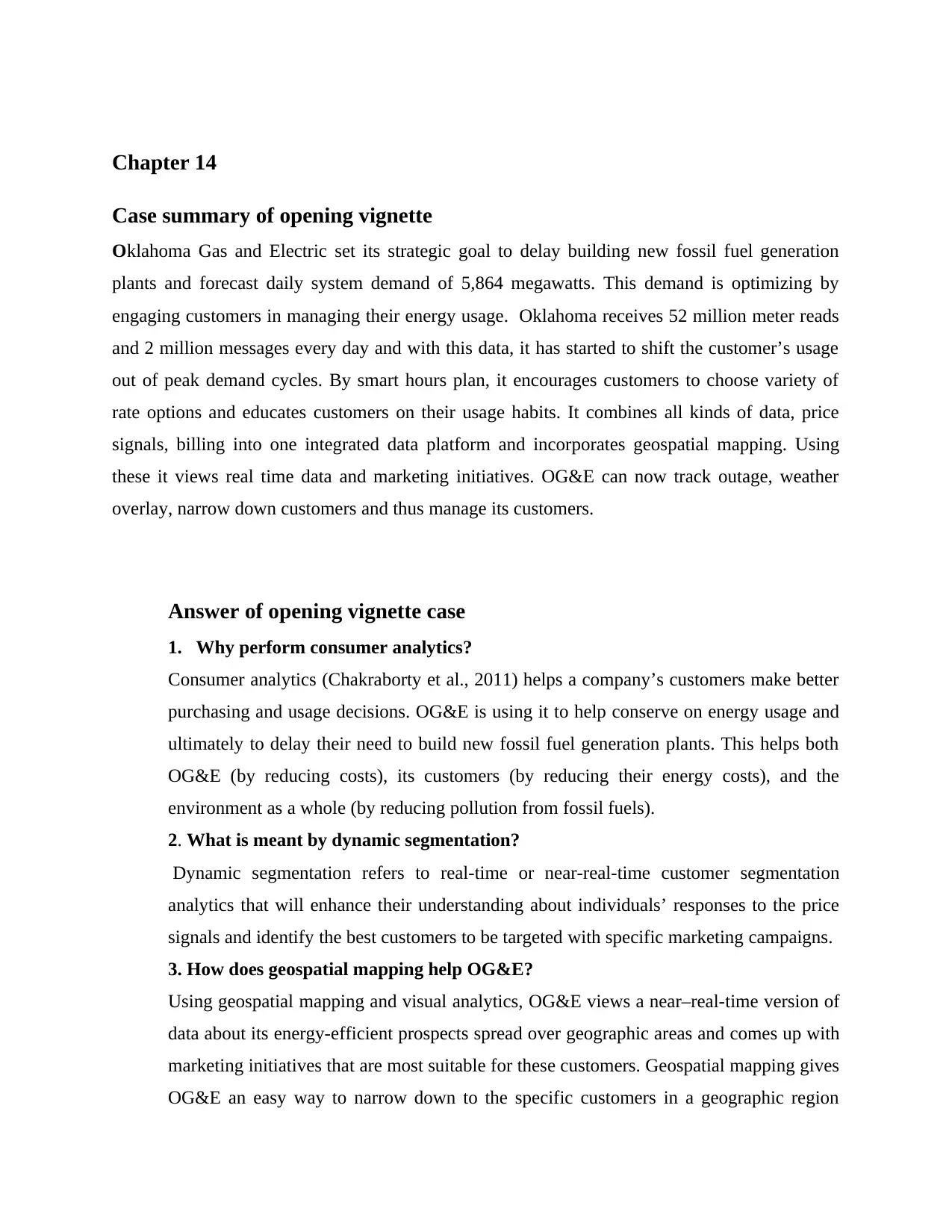
Chapter 14
Case summary of opening vignette
Oklahoma Gas and Electric set its strategic goal to delay building new fossil fuel generation
plants and forecast daily system demand of 5,864 megawatts. This demand is optimizing by
engaging customers in managing their energy usage. Oklahoma receives 52 million meter reads
and 2 million messages every day and with this data, it has started to shift the customer’s usage
out of peak demand cycles. By smart hours plan, it encourages customers to choose variety of
rate options and educates customers on their usage habits. It combines all kinds of data, price
signals, billing into one integrated data platform and incorporates geospatial mapping. Using
these it views real time data and marketing initiatives. OG&E can now track outage, weather
overlay, narrow down customers and thus manage its customers.
Answer of opening vignette case
1. Why perform consumer analytics?
Consumer analytics (Chakraborty et al., 2011) helps a company’s customers make better
purchasing and usage decisions. OG&E is using it to help conserve on energy usage and
ultimately to delay their need to build new fossil fuel generation plants. This helps both
OG&E (by reducing costs), its customers (by reducing their energy costs), and the
environment as a whole (by reducing pollution from fossil fuels).
2. What is meant by dynamic segmentation?
Dynamic segmentation refers to real-time or near-real-time customer segmentation
analytics that will enhance their understanding about individuals’ responses to the price
signals and identify the best customers to be targeted with specific marketing campaigns.
3. How does geospatial mapping help OG&E?
Using geospatial mapping and visual analytics, OG&E views a near–real-time version of
data about its energy-efficient prospects spread over geographic areas and comes up with
marketing initiatives that are most suitable for these customers. Geospatial mapping gives
OG&E an easy way to narrow down to the specific customers in a geographic region
Case summary of opening vignette
Oklahoma Gas and Electric set its strategic goal to delay building new fossil fuel generation
plants and forecast daily system demand of 5,864 megawatts. This demand is optimizing by
engaging customers in managing their energy usage. Oklahoma receives 52 million meter reads
and 2 million messages every day and with this data, it has started to shift the customer’s usage
out of peak demand cycles. By smart hours plan, it encourages customers to choose variety of
rate options and educates customers on their usage habits. It combines all kinds of data, price
signals, billing into one integrated data platform and incorporates geospatial mapping. Using
these it views real time data and marketing initiatives. OG&E can now track outage, weather
overlay, narrow down customers and thus manage its customers.
Answer of opening vignette case
1. Why perform consumer analytics?
Consumer analytics (Chakraborty et al., 2011) helps a company’s customers make better
purchasing and usage decisions. OG&E is using it to help conserve on energy usage and
ultimately to delay their need to build new fossil fuel generation plants. This helps both
OG&E (by reducing costs), its customers (by reducing their energy costs), and the
environment as a whole (by reducing pollution from fossil fuels).
2. What is meant by dynamic segmentation?
Dynamic segmentation refers to real-time or near-real-time customer segmentation
analytics that will enhance their understanding about individuals’ responses to the price
signals and identify the best customers to be targeted with specific marketing campaigns.
3. How does geospatial mapping help OG&E?
Using geospatial mapping and visual analytics, OG&E views a near–real-time version of
data about its energy-efficient prospects spread over geographic areas and comes up with
marketing initiatives that are most suitable for these customers. Geospatial mapping gives
OG&E an easy way to narrow down to the specific customers in a geographic region
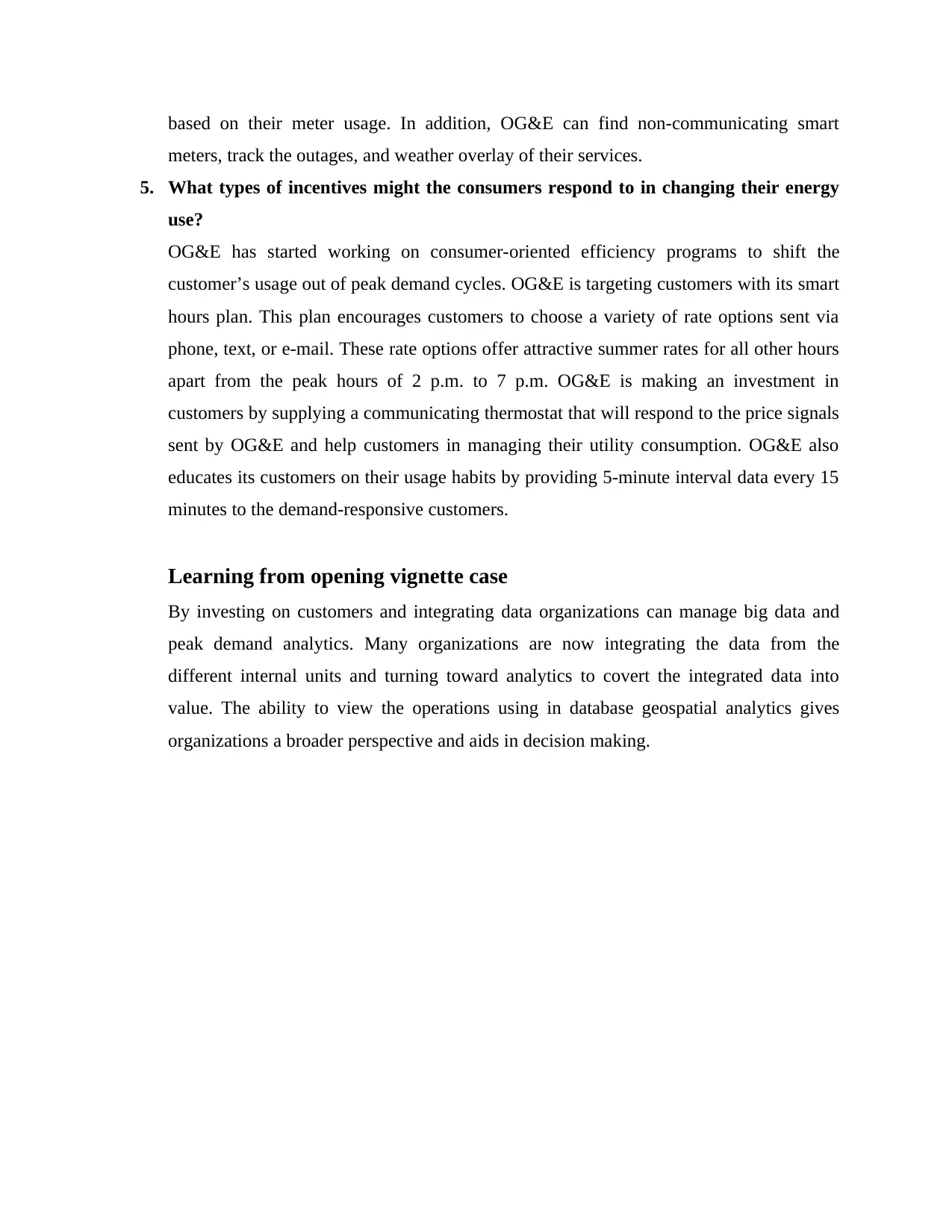
based on their meter usage. In addition, OG&E can find non-communicating smart
meters, track the outages, and weather overlay of their services.
5. What types of incentives might the consumers respond to in changing their energy
use?
OG&E has started working on consumer-oriented efficiency programs to shift the
customer’s usage out of peak demand cycles. OG&E is targeting customers with its smart
hours plan. This plan encourages customers to choose a variety of rate options sent via
phone, text, or e-mail. These rate options offer attractive summer rates for all other hours
apart from the peak hours of 2 p.m. to 7 p.m. OG&E is making an investment in
customers by supplying a communicating thermostat that will respond to the price signals
sent by OG&E and help customers in managing their utility consumption. OG&E also
educates its customers on their usage habits by providing 5-minute interval data every 15
minutes to the demand-responsive customers.
Learning from opening vignette case
By investing on customers and integrating data organizations can manage big data and
peak demand analytics. Many organizations are now integrating the data from the
different internal units and turning toward analytics to covert the integrated data into
value. The ability to view the operations using in database geospatial analytics gives
organizations a broader perspective and aids in decision making.
meters, track the outages, and weather overlay of their services.
5. What types of incentives might the consumers respond to in changing their energy
use?
OG&E has started working on consumer-oriented efficiency programs to shift the
customer’s usage out of peak demand cycles. OG&E is targeting customers with its smart
hours plan. This plan encourages customers to choose a variety of rate options sent via
phone, text, or e-mail. These rate options offer attractive summer rates for all other hours
apart from the peak hours of 2 p.m. to 7 p.m. OG&E is making an investment in
customers by supplying a communicating thermostat that will respond to the price signals
sent by OG&E and help customers in managing their utility consumption. OG&E also
educates its customers on their usage habits by providing 5-minute interval data every 15
minutes to the demand-responsive customers.
Learning from opening vignette case
By investing on customers and integrating data organizations can manage big data and
peak demand analytics. Many organizations are now integrating the data from the
different internal units and turning toward analytics to covert the integrated data into
value. The ability to view the operations using in database geospatial analytics gives
organizations a broader perspective and aids in decision making.
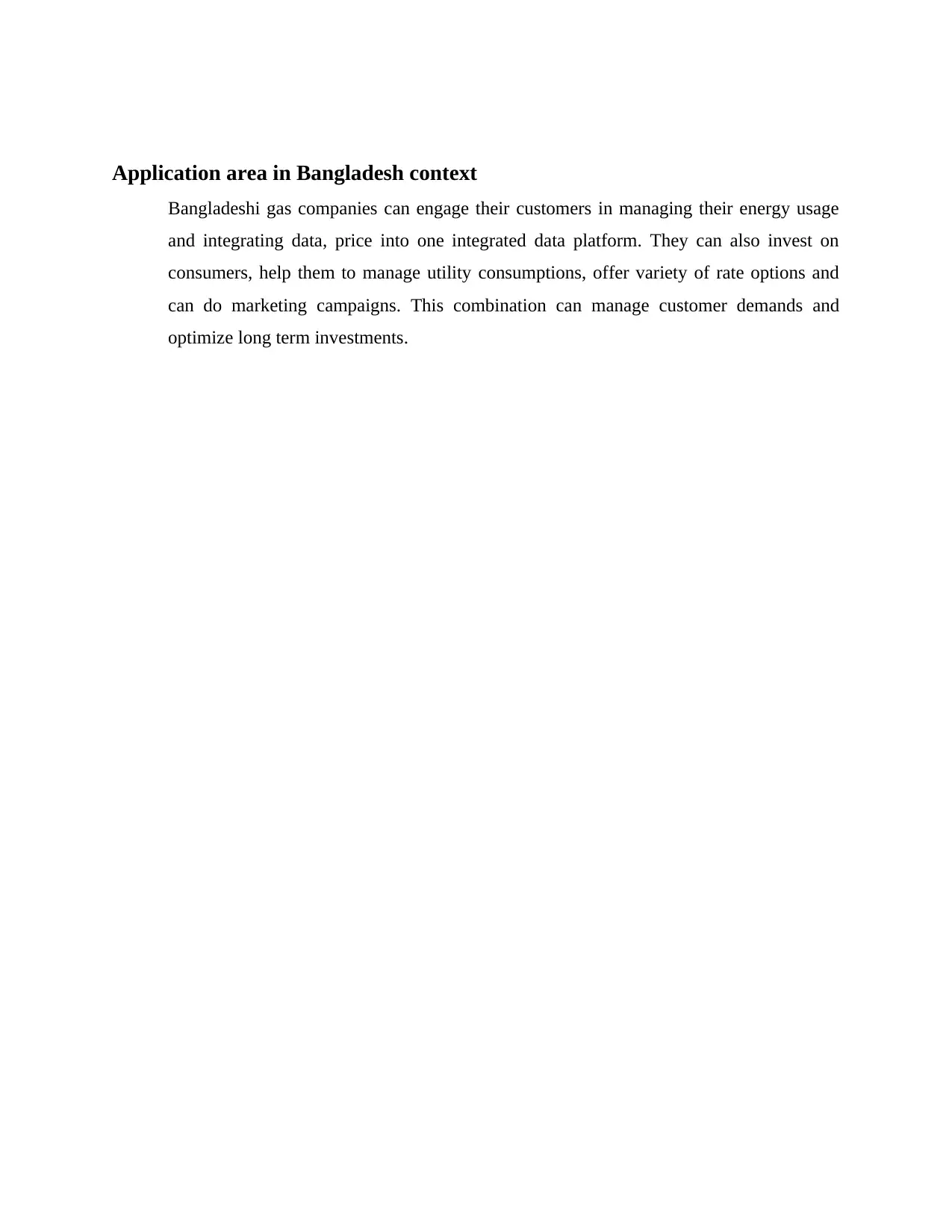
Application area in Bangladesh context
Bangladeshi gas companies can engage their customers in managing their energy usage
and integrating data, price into one integrated data platform. They can also invest on
consumers, help them to manage utility consumptions, offer variety of rate options and
can do marketing campaigns. This combination can manage customer demands and
optimize long term investments.
Bangladeshi gas companies can engage their customers in managing their energy usage
and integrating data, price into one integrated data platform. They can also invest on
consumers, help them to manage utility consumptions, offer variety of rate options and
can do marketing campaigns. This combination can manage customer demands and
optimize long term investments.
Secure Best Marks with AI Grader
Need help grading? Try our AI Grader for instant feedback on your assignments.
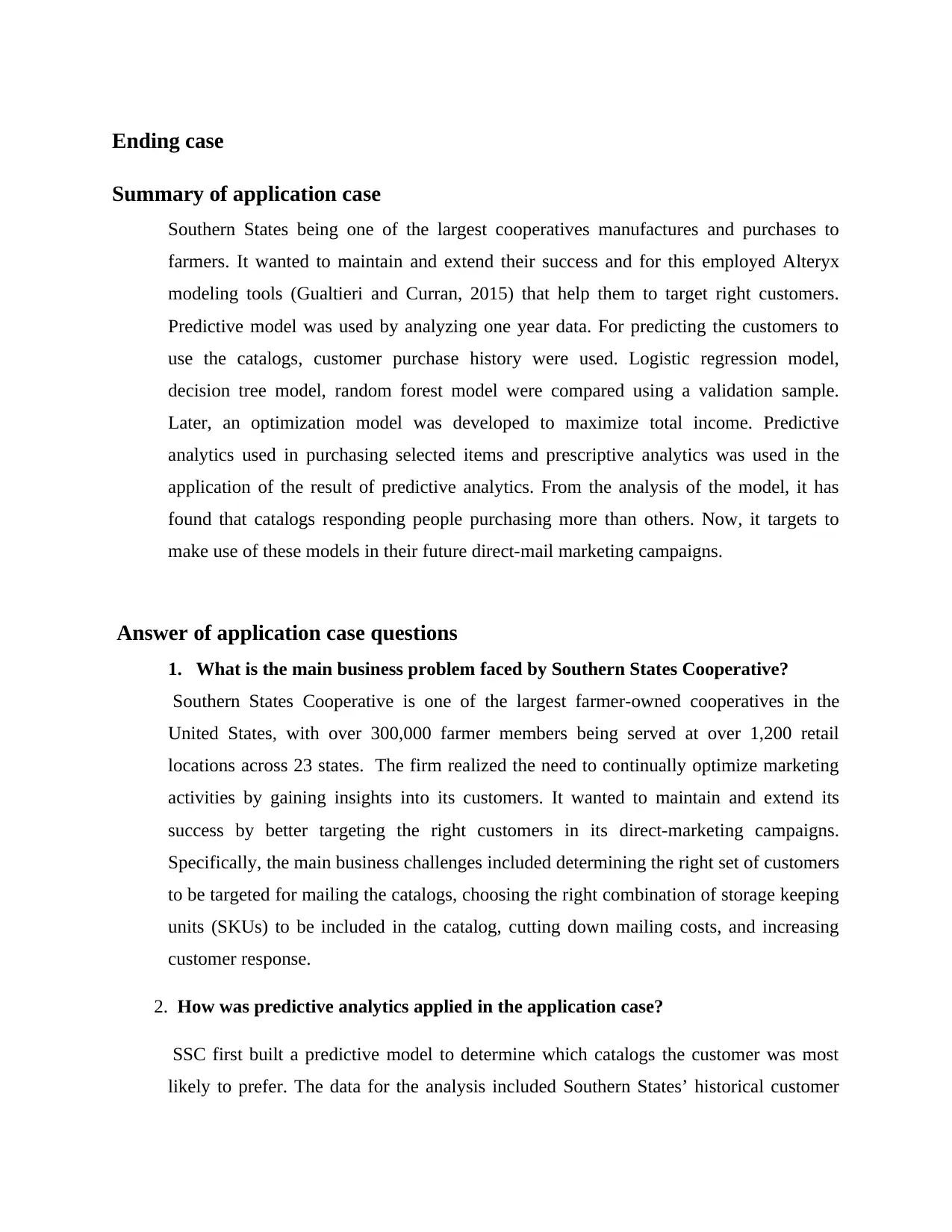
Ending case
Summary of application case
Southern States being one of the largest cooperatives manufactures and purchases to
farmers. It wanted to maintain and extend their success and for this employed Alteryx
modeling tools (Gualtieri and Curran, 2015) that help them to target right customers.
Predictive model was used by analyzing one year data. For predicting the customers to
use the catalogs, customer purchase history were used. Logistic regression model,
decision tree model, random forest model were compared using a validation sample.
Later, an optimization model was developed to maximize total income. Predictive
analytics used in purchasing selected items and prescriptive analytics was used in the
application of the result of predictive analytics. From the analysis of the model, it has
found that catalogs responding people purchasing more than others. Now, it targets to
make use of these models in their future direct-mail marketing campaigns.
Answer of application case questions
1. What is the main business problem faced by Southern States Cooperative?
Southern States Cooperative is one of the largest farmer-owned cooperatives in the
United States, with over 300,000 farmer members being served at over 1,200 retail
locations across 23 states. The firm realized the need to continually optimize marketing
activities by gaining insights into its customers. It wanted to maintain and extend its
success by better targeting the right customers in its direct-marketing campaigns.
Specifically, the main business challenges included determining the right set of customers
to be targeted for mailing the catalogs, choosing the right combination of storage keeping
units (SKUs) to be included in the catalog, cutting down mailing costs, and increasing
customer response.
2. How was predictive analytics applied in the application case?
SSC first built a predictive model to determine which catalogs the customer was most
likely to prefer. The data for the analysis included Southern States’ historical customer
Summary of application case
Southern States being one of the largest cooperatives manufactures and purchases to
farmers. It wanted to maintain and extend their success and for this employed Alteryx
modeling tools (Gualtieri and Curran, 2015) that help them to target right customers.
Predictive model was used by analyzing one year data. For predicting the customers to
use the catalogs, customer purchase history were used. Logistic regression model,
decision tree model, random forest model were compared using a validation sample.
Later, an optimization model was developed to maximize total income. Predictive
analytics used in purchasing selected items and prescriptive analytics was used in the
application of the result of predictive analytics. From the analysis of the model, it has
found that catalogs responding people purchasing more than others. Now, it targets to
make use of these models in their future direct-mail marketing campaigns.
Answer of application case questions
1. What is the main business problem faced by Southern States Cooperative?
Southern States Cooperative is one of the largest farmer-owned cooperatives in the
United States, with over 300,000 farmer members being served at over 1,200 retail
locations across 23 states. The firm realized the need to continually optimize marketing
activities by gaining insights into its customers. It wanted to maintain and extend its
success by better targeting the right customers in its direct-marketing campaigns.
Specifically, the main business challenges included determining the right set of customers
to be targeted for mailing the catalogs, choosing the right combination of storage keeping
units (SKUs) to be included in the catalog, cutting down mailing costs, and increasing
customer response.
2. How was predictive analytics applied in the application case?
SSC first built a predictive model to determine which catalogs the customer was most
likely to prefer. The data for the analysis included Southern States’ historical customer
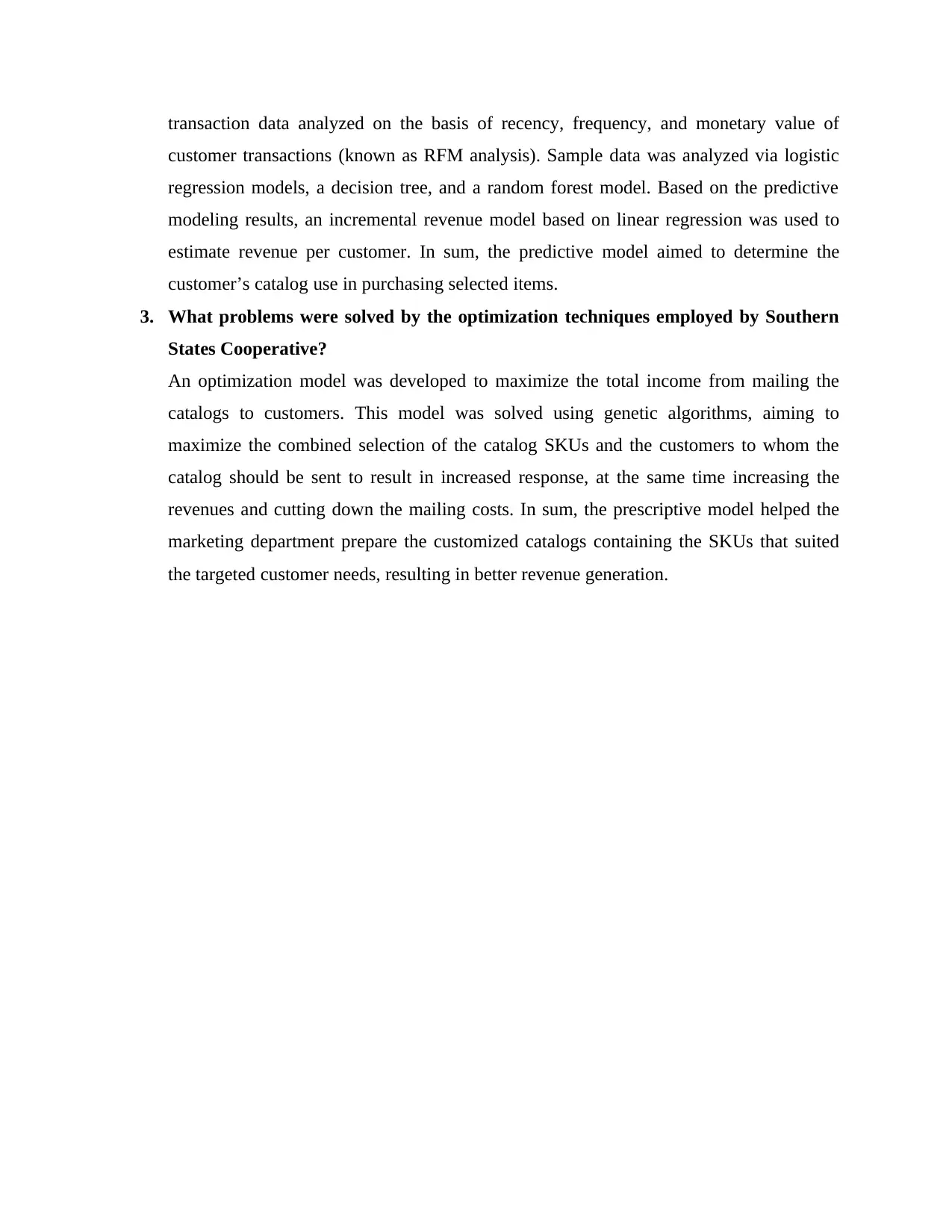
transaction data analyzed on the basis of recency, frequency, and monetary value of
customer transactions (known as RFM analysis). Sample data was analyzed via logistic
regression models, a decision tree, and a random forest model. Based on the predictive
modeling results, an incremental revenue model based on linear regression was used to
estimate revenue per customer. In sum, the predictive model aimed to determine the
customer’s catalog use in purchasing selected items.
3. What problems were solved by the optimization techniques employed by Southern
States Cooperative?
An optimization model was developed to maximize the total income from mailing the
catalogs to customers. This model was solved using genetic algorithms, aiming to
maximize the combined selection of the catalog SKUs and the customers to whom the
catalog should be sent to result in increased response, at the same time increasing the
revenues and cutting down the mailing costs. In sum, the prescriptive model helped the
marketing department prepare the customized catalogs containing the SKUs that suited
the targeted customer needs, resulting in better revenue generation.
customer transactions (known as RFM analysis). Sample data was analyzed via logistic
regression models, a decision tree, and a random forest model. Based on the predictive
modeling results, an incremental revenue model based on linear regression was used to
estimate revenue per customer. In sum, the predictive model aimed to determine the
customer’s catalog use in purchasing selected items.
3. What problems were solved by the optimization techniques employed by Southern
States Cooperative?
An optimization model was developed to maximize the total income from mailing the
catalogs to customers. This model was solved using genetic algorithms, aiming to
maximize the combined selection of the catalog SKUs and the customers to whom the
catalog should be sent to result in increased response, at the same time increasing the
revenues and cutting down the mailing costs. In sum, the prescriptive model helped the
marketing department prepare the customized catalogs containing the SKUs that suited
the targeted customer needs, resulting in better revenue generation.
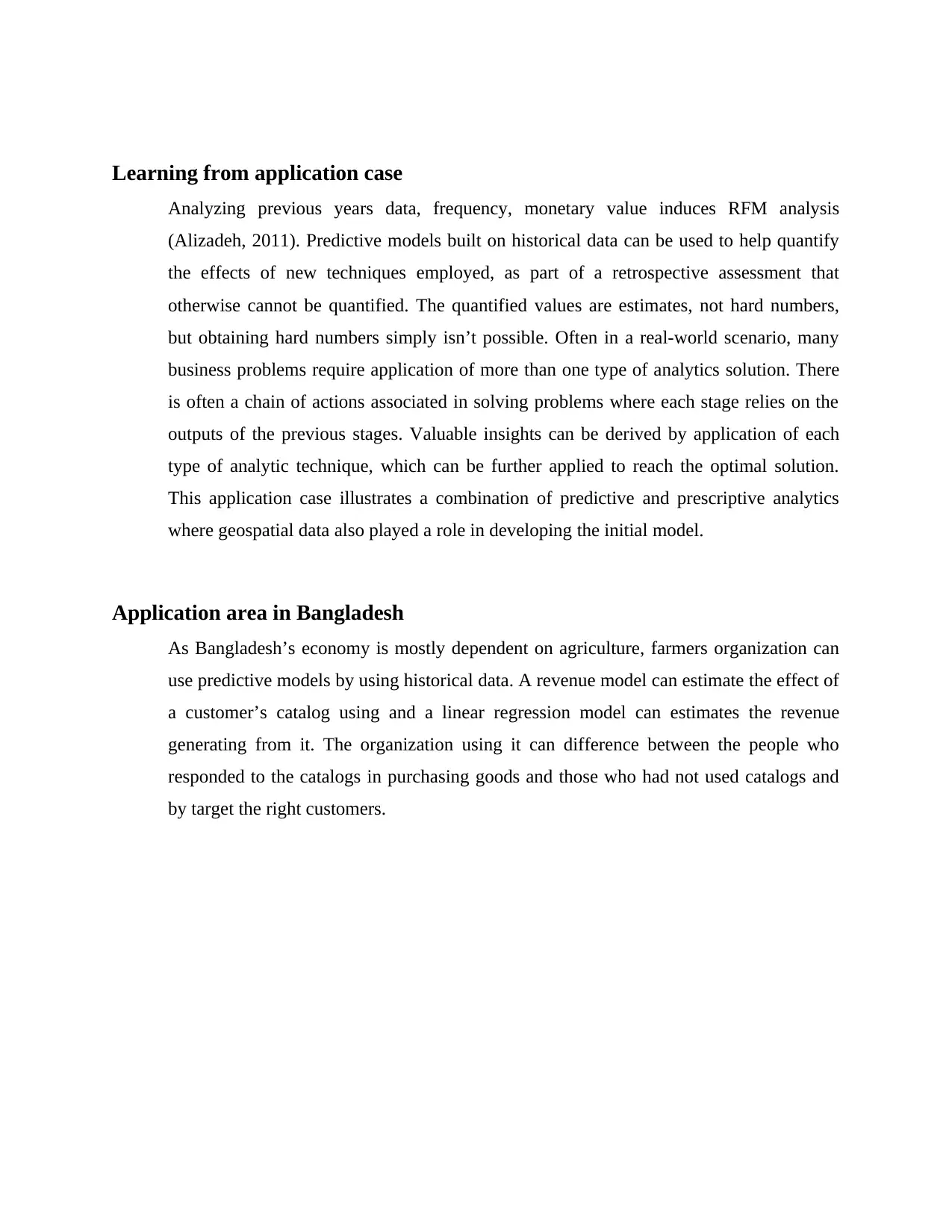
Learning from application case
Analyzing previous years data, frequency, monetary value induces RFM analysis
(Alizadeh, 2011). Predictive models built on historical data can be used to help quantify
the effects of new techniques employed, as part of a retrospective assessment that
otherwise cannot be quantified. The quantified values are estimates, not hard numbers,
but obtaining hard numbers simply isn’t possible. Often in a real-world scenario, many
business problems require application of more than one type of analytics solution. There
is often a chain of actions associated in solving problems where each stage relies on the
outputs of the previous stages. Valuable insights can be derived by application of each
type of analytic technique, which can be further applied to reach the optimal solution.
This application case illustrates a combination of predictive and prescriptive analytics
where geospatial data also played a role in developing the initial model.
Application area in Bangladesh
As Bangladesh’s economy is mostly dependent on agriculture, farmers organization can
use predictive models by using historical data. A revenue model can estimate the effect of
a customer’s catalog using and a linear regression model can estimates the revenue
generating from it. The organization using it can difference between the people who
responded to the catalogs in purchasing goods and those who had not used catalogs and
by target the right customers.
Analyzing previous years data, frequency, monetary value induces RFM analysis
(Alizadeh, 2011). Predictive models built on historical data can be used to help quantify
the effects of new techniques employed, as part of a retrospective assessment that
otherwise cannot be quantified. The quantified values are estimates, not hard numbers,
but obtaining hard numbers simply isn’t possible. Often in a real-world scenario, many
business problems require application of more than one type of analytics solution. There
is often a chain of actions associated in solving problems where each stage relies on the
outputs of the previous stages. Valuable insights can be derived by application of each
type of analytic technique, which can be further applied to reach the optimal solution.
This application case illustrates a combination of predictive and prescriptive analytics
where geospatial data also played a role in developing the initial model.
Application area in Bangladesh
As Bangladesh’s economy is mostly dependent on agriculture, farmers organization can
use predictive models by using historical data. A revenue model can estimate the effect of
a customer’s catalog using and a linear regression model can estimates the revenue
generating from it. The organization using it can difference between the people who
responded to the catalogs in purchasing goods and those who had not used catalogs and
by target the right customers.
Paraphrase This Document
Need a fresh take? Get an instant paraphrase of this document with our AI Paraphraser

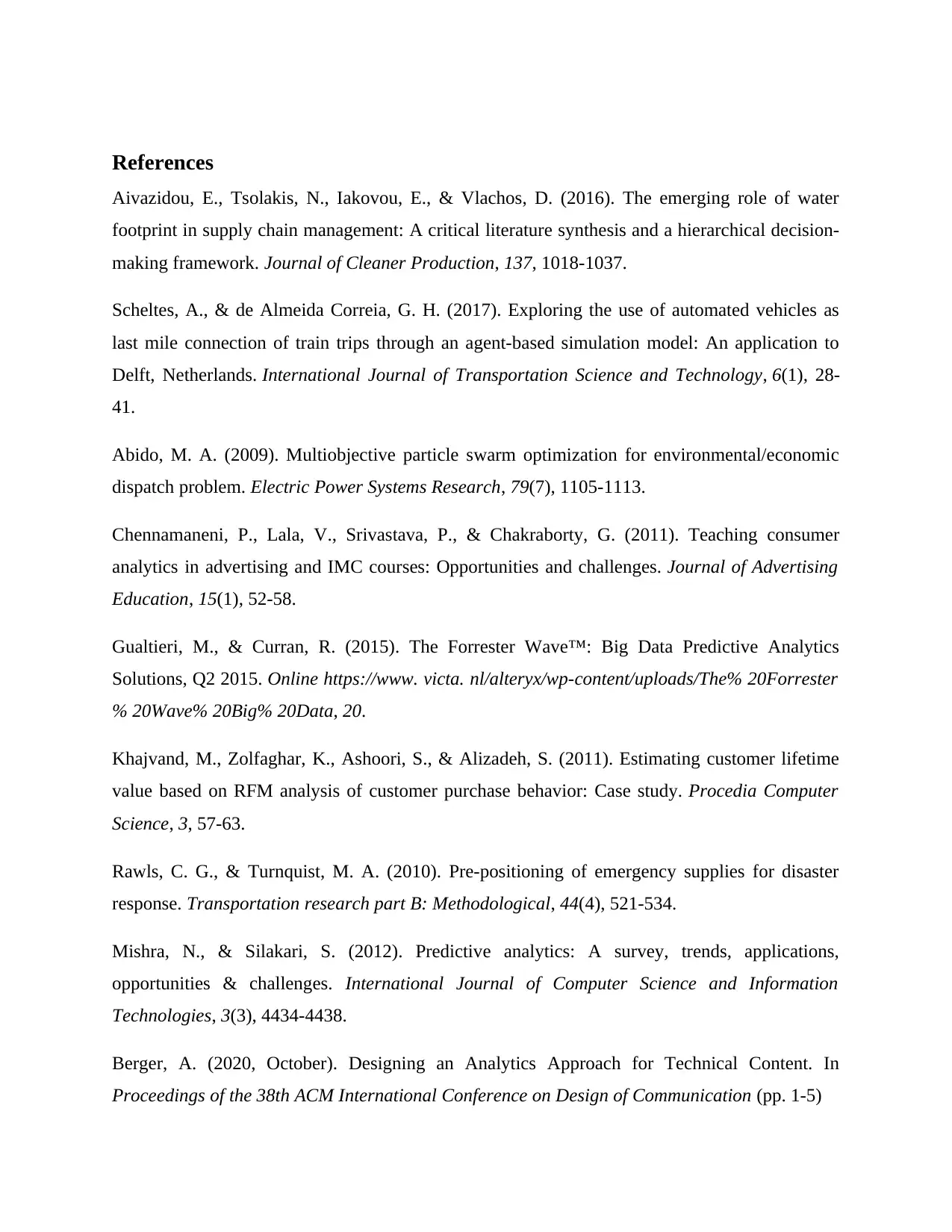
References
Aivazidou, E., Tsolakis, N., Iakovou, E., & Vlachos, D. (2016). The emerging role of water
footprint in supply chain management: A critical literature synthesis and a hierarchical decision-
making framework. Journal of Cleaner Production, 137, 1018-1037.
Scheltes, A., & de Almeida Correia, G. H. (2017). Exploring the use of automated vehicles as
last mile connection of train trips through an agent-based simulation model: An application to
Delft, Netherlands. International Journal of Transportation Science and Technology, 6(1), 28-
41.
Abido, M. A. (2009). Multiobjective particle swarm optimization for environmental/economic
dispatch problem. Electric Power Systems Research, 79(7), 1105-1113.
Chennamaneni, P., Lala, V., Srivastava, P., & Chakraborty, G. (2011). Teaching consumer
analytics in advertising and IMC courses: Opportunities and challenges. Journal of Advertising
Education, 15(1), 52-58.
Gualtieri, M., & Curran, R. (2015). The Forrester Wave™: Big Data Predictive Analytics
Solutions, Q2 2015. Online https://www. victa. nl/alteryx/wp-content/uploads/The% 20Forrester
% 20Wave% 20Big% 20Data, 20.
Khajvand, M., Zolfaghar, K., Ashoori, S., & Alizadeh, S. (2011). Estimating customer lifetime
value based on RFM analysis of customer purchase behavior: Case study. Procedia Computer
Science, 3, 57-63.
Rawls, C. G., & Turnquist, M. A. (2010). Pre-positioning of emergency supplies for disaster
response. Transportation research part B: Methodological, 44(4), 521-534.
Mishra, N., & Silakari, S. (2012). Predictive analytics: A survey, trends, applications,
opportunities & challenges. International Journal of Computer Science and Information
Technologies, 3(3), 4434-4438.
Berger, A. (2020, October). Designing an Analytics Approach for Technical Content. In
Proceedings of the 38th ACM International Conference on Design of Communication (pp. 1-5)
Aivazidou, E., Tsolakis, N., Iakovou, E., & Vlachos, D. (2016). The emerging role of water
footprint in supply chain management: A critical literature synthesis and a hierarchical decision-
making framework. Journal of Cleaner Production, 137, 1018-1037.
Scheltes, A., & de Almeida Correia, G. H. (2017). Exploring the use of automated vehicles as
last mile connection of train trips through an agent-based simulation model: An application to
Delft, Netherlands. International Journal of Transportation Science and Technology, 6(1), 28-
41.
Abido, M. A. (2009). Multiobjective particle swarm optimization for environmental/economic
dispatch problem. Electric Power Systems Research, 79(7), 1105-1113.
Chennamaneni, P., Lala, V., Srivastava, P., & Chakraborty, G. (2011). Teaching consumer
analytics in advertising and IMC courses: Opportunities and challenges. Journal of Advertising
Education, 15(1), 52-58.
Gualtieri, M., & Curran, R. (2015). The Forrester Wave™: Big Data Predictive Analytics
Solutions, Q2 2015. Online https://www. victa. nl/alteryx/wp-content/uploads/The% 20Forrester
% 20Wave% 20Big% 20Data, 20.
Khajvand, M., Zolfaghar, K., Ashoori, S., & Alizadeh, S. (2011). Estimating customer lifetime
value based on RFM analysis of customer purchase behavior: Case study. Procedia Computer
Science, 3, 57-63.
Rawls, C. G., & Turnquist, M. A. (2010). Pre-positioning of emergency supplies for disaster
response. Transportation research part B: Methodological, 44(4), 521-534.
Mishra, N., & Silakari, S. (2012). Predictive analytics: A survey, trends, applications,
opportunities & challenges. International Journal of Computer Science and Information
Technologies, 3(3), 4434-4438.
Berger, A. (2020, October). Designing an Analytics Approach for Technical Content. In
Proceedings of the 38th ACM International Conference on Design of Communication (pp. 1-5)
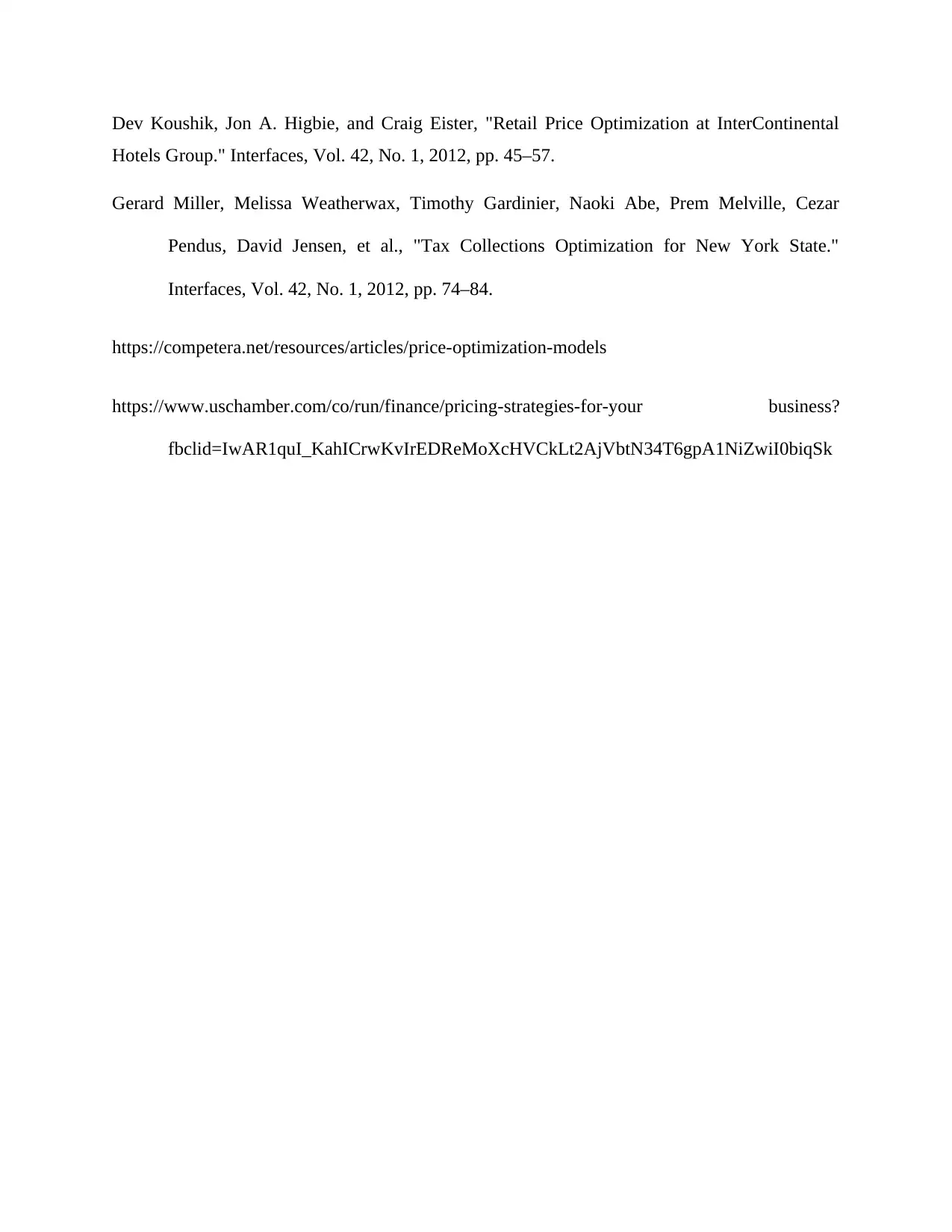
Dev Koushik, Jon A. Higbie, and Craig Eister, "Retail Price Optimization at InterContinental
Hotels Group." Interfaces, Vol. 42, No. 1, 2012, pp. 45–57.
Gerard Miller, Melissa Weatherwax, Timothy Gardinier, Naoki Abe, Prem Melville, Cezar
Pendus, David Jensen, et al., "Tax Collections Optimization for New York State."
Interfaces, Vol. 42, No. 1, 2012, pp. 74–84.
https://competera.net/resources/articles/price-optimization-models
https://www.uschamber.com/co/run/finance/pricing-strategies-for-your business?
fbclid=IwAR1quI_KahICrwKvIrEDReMoXcHVCkLt2AjVbtN34T6gpA1NiZwiI0biqSk
Hotels Group." Interfaces, Vol. 42, No. 1, 2012, pp. 45–57.
Gerard Miller, Melissa Weatherwax, Timothy Gardinier, Naoki Abe, Prem Melville, Cezar
Pendus, David Jensen, et al., "Tax Collections Optimization for New York State."
Interfaces, Vol. 42, No. 1, 2012, pp. 74–84.
https://competera.net/resources/articles/price-optimization-models
https://www.uschamber.com/co/run/finance/pricing-strategies-for-your business?
fbclid=IwAR1quI_KahICrwKvIrEDReMoXcHVCkLt2AjVbtN34T6gpA1NiZwiI0biqSk
Secure Best Marks with AI Grader
Need help grading? Try our AI Grader for instant feedback on your assignments.

1 out of 53
Your All-in-One AI-Powered Toolkit for Academic Success.
+13062052269
info@desklib.com
Available 24*7 on WhatsApp / Email
![[object Object]](/_next/static/media/star-bottom.7253800d.svg)
Unlock your academic potential
© 2024 | Zucol Services PVT LTD | All rights reserved.


